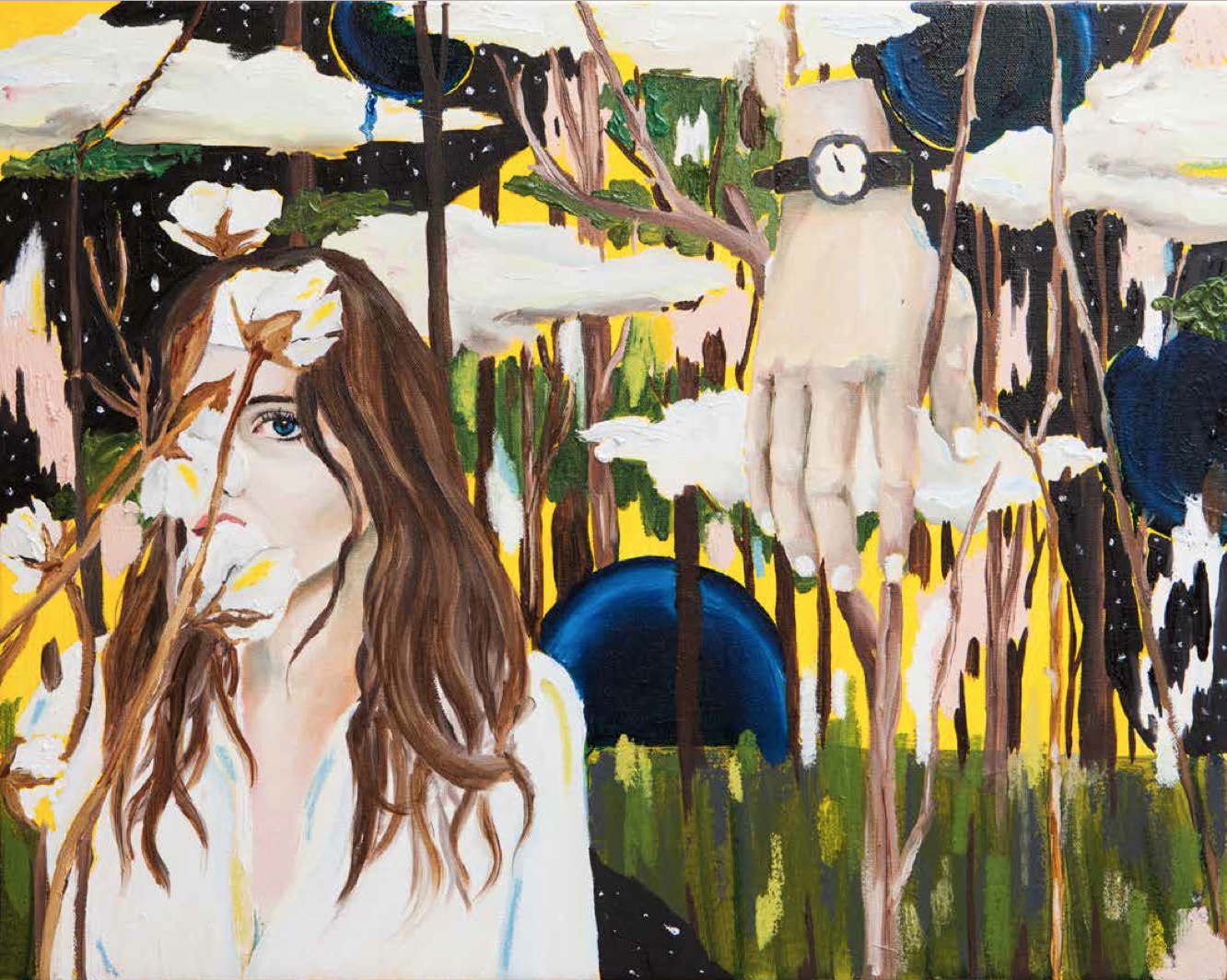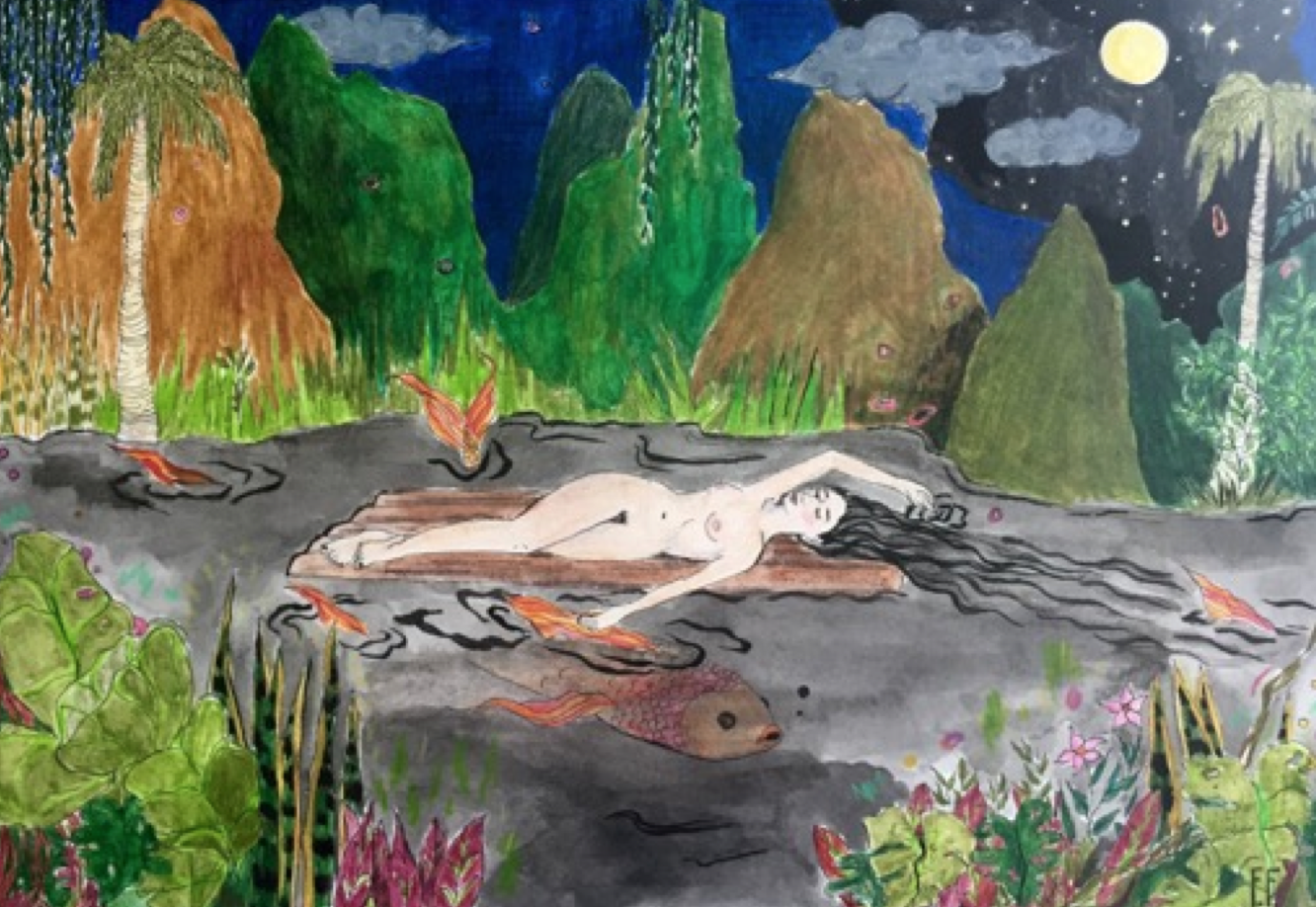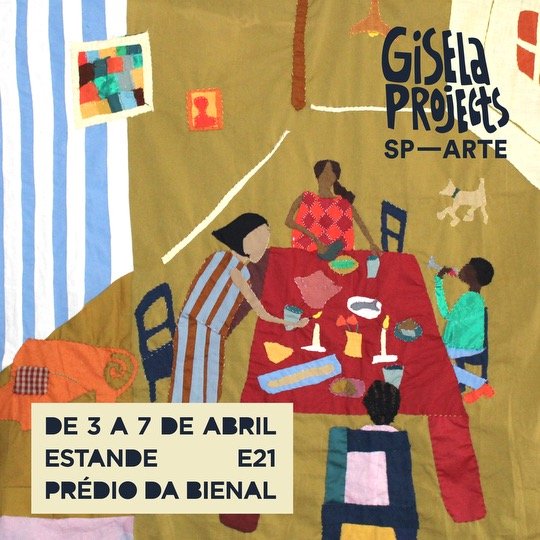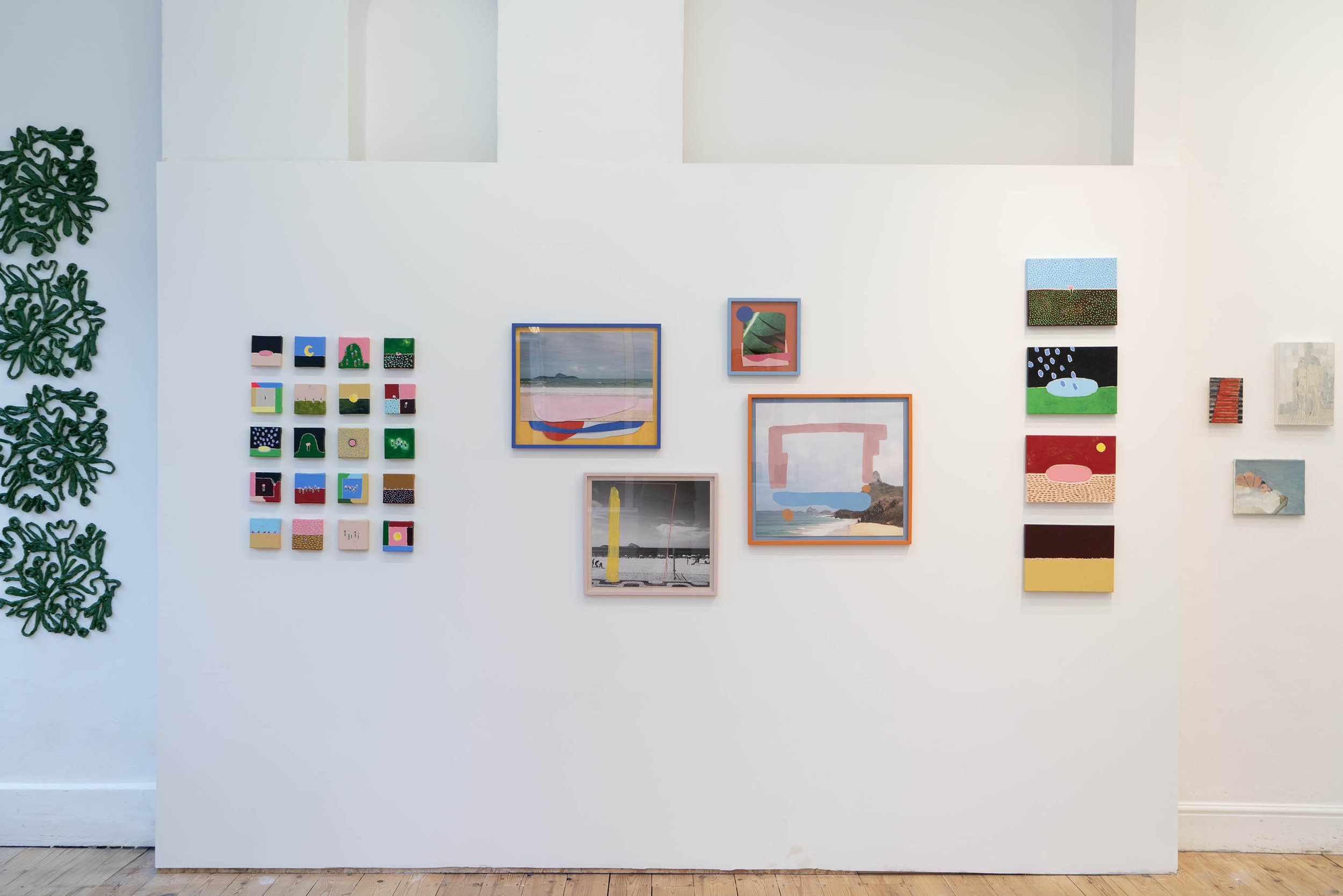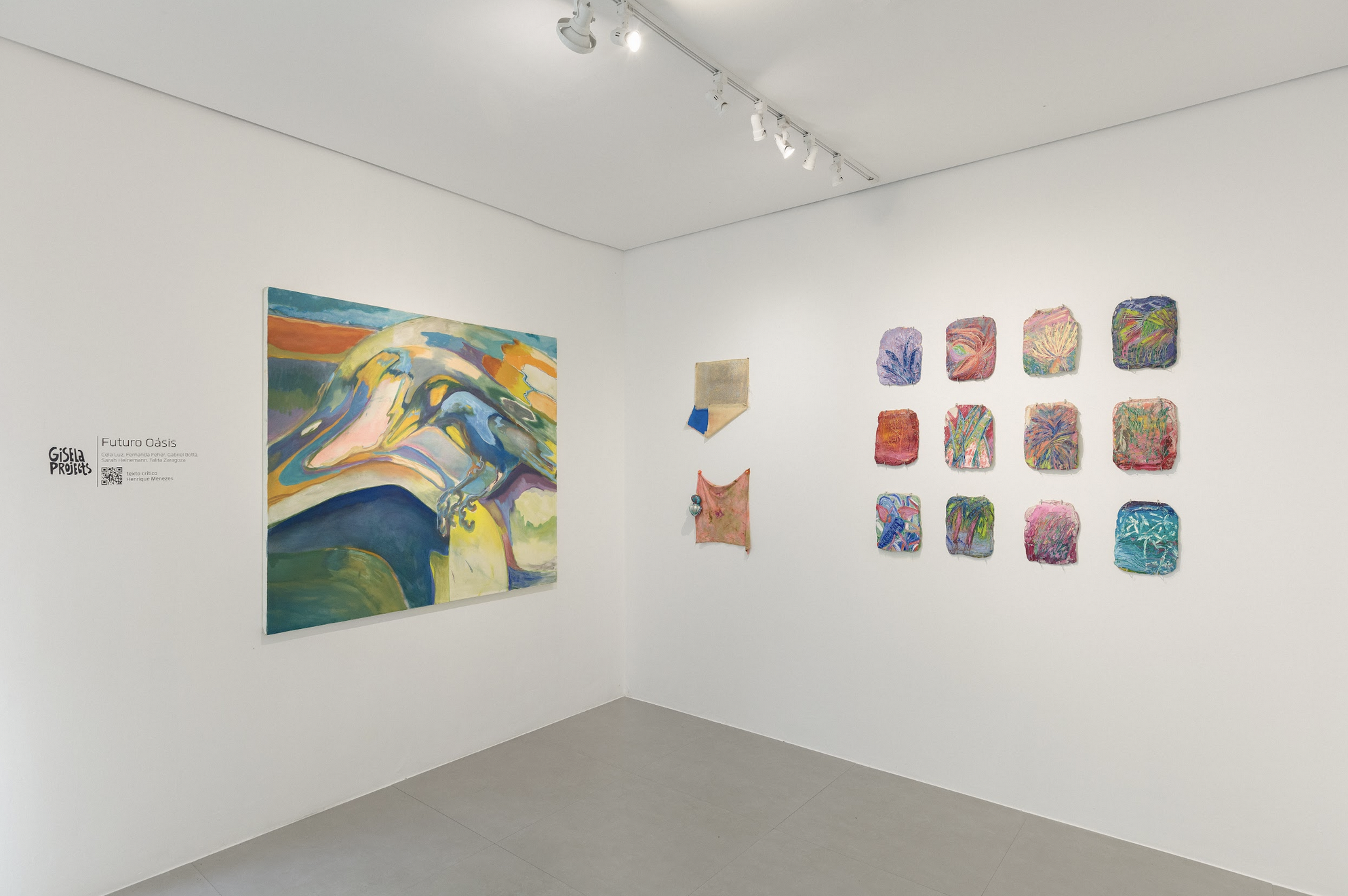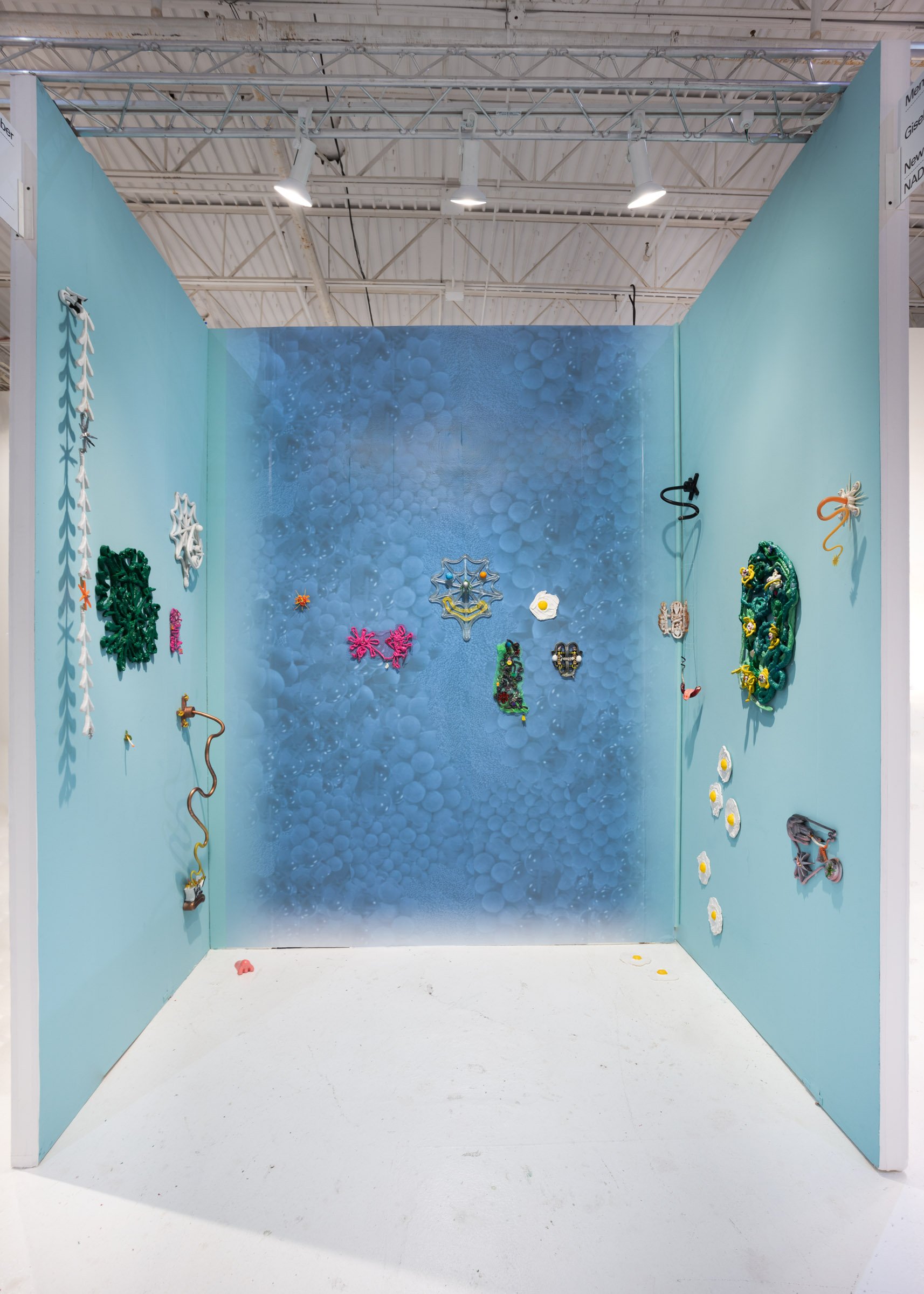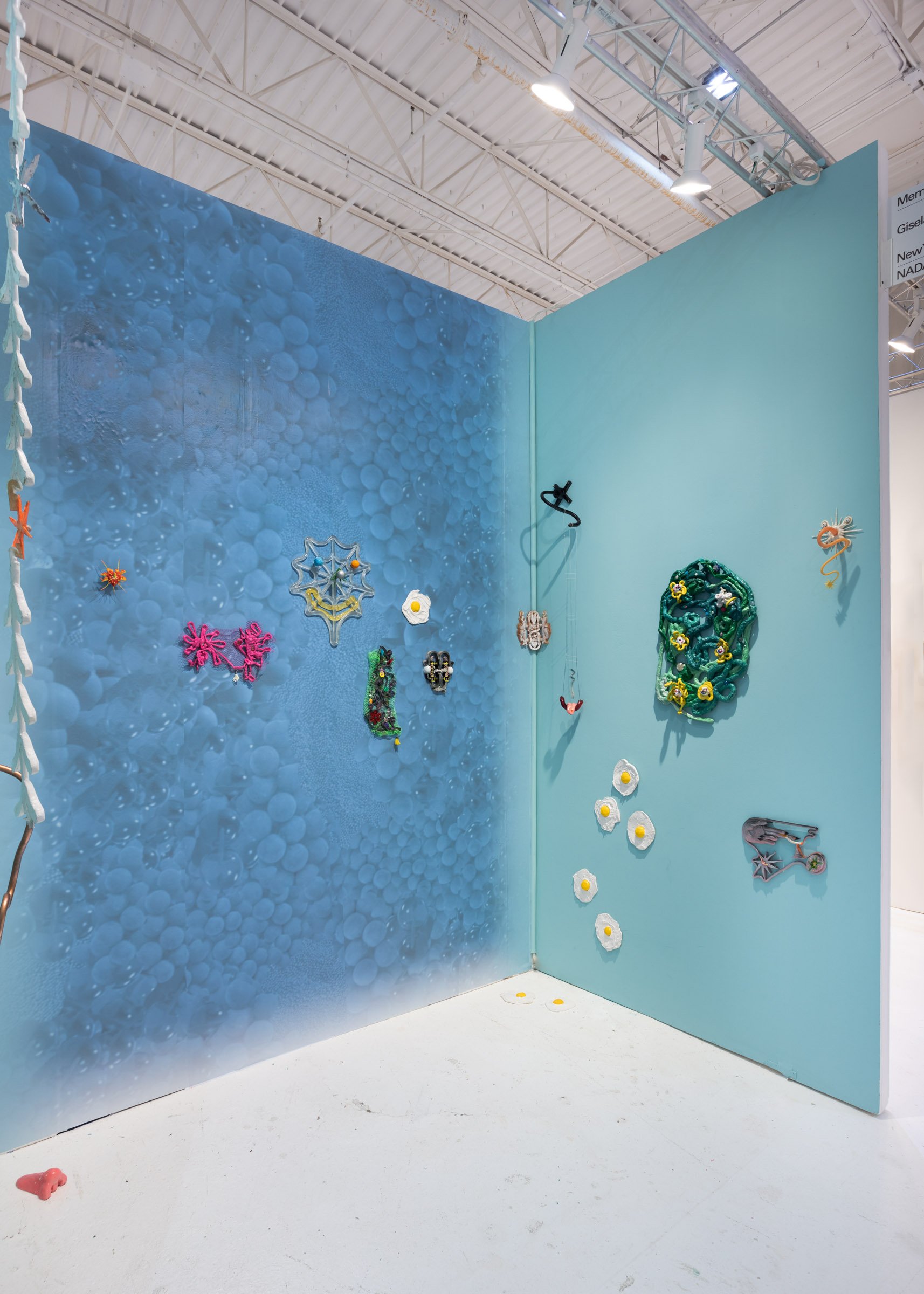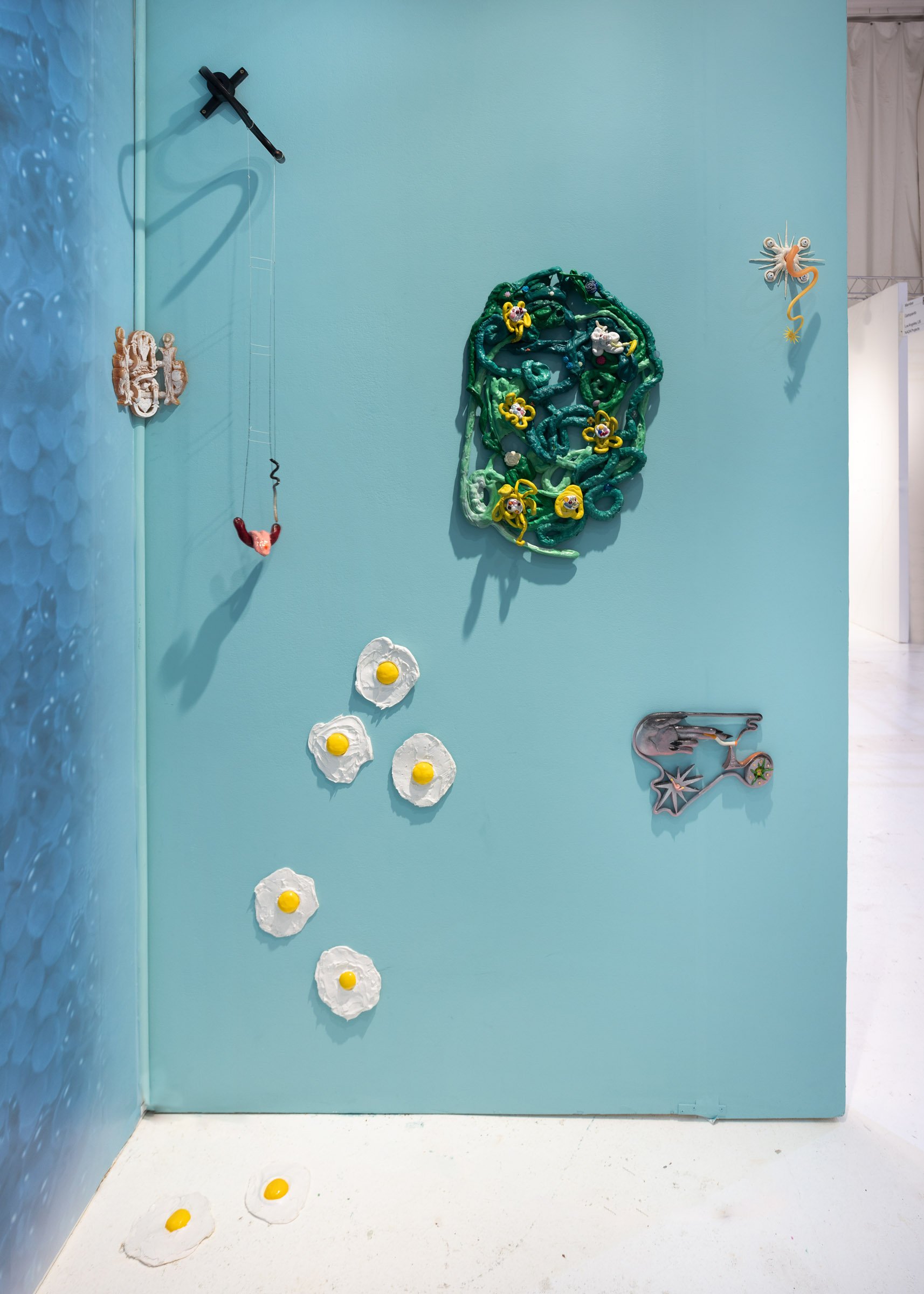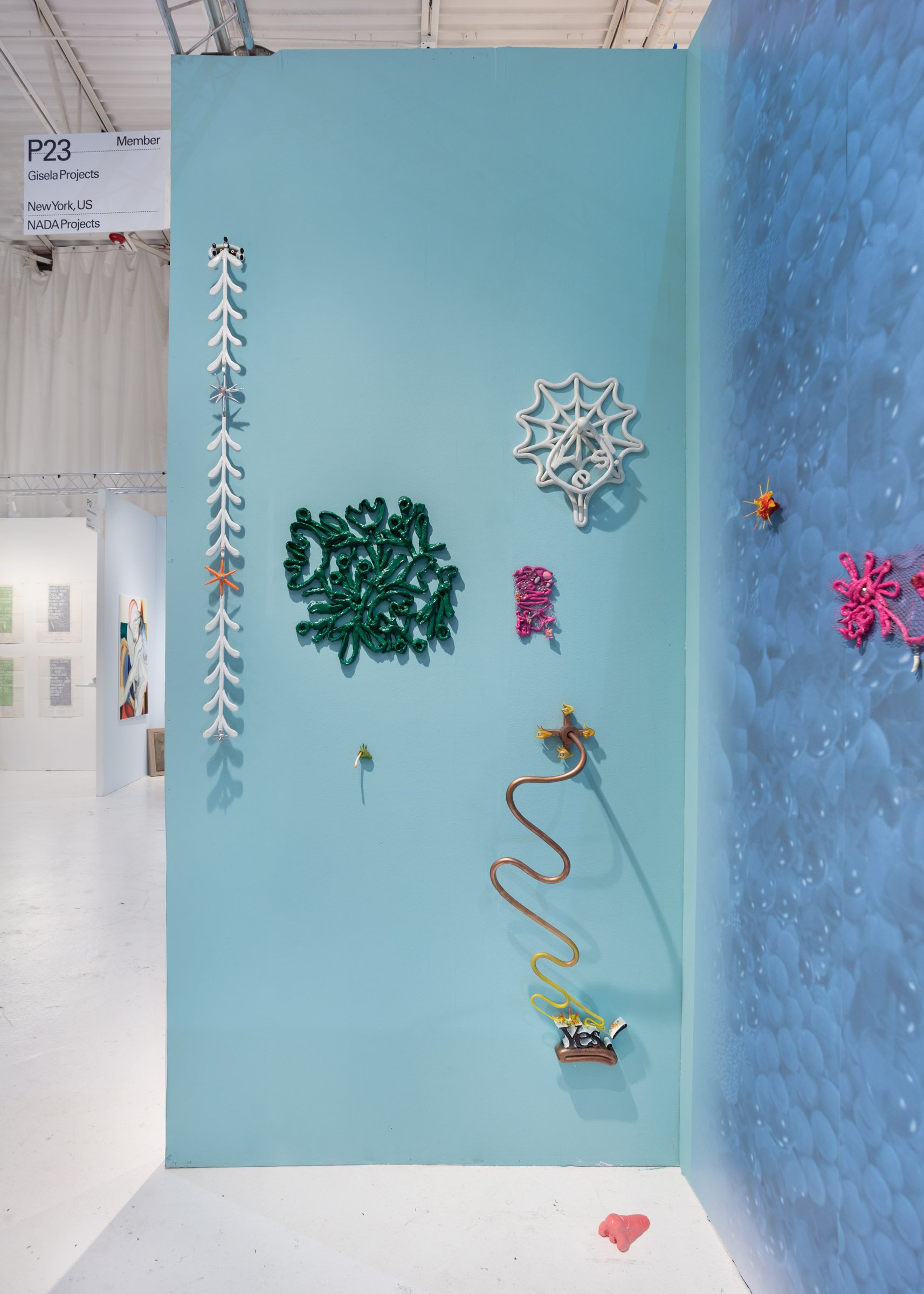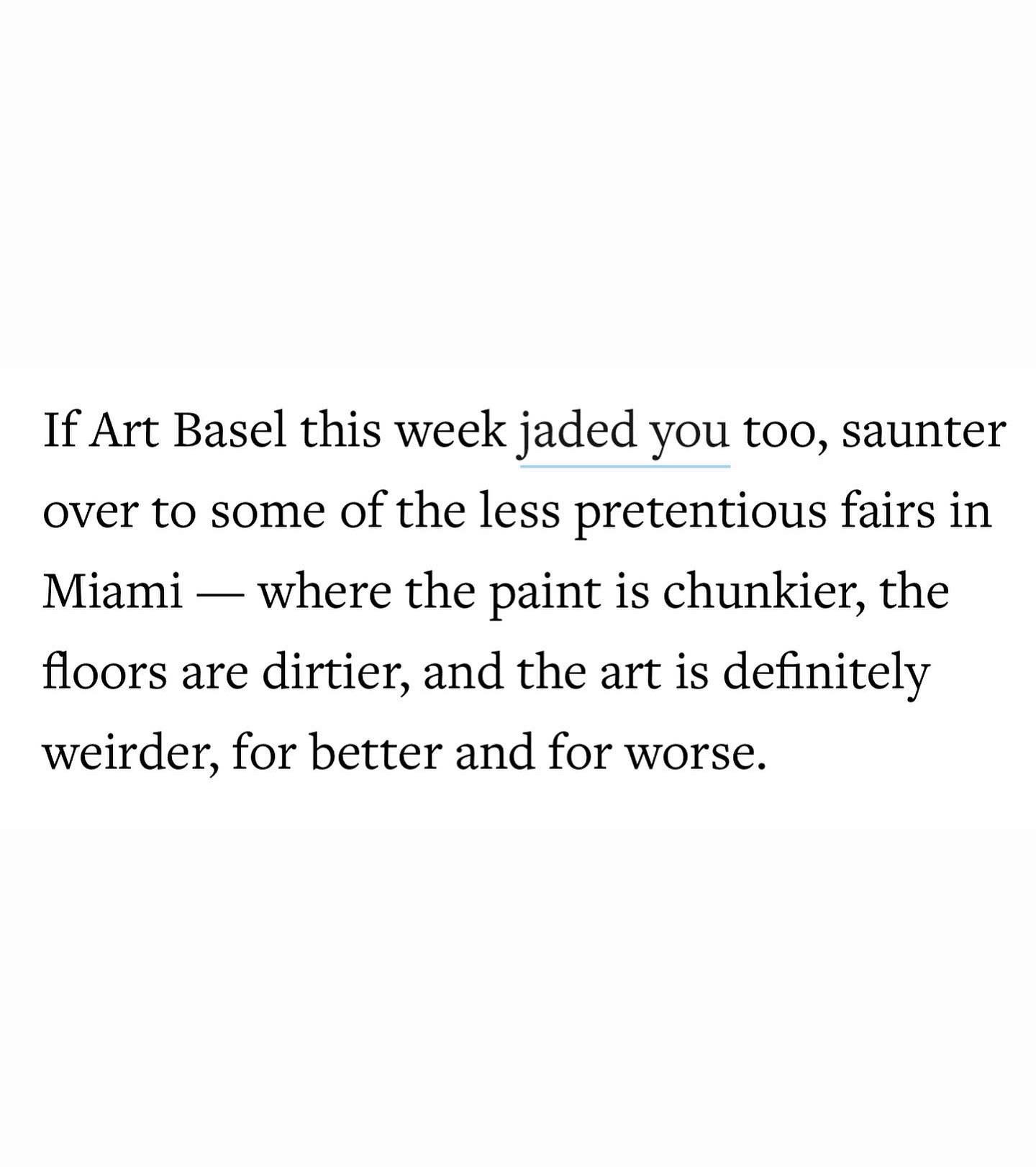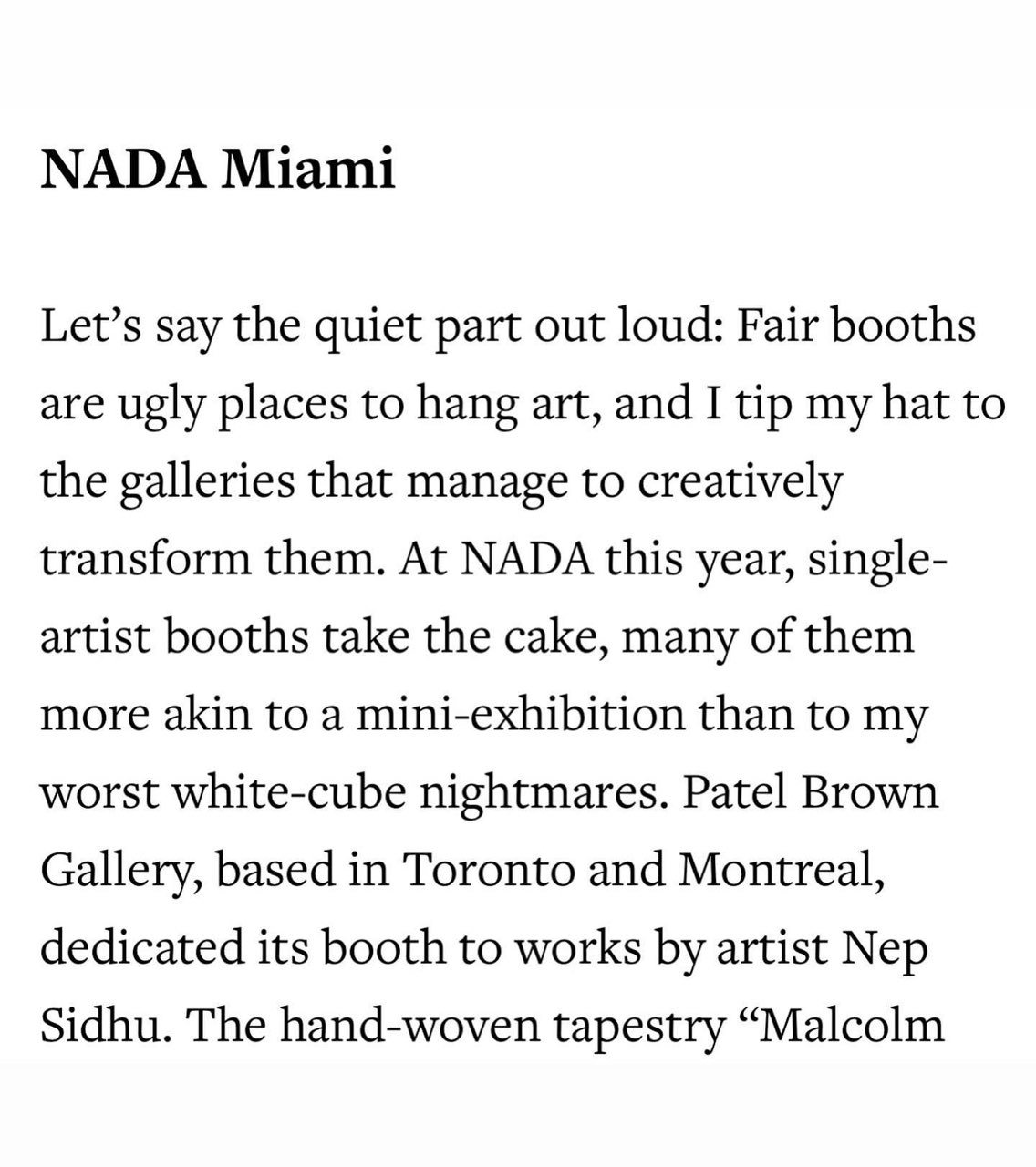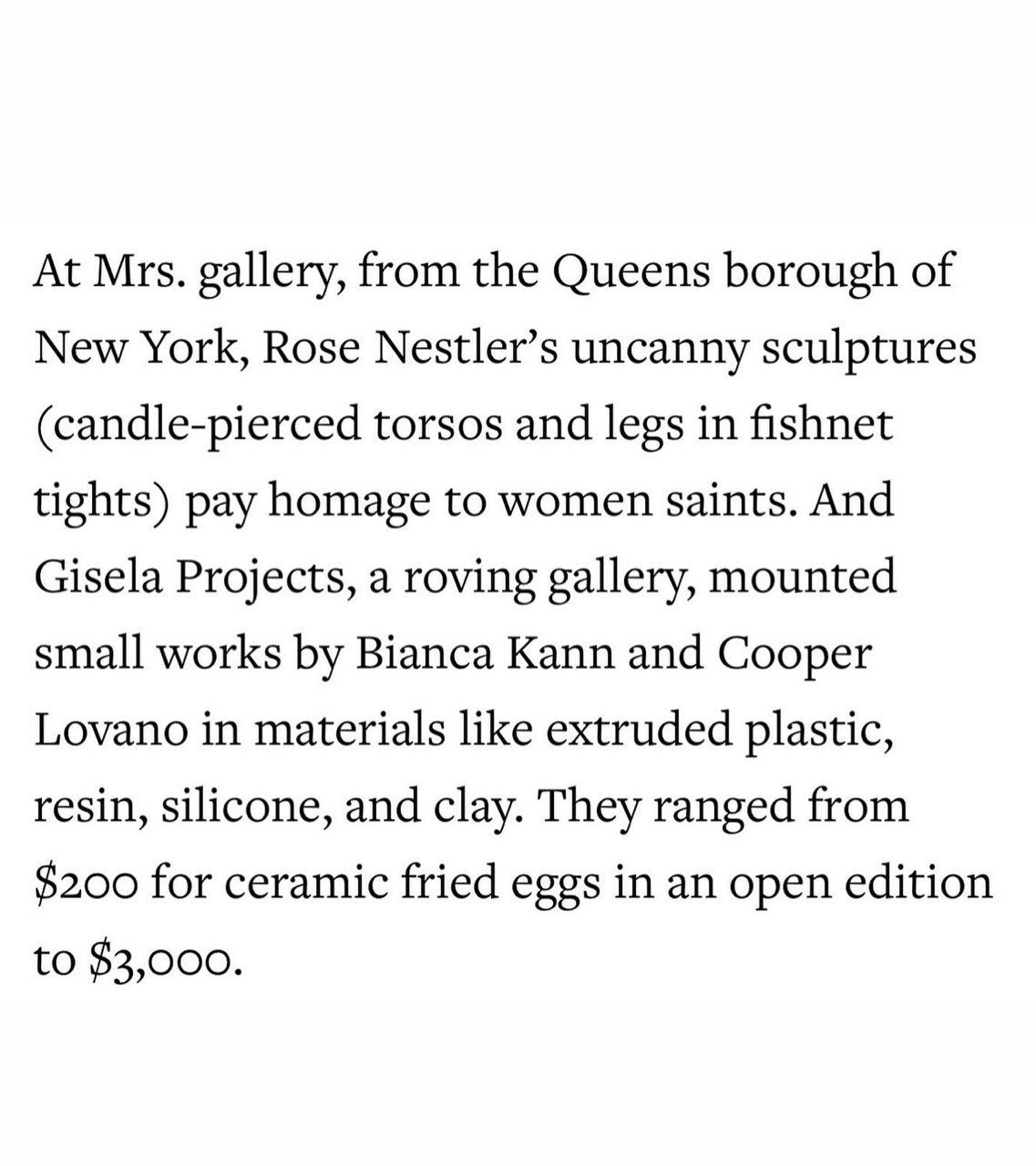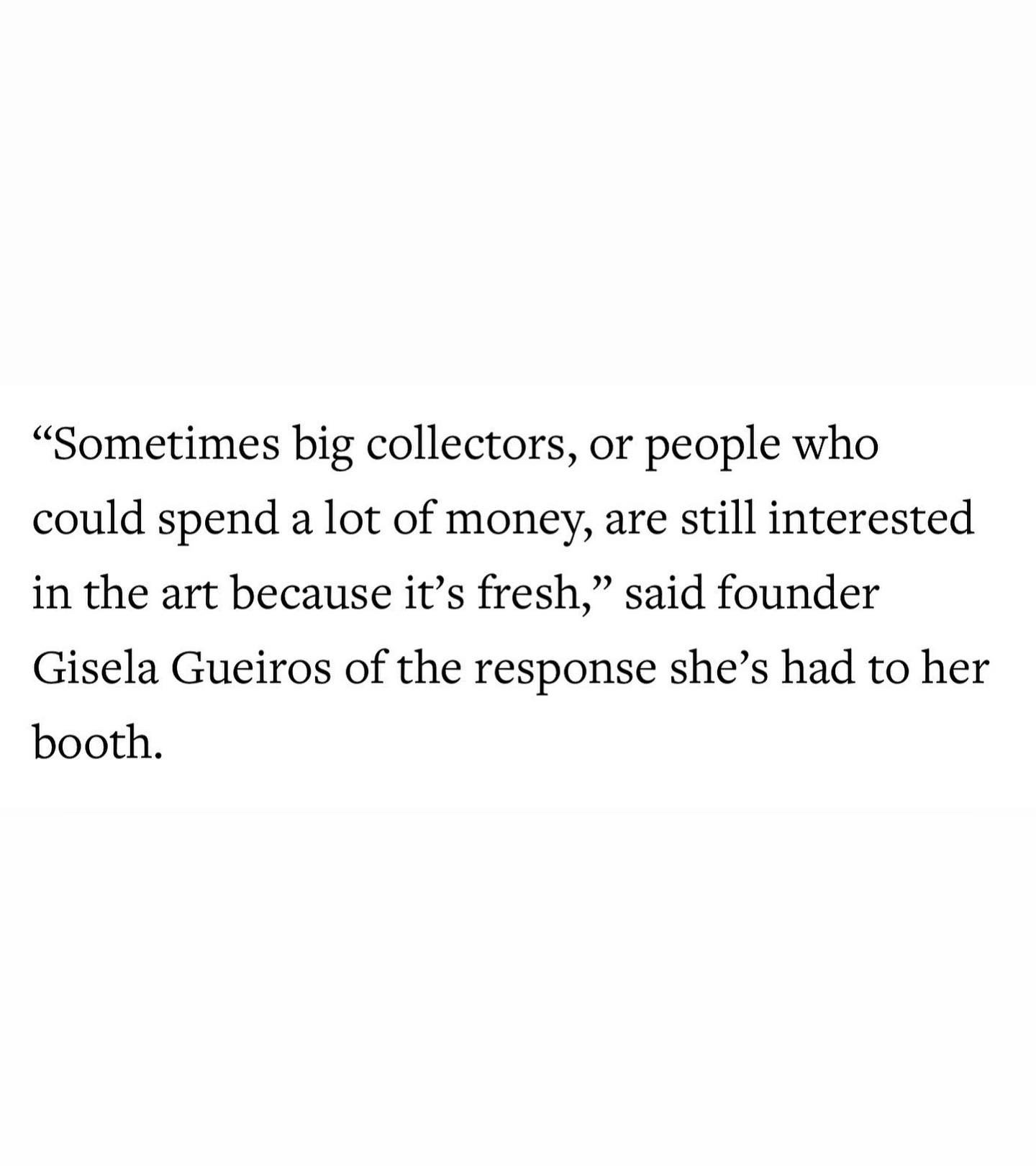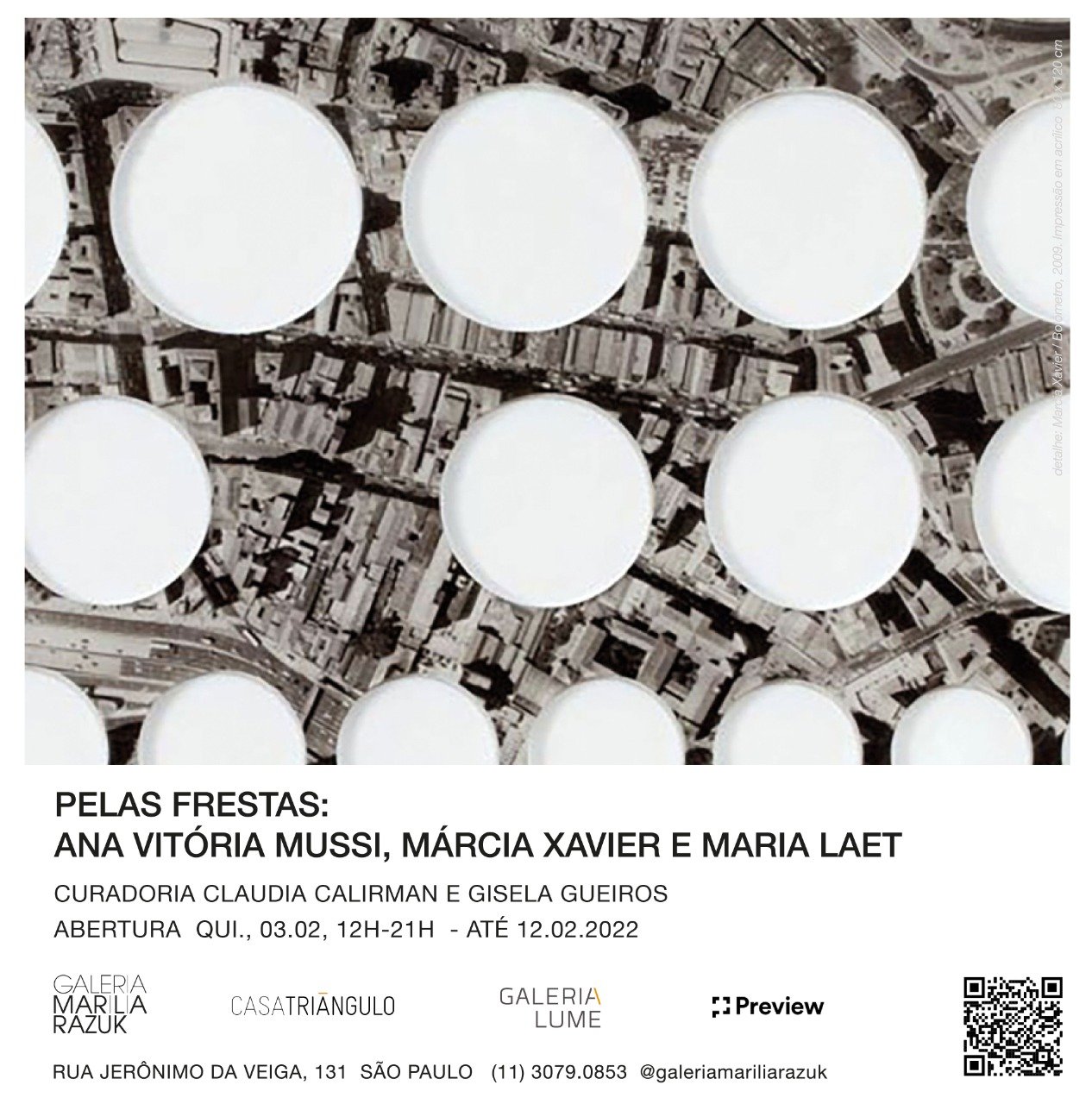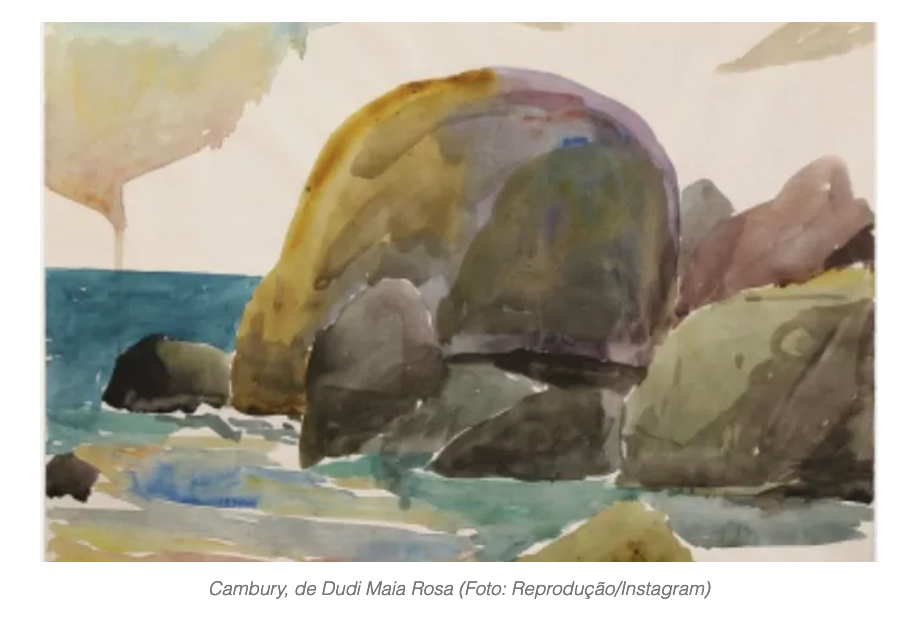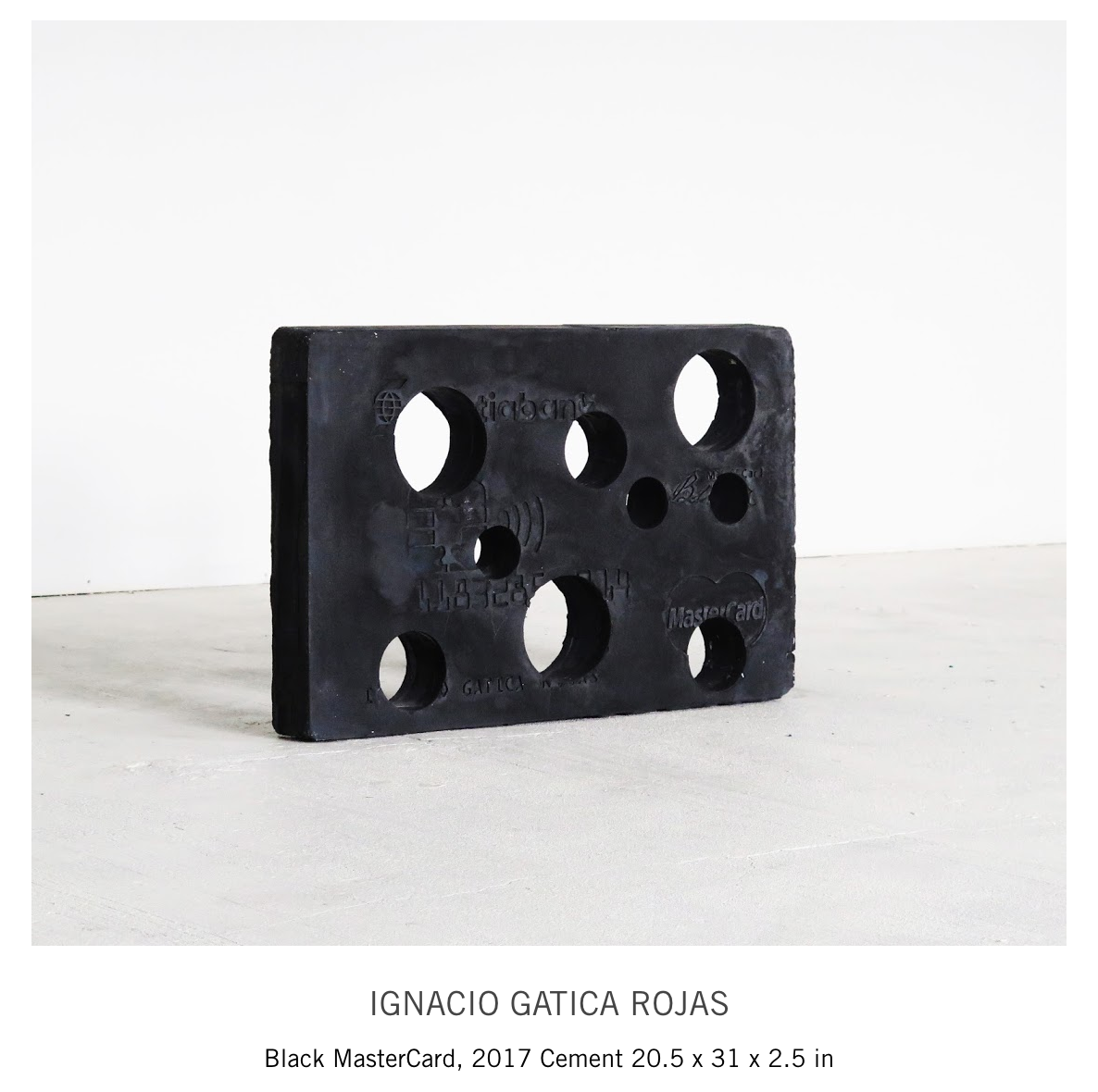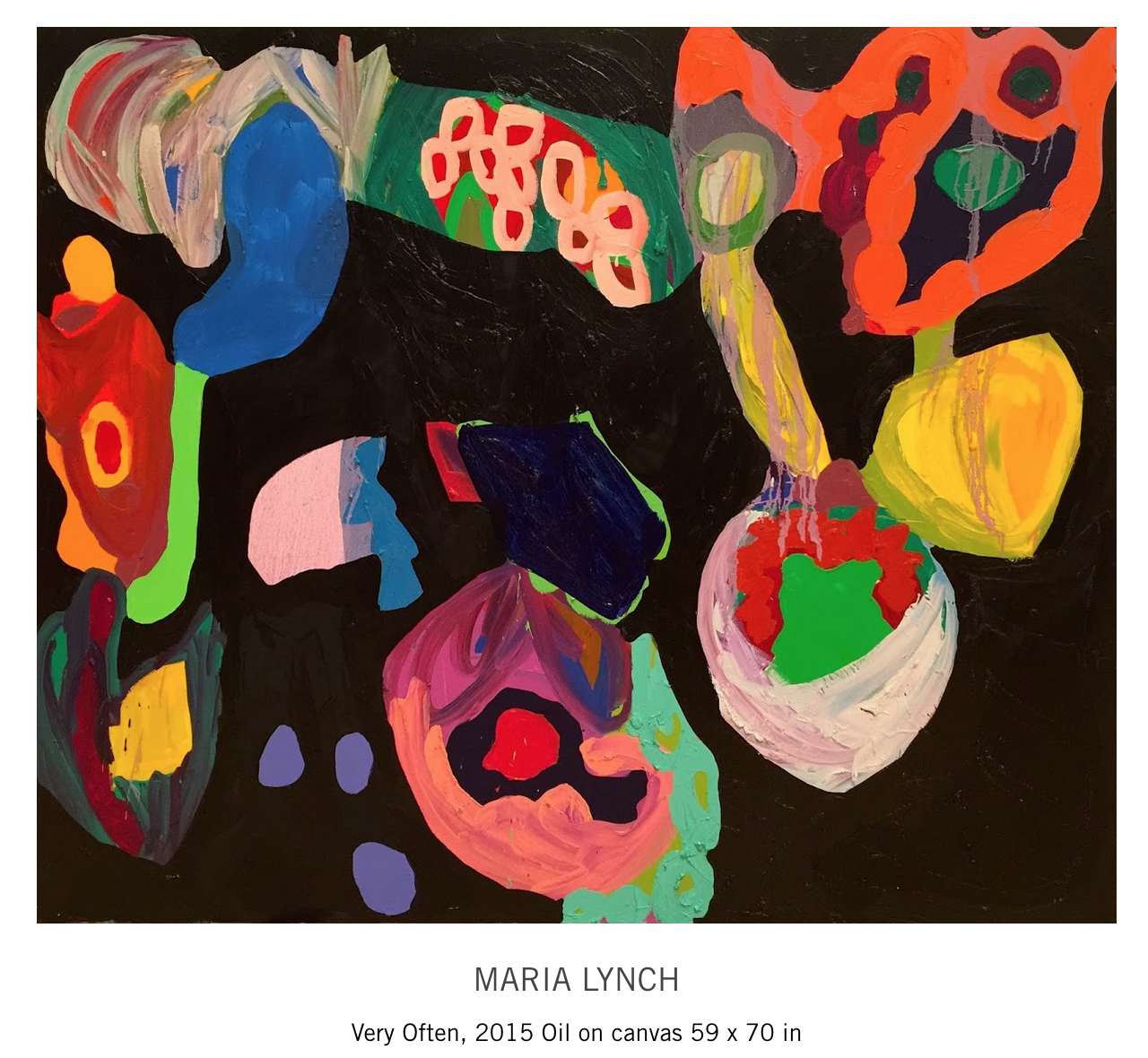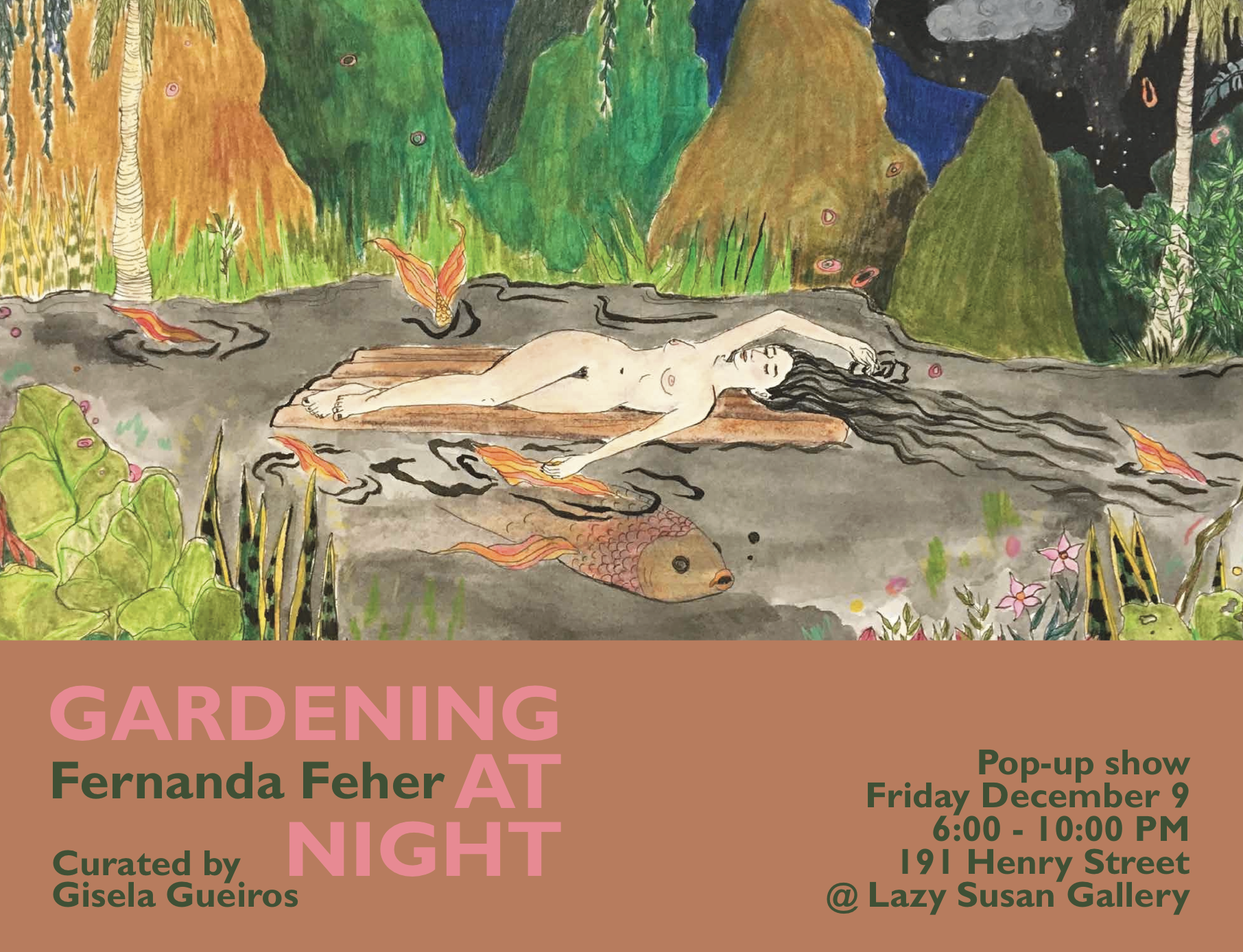To receive a catalog with available work from pop-up exhibitions I've curated, please email me at gisela@giselaprojects.com
Thank you
A partir do dia 27 de março de 2025 a mostra coletiva “perder de vista” apresenta no Taller Zaragoza um conjunto de obras de artistas representados e convidados por Gisela Projects. O projeto acontece no circuito paralelo a SP-Arte e conta com uma programação de conversa com artistas e curadoria. O projeto versa sobre os modos de pensar o olhar e a visualidade no contexto de uma atual “crise da atenção”. Buscando formas paralelas de refletir sobre tal fenômeno, a exposição incorpora elementos como o desaparecimento, o lapso e a flutuação do olhar enquanto operadores relacionais nas formas de experiência do campo artístico atual. Nesse gesto, a mostra levanta uma contraposição ao suposto prejuízo aferido na presença desatenta do espectador contemporâneo, enxergando nela não uma perda, mas uma outra modalidade de relação com as obras.
Prosseguindo com tal aposta, a teórica Claire Bishop aponta que desde a década de 60 tanto a dança, a performance quanto a arte em geral produziram obras às quais deveria se dedicar uma “distribuição de foco relaxada”, e não mais certa atenção primordial e silenciosa, como aquela característica ao modelo contemplativo de relação entre espectador-obra. Nesse caminho, perder de vista busca no que escapa à atenção dominante outro ritmo e frequência de presença tanto das obras quanto dos espectadores.
Lista de artistas: Amauri, André Feliciano, Bianca Kann, Carlos Matos, Carolina Lopes, Cecilia Abeid, Daniel Albuquerque, Evandro César, Gabriel Roemer, Marina Sader, Matheus Chiaratti, Manuela Costa Lima, Paulo Valeriano, Polly Shindler, Sara Woster, Sarah Heinemann, Sofia Lotti e Talita Zaragoza. Curadoria: Lucas Alberto
Preview aqui.
Solo show Known by Heart — featuring fresh works by Ricardo Alves at Canteiro, curated by Lucas Alberto, June 2024.
Exhibition Regra-de-Três at Galeria Estação, June 2024 — curated by Lucas Alberto & Daniela Avellar
Featuring Bianca Kann, Chiara Banfi, Chiara Sengberg, Daniel Castilho, Fabio Menino, Fernanda Feher, Francesca Wade, Gabriel Pessoto, Leandra Espírito Santo, Luana Fonseca, Manuela Costa Lima, Marina Sader, Matheus Chiaratti, Raylton Parga, Sofia Lotti, Sofia Ramos, Talita Zaragoza
Gisela Projects @ SP-Arte 2024. Press release here. Image above by Sarah Nsikak.
Gisela Projects’ booth at Untitled Art Fair 2023 was featured at Hyperallergic and Whitewall.
Inherent Landscape, group show curated by Thierry Freitas — opening in London October 12th 2023
Paisagem inerente
Uma construção geográfica, mas também social, a paisagem se impõe a todo o ser vidente ou que se locomove.
Nossa habilidade de imaginar desenvolveu-se, possivelmente, a partir da percepção do entorno: além do contato com o outro, foi conhecendo espécies e territórios que adquirimos a capacidade de imaginar mais tantos seres e lugares possíveis e impossíveis. A sensibilidade nos singulariza e, se as emoções estão presentes em diversos outros seres vivos, o encantamento com a beleza é exclusividade nossa.
Capazes de criar, podemos inventar outros mundos, uma fantasia que nasce a partir de signos capturados aqui, no nosso mundo terreno.
Essa exposição se constrói a partir de três ideias comuns a investigação das artistas Alice Quaresma, Ana Bial, Bianca Kann, Fernanda Feher, Francesca Wade, Goia Mujalli e Mariana Maurício: lembrança, paisagem e natureza.
Há também a coincidência – talvez não tão coincidente - de que todas residam fora de seu país de origem, de sua “paisagem inicial”.
Há, em alguns trabalhos, o desejo de registrar e interferir em imagens de um passado, singularizando-as através do gesto artístico.
É o que faz Alice Quaresma ao realizar delicadas intervenções em fotografias da paisagem do Rio de Janeiro. Ao mesmo tempo que compõe uma obra que se localiza entre o manual e o mecânico, a artista, ao pintar suas imagens, instaura o sentido de unicidade a um suporte caracterizado pela serialização. As incisões de Quaresma reforçam a ideia de que toda lembrança é, também, ficção.
Ana Bial deliberadamente volta-se a construção social do fetiche em torno de objetos de valor atribuído: a pintora apresenta algumas pinturas feitas a partir de vitrines de lojas nas quais joias são apresentadas com pompa e circunstância. Ao interpretá-los sobre tela, Ana transforma o valor simbólico e monetário dos objetos em pura representação, não importando mais se o que vemos são diamantes ou pedras ordinárias.
Trabalhando principalmente com suportes tridimensionais, Bianca Kann parte tanto do desenho, quanto de imagens da cultura de massa e popular para construir suas esculturas. Sua obra nasce em franco diálogo com o mundo cotidiano: trata-se de uma coleção de efemérides em sintonia com o bombardeio imagético que convivemos. Para a exposição, a artista mostra esculturas com elementos da natureza que reforçam o caráter instalativo que seu trabalho vem adquirindo.
Mariana Maurício têm constituído uma prática que se vale de procedimentos como a ressignificação de objetos comuns e a interpretação de imagens e memórias de terceiros. À artista, interessa entender o funcionamento do ordinário no contexto artístico e a reação provocada por imagens quando movidas de seu contexto original. Entre as obras da mostra, Mariana traz uma pintura feita a partir de um acontecimento notificado pela imprensa, explorando as nuances contidas em um gesto de transgressão.
Em um segundo momento da mostra, estão reunidas pintoras que trabalham sobre a ideia de uma “paisagem interior”, por vezes no limiar entre a abstração e figuração, e até mesmo de maneira fabular e surrealista, caso de Fernanda Feher. Exímia desenhista, Feher compõe seus desenhos e pinturas de maneira minuciosa, apresentando-nos delírios visuais cheios de detalhes nos quais temporalidades e ícones distintos convivem em perfeita harmonia. Sua prática pictórica é permeada por uma noção de desejo que se revela tanto na narrativa de seus quadros, quanto nas formas orgânicas e sinuosas que utiliza.
A prática em pintura de Francesca Wade destaca-se pela harmonia dos elementos e complexidade cromática. A artista cria mundos coloridos que, apesar de terem influência direta do seu convívio artístico com a filha, não soam infantis. Na aparente abstração de Wade, o observador atento conseguirá captar diversos indícios de uma figuração com referências à natureza.
Por fim, Goia Mujalli apresenta um grupo de expressivas pinturas compostas a partir de imagens complexas, por vezes captadas a partir de zooms microscópicos em folhas de plantas e pétalas de flores. Sua pintura consegue transformar a singularidade dos detalhes em grandes ambientações, fundindo macro e micro e nos rememorando que a natureza funciona em constante retroalimentação.
Além de um apanhado de memórias e construções ficcionais, a mostra é um panorama de uma geração recente de artistas brasileiras – ou com alguma relação com o Brasil - reunidas pela primeira vez em Londres. Juntos, esses trabalhos foram um horizonte singular de cores, texturas e sensações, um deleite visual formado por uma paisagem construída pelo gesto artístico.
Thierry Freitas
Setembro de 2023.
Exposição no Two Wells, Notting Hill, durante a semana de arte da Frieze Art Fair
ArtRio 2023 — setor Vista
A exposição “pedra sem-mundo”, com curadoria de Ana Roman, é fruto da primeira parceria entre a galeria Estação e Gisela Projects. Entre 26/5 e 10/6, o segundo andar da galeria será ocupado por trabalhos das artistas Bianca Kann, Chiara Banfi, Goia Mujalli, Manuela Costa Lima e Melissa Dadourian. Como sugerido pela curadora, “a exposição é um convite para que se sigamos as linhas entre as superfícies nos trabalhos, e que deixemos que elas nos guiem pelo espaço.” As obras reunidas apresentam “um perceptível desejo pelo toque”. E as artistas apresentam um interesse em comum na “justaposição e no trançar entre superfícies e elementos compositivos.”
Abertura: 26/5, sexta-feira, das 19h às 21h
Encerramento: 10/06
Endereço: Rua Ferreira de Araújo, 625 — Pinheiros
'A pedra é um ser sem mundo’.
A frase ecoa há tempos em mim. Ouvi pela primeira vez em uma conferência, na qual citava-se o filósofo alemão Martin Heidegger. Para ele, a pedra, diferente de outros seres, como a lagartixa, não tem o mundo: ela está sobre o mundo quando repousa na superfície terrestre. Não há um desejo ativo de possuí-lo e de com ele trocar. A pedra não toca o mundo.
Outro filósofo contemporâneo responde diretamente à Heidegger: Jean-Luc Nancy. Ele nos pergunta: será o tato sempre o desejo de possuir o outro? Ou será a impossibilidade de tocar uma evidência dos limites abissais que existem entre todas as coisas do mundo – mesmo quando estão em relação direta?
Ao contrário (e a partir) destas teorias, o toque revela o espaço entre: o espaço da pedra, do mundo e o espaço do porvir que existe no contato. No toque entre as coisas está contido tudo aquilo que é, a priori, impossível de existir junto. Quais seriam as impressões expressas por uma pedra depois de repousar sobre um pedaço de madeira? Ou o que acontece depois de deixá-la encostada no gelado de uma superfície metálica?
A pedra é com-mundo quando toca a madeira ou o metal.
Nos trabalhos reunidos na mostra, há um perceptível desejo pelo toque: as artistas operam na justaposição e no trançar entre superfícies e elementos compositivos. Costurar; juntar objetos aparentemente inanimados com linhas e tentar ouvi-los, tecer grandes estruturas e esculturas com materiais encontrados; pintar e bordar folhas de plantas que tem seus limites diluídos em uma espécie de floresta; e justapor elementos que remetem a distintas cosmogonias (ou à história da arte) em composições permeadas de humor; são alguns dos procedimentos dos quais se utilizam Bianca Kann, Chiara Banfi, Goia Mujalli, Manuela Costa Lima e Melissa Dadourian..
A linha é o elemento que dá a ver o toque. Em alguns dos trabalhos, ela é tensionada e estrutura novas superfícies; em outros, é frouxa e permite o desenho. Nunca está parada e indica que existe movimento em potência entre as superfícies que encostam. Pedra, cerâmica, madeira, tinta, semente e tecido tocam-se e tornam-se outros. Tudo é passível de costura e conecta-se pela linha, criando relações, novos significados e tempos.
A exposição é um convite para que sigamos as linhas entre as superfícies nos trabalhos, e que deixemos que elas nos guiem pelo espaço. Ela é também uma espécie de elogio ao toque. No dia que escrevo este texto, a OMS declara o fim da emergência sanitária da pandemia de Covid-19, período no qual nossos corpos foram, de alguma forma, impelidos a tocar menos. Os trabalhos nos lembram da potência do encontro entre as distintas matérias e nos chamam a tocar de novo, de perto, o mundo que nos cerca.
Ana Roman
Engradados
2023
Cercados pelo grid — a grade, ou retícula, que nos contém em nossa experiência urbana no mundo contemporâneo —, estamos constantemente emoldurados pelo quadrado, com nossas janelas, casas, prédios, mapas, calendários…
As estruturas rígidas que criamos para nos dar segurança e um sentido maior de previsibilidade também existem para serem desafiadas e testadas.
Nessa mostra coletiva, reunimos trabalhos de doze artistas do Brasil, do Uruguai, da França e dos Estados Unidos, que questionam a imposição destes parâmetros para dar espaço a formas mais fluidas, mas nem por isso menos relacionadas à referência quadriculada do grid.
Artistas:
Julia da Mota [BR]
Sarah Heinemann [EUA]
Talita Zaragoza [EUA/BR]
Manuela CostaLima [BR]
Amanda Mei [BR]
Pedro Horace [BR]
Brian Wiggins [EUA]
Regina Dabdab [BR]
Martin Pelenur [UR]
Hugo Frasa [BR]
Filipe Jardim [BR] | APARA [FR]
Raylton Parga [BR]
Mais imagens, aqui.
SP-ARTE
Março 2023
Para o estande na SP-ARTE, Gisela Projects apresenta pinturas, esculturas e tapeçarias de 15 artistas que se relacionam com o tema da paisagem. Partimos das contribuições de autores contemporâneos para repensar a paisagem no nosso tempo, articulando as pesquisas desses artistas com o contexto atual. A ideia não é apenas observar, mas estar dentro de certa cena – as paisagens apresentadas sugerem cenários "que nos conduzem para além de nós mesmos, nos conectando com o espaço”, como sugerido por Édouard Glissant.
Artistas que integram a seleção: André Feliciano, Bianca Kann, Cela Luz, Cooper Lovano, Fernanda Feher, Francesca Wade, Gabriel Botta, Julia da Mota, Matheus Chiaratti, Michel Onguer, Polly Shindler, Raylton Parga, Ricardo Alves, Sara Woster e Sofia Lotti.
Futuro Oásis
Galeria Lume
Abertura 25/3, das 11h às 17h
Artistas: Gabriel Botta, Fernanda Feher, Sarah Heinemann, Cela Luz e Talita Zaragoza
Texto: Henrique Menezes
Futuro Oásis
Denotando a incerteza que se oculta em toda projeção de porvir, o título dessa exposição
poderia ser acompanhado por um ponto de interrogação: a sugestão de uma incógnita –
“futuro oásis?” – responderia, assim, às reflexões contemporâneas que, sem entusiasmo,
creem na falência e não na evolução, na ruína em detrimento à construção. Envoltos em
pessimismo, sentimentos comemorativos ou desolados dando conta do fim têm moldado
o pensamento dos séculos XX e XXI: a morte das ideologias (Lyotard), do real (Baudrillard),
da autoria (Barthes), além do fim da história da arte (Danto e Belting) e até mesmo o –
quase apocalíptico – fim do futuro (Berardi), para citar alguns. O futuro coloca-se como
fardo e não fundação. Mas apesar disso, ainda há espaço para o poético.
***
A imagem de um oásis – evocando igualmente um espaço simbólico e uma cercania
concreta na geografia – revela-se como um destino onírico, uma expectativa de
horizonte onde coexistem o maravilhamento e a surpresa. Se o oásis representa o
otimismo em profusão solar, a paisagem e a natureza ocupam também um campo fértil
para a projeção do oculto e do temor: a ideia da noite sempre caracterizou o momento em
que o mal – escondido durante o dia por não suportar a luz – vem à tona. A tempestade
projeta a alegoria da fúria divina, tão breve quanto intensa. E dentre todos os lugares
tradicionalmente assombrados pelo perigo e pelos significados transcendentes que lhes
eram atribuídos, o oceano talvez fosse o pior. Tanto o futuro quanto o oásis parecem
encerrar em si projeções de uma paisagem simbólica a desbravar, um alento entre o real
e a miragem.
***
“A beleza será convulsiva ou não será” – com essa máxima, André Breton conclui uma de
suas principais obras literárias, sugerindo a intensidade que se espera das experiências
estéticas: tal frase mostra-se fértil para introduzir o diálogo entre os trabalhos de Cela
Luz, Fernanda Feher, Gabriel Botta, Sarah Heinemann e Talita Zaragoza – reunidos na
exposição Futuro Oásis. Apesar de não buscar similitudes que enquadrem as obras em
uma unidade restrita, certamente a mostra explora uma fisicalidade intensa que nada
tem de meditativa: a natureza é configurada por composições indomadas e disformes,
tão caóticas quanto aprazíveis. As obras ora acercam-se do abstrato e ora revelam a
reinterpretação figurativa de seus referentes: com a liberdade concedida pela pintura
e pela escultura, os processos de criação não buscam ancorar a poesia à verdade.
Intempestivos, os contornos desgarrados presentes em cada obra são fruto da presença
marcante da matéria – seja o látex, a cerâmica ou densos pigmentos sobre a tela.
Pela utopia evocada ou pela vibração despertada, percorrer a exposição assemelha-se a
correr por um território de euforia. O horizonte parece estar em ebulição.
Partnership with David Zwirner’s Platform featuring Polly Shindler & Sara Woster. Launching January 6th 2023 at 10AM.
Talita Zaragoza| Sounds of Water / December 2023
In this new body of work, Talita Zaragoza presents paintings and works on paper fresh out of her studio. The color blue appears with strength and, as the artist suggests, “may be representative of water”. Water as symbol for creation, dissolution, transformation. This potent element that lets things flow, but also destroys, deforms – builds and rebuilds landscapes. Water as a catalyst, a tool capable of metamorphosing processes.
The artist created this series while pregnant, expecting her first child. A powerful milestone for her body and personal timeline, changing her status forever. We could state that her body, like a map, is currently being transformed by water. Her silhouette shifts in shape, volume and energy, as landscape – in constant impermanence, in its own particular time, as you read this sentence.
Thrilled to have been chosen as one of the best booths at NADA art fair according to Hyperallergic:
Roots of Intelligence
For many centuries, Western rationality postulated its separation from nature as synonyms with progress and development. Human beings erroneously entitled themselves as the central species on this planet, and believed that ecology was an untouchable and distant realm.
We are nature. Going further: Nature is humanity's original sanctuary, connecting everything that is alive.
In 2020, at the height of the COVID-19 pandemic, which forced everyone around the globe into isolation, Stefano Mancuso was interviewed by the Spanish newspaper La Vanguardia, where he called himself the father of plant neurobiology, a field that was trivialized for years, which studies the vegetative collective technology.
The Italian author and researcher focuses on the innate collaboration occurring amongst plants, which represent over 80% of life on Earth. Mancuso regrets that our behavior is based on the struggles of animal species, which in turn represent only 0.3% of living things. Vegetation is interconnected, it acts as a supportive community, organizes itself to cater to their more fragile members, travels around the world and interacts through rhizomatic networks of communication and assimilation. It is possible that the notion of rhizome, so obvious amongst plants, has never been so fundamental to our species.
In his interview for La Vanguardia, Mancuso affirmed that the sensation of being cooped up at home, experienced during quarantine, made him feel exactly like a plant, and pointed out: "We learned that when we are stuck, we tend to pay more attention to our surroundings". This exact sensation, of being attentive to our context and nature, especially during the pandemic, inspired the exhibition and the seven artists present in Roots of Intelligence.
Plant intelligence influences many of us. There is a contemporary desire for reconnection with our ecosystem, cultivating the sacred and integrated qualities of nature and their healing and collaborative powers. Roots of Intelligence shows how these artists, like Stefano Mancuso, explore the paths for better dialogues and relationships with all living systems.
The exhibition showcases pieces that distinguish details and materials, such as Chiara Banfi's watercolors and crystals, as well as Marcelo Pacheco‘s oil paintings. We explore appreciation and attention to animal and natural living structures, found in Gabriel Giucci's paintings and in Paula Juchem's sculptures. From micro explorations, we venture into macro scenarios, and start to truly feel the living and interconnected atmosphere of the show. This is the case in Fernanda Feher's dreamy landscapes and Michel Onguer's explosion of greenery. Lastly, the ecosystem is delivered to our eyes and presence through the plasticity and abstraction of Renato Rios' and Sarah Heinemann's oil paintings.
Stefano Mancuso highlights how artists are more perceptive of changes in ideas and the collective consciousness, and how art has understood, even before scientists, that plants are the future – a perception that is at the core of this show.
What we observe is an enormous biosphere in convergence. One of the key learnings from the plant world is that most plants do not compete, they cooperate. This is also the greatest learning we can take from the effort and the poetics of these artists and their works.
Iza Dezon
_
[Portuguese version]
Por muitos séculos, a racionalidade ocidental postulou a separação da natureza como sinônimo de progresso e desenvolvimento. O ser humano, erroneamente autodeclarado espécie central do planeta, acreditava que a ecologia era uma bolha intocável e distante.
Nós somos natureza. E mais: ela é o santuário original da humanidade, conectando tudo o que é vivo.
Em 2020, durante a pandemia da COVID-19, que forçaria todos ao redor do mundo a se isolarem, o italiano Stefano Mancuso foi entrevistado pelo jornal espanhol La Vanguardia. Mancuso se intitula pai da neurobiologia vegetal, campo que estuda a tecnologia comunitária das plantas que, por anos, foi desprezada.
Autor de livros e pesquisas sobre o assunto, ele ensina que a colaboração é inata às plantas, que representam mais de 80% da vida na Terra. Mancuso lamenta o fato de nos basearmos na luta da espécie animal, que representa apenas 0,3% dos seres. As plantas estão interconectadas, cuidam umas das outras, se organizam para suprir necessidades de suas irmãs mais frágeis, realizam viagens pelo mundo e se relacionam de forma rizomática em redes de comunicação e assimilação. Talvez a ideia do rizoma nunca foi tão fundamental para a nossa espécie, visível nos vegetais.
Durante a entrevista para o La Vanguardia, Mancuso afirma que a sensação de quarentena, de estar preso em casa, parado, lhe fez sentir exatamente como uma planta: "Aprendemos que, estando presos, cultivamos uma maior atenção ao ambiente que nos cerca", ressaltou. Essa mesma sensação de nos atentarmos ao redor e à natureza, principalmente durante a pandemia, moveu a curadoria e os sete artistas presentes na exposição Roots of Intelligence.
A inteligência das plantas influencia muitos. Existe uma vontade contemporânea de reconexão com o nosso ecossistema, cultivando a qualidade sagrada e integrativa da natureza, seu poder de cura e de colaboração. Em Roots of Intelligence, é visível como estes artistas, assim como Stefano Mancuso, exploram como podemos aprimorar nosso diálogo e relação com os todos os sistemas vivos.
Encontramos obras que observam os detalhes e o material, como nas aquarelas de Chiara Banfi e nos objetos e na pintura de Marcelo Pacheco. Um apreço e atenção às construções do ser animal e natural, visto nas pinturas de Gabriel Giucci e nas esculturas de Paula Juchem. Dessa exploração mais micro, nos aventuramos em propostas macros, e conseguimos sentir o ambiente vivo e interconectado da mostra se materializando. É o caso das paisagens com tons oníricos de Fernanda Feher e a explosão verde de Michel Onguer. Por fim, o ecossistema está dado aos nossos olhos e presenças, completo pela plasticidade e abstração das pinturas a óleo de Renato Rios e Sarah Heinemann.
Stefano Mancuso ressalta que os artistas percebem rapidamente as mudanças das ideias e da consciência coletiva, e a arte compreendeu, antes mesmo dos cientistas, que as plantas são o futuro. A exposição Roots of Intelligence ressalta esta percepção.
O que observamos aqui é um grande ecossistema em convergência. Um dos maiores ensinamentos do mundo vegetal está no fato de que quase todas as plantas não competem, elas cooperam. Este é também o maior aprendizado que temos ao vivenciar os trabalhos e a poética destes artistas e suas obras.
Iza Dezon
Gisela Projects
ArtRio 2022
Stand V2
Pavilhão Mar
Para a edição 2022 da ArtRio, apresentamos a produção recente das artistas Ana Bial, Bianca Kann, Francesca Wade e Goia Mujalli. Cor e textura prevalecem em nosso stand -- materialidade como reação às telas e à assepsia da pandemia. O crítico e pintor Patrick Heron sugere que "mesmo os potes mais tortos, mesmo os tecidos menos uniformes, mesmo as imagens mais esquisitas, todas as formas de fazer artístico são efetivas em um sentido: registram formas de protesto".
Ana Bial (1987) nasceu no Rio de Janeiro num sábado de Carnaval, estudou no Parque Lage, e se formou na School of Visual Arts, em Nova York. Participou da residência artística Despina e de várias exposições coletivas em Nova York e no Rio. Sua produção mais recente explora questões de crença e noções de gosto. Um de seus trabalhos se utiliza como suporte de um Roomba – aspirador de pó móvel e robotizado. Posicionada sobre o equipamento, uma estatueta souvenir de Santa Verônica segura um sudário com a facsimile de Jesus. A escultura ressalta os aspectos absurdos deste tipo de tecnologia automatizada. Outra escultura apresentada é a reprodução, feita pela artista à mão, de uma bolsa que parece ter sido esquecida por um visitante no espaço expositivo. Dentro da bolsa, uma versão do famoso autorretrato de Courbet, pintado por Bial. O senso de humor de artista, assim como os reflexos e réplicas, são representativas do nosso zeitgeist, onde tudo o que vemos já foi visto antes.
Bianca Kann (1995) é uma artista multidisciplinar que trabalha principalmente em escultura. Formada em Artes Plásticas pela NYU em 2017, ela participou da residência Byrdcliffe em Woodstock, NY dois anos depois de se formar e fez parte de várias exposições coletivas em Nova York e São Paulo. Kann está interessada em como o contexto pode afetar nossa percepção dos símbolos. Ela questiona conotações preconcebidas, deixando espaço para o absurdo. O acúmulo e excesso de imagens, assim como a moda contemporânea e a cultura digital da comunicação por meio de memes, adesivos, gifs, também são referência em sua prática. Kann também é influenciada por seu trabalho de pesquisa na Columbia University com implementação de serviços de saúde mental em Moçambique, onde ela explora noções de insanidade e empatia, sob o enfoque da arte e da ciência.
Francesca Wade (1984) cresceu entre Inglaterra, Escócia, Noruega e Egito, se formou na Central Saint Martins e na escola de design Brighton Art School. Participou da residência artística FABRICA, na Itália, onde passou os primeiros anos de sua carreira. Hoje, ela vive e trabalha no Lower East Side, em Nova York, em um espaço onde muitas partes da vida dela se juntam – um apartamento onde acorda todas as manhãs, onde é mãe todos os dias, para onde convida amigos e onde se isola dos outros – um lugar com janelas enormes e muita luz, mas sem vista para o mundo exterior. A artista considera essa informação muito significativa, já que em suas pinturas ela cria suas próprias vistas e paisagens imaginadas. Os trabalhos apresentados na ArtRio foram muito influenciados pelas reflexões da artista diante da morte de sua avó. “Nesse período de luto, pensei muito nos meus antepassados. Imaginei a mãe da minha avó, a mãe da mãe dela, depois a mãe dela e assim por diante, indo mais longe, expandindo meu senso de quem ou ao que pertenço”. Nesta série, a artista explora a ideia de crescimento, abundância de energia e fluidez entre as diferenças e senso de pertencimento que temos uns com os outros. A artista aceita e apoia as irregularidades da natureza, onde, como ela diz: “nada é perfeito, mas tudo é refinado”.
Goia Mujalli (1985) é mestre em Pintura pelo Royal college of Art e formada em Artes Plásticas pela Slade School of Fine Art. Ela vive e trabalha em Londres e já participou de diversas exposições no Brasil, nos Estados Unidos e na Europa, além de ter feito uma residência artística na Itália, na Essiccatoio Art Residency, no ano passado. Os trabalhos mais recentes de Mujalli revelam a pesquisa da artista e seu interesse por plantas e frutas tropicais e suas texturas. As imagens surgem de fotografias ampliadas de folhas de bromélias, helicônias e outras espécies, que remetem também as memórias da artista em sua cidade natal. Os trabalhos que envolvem bordados surgiram a partir do processo da artista em serigrafia, que deixava marcas semelhantes a costuras. Através desse trabalho, a artista descobriu uma história secreta de sua família. Sua avó fazia crochê, dava aulas e bordava roupas, mas sem nunca revelar esse talento a ninguém, já que seu marido não queria que ela trabalhasse. Há uma fascinação da artista por formas e desenhos biológicos. Ao transplantar as imagens de plantas para as telas – pintadas ou bordadas – um mundo de ilusão se cria. Além de se apropriar dessas formas da natureza, a artista se apropria também de retalhos e restos de tecidos descartados em produções em massa como suporte para seu trabalho.
Ana Bial
OMA
Pop-up show during Brasil Summerfest
July 14th from 2-8PM at the Dumbo Archway
155 Water Street, New York, NY
Zabelê will take the stage from 6-8PM
About the pop-up OMA, Ana Bial states: “Oma is grandma in German. I call my grandma Oma. She has Charles Bonnet syndrome which causes a person whose vision has started to deteriorate to see things that aren’t real (hallucinations). The hallucinations may be simple patterns, or detailed images of events, people, or places. Oma is also the name of the architecture firm founded by Rem Koolhas and one of my favorite people, Reiner de Graafe, is a partner. Office of Metropolitan Architecture.”
Fernanda Feher – ArPa – Junho 1-5, 2022
“We should not waste time in trying ordinary understanding. We should not worry, either. There is no rest in any kind of perception” – Etel Adnan in “Journey to Mount Tamalpais”
In this first edition of ArPa, in the UNI sector, curated by Ana Beatriz Almeida, Fernanda Feher presents a series of new works, from 2022, in various media – tapestry, ceramics, painting, drawing and collage. In her practice, the artist presents us with fantastic universes and characters. It is through this symbology that Feher elaborates themes that turn the particular into something universal.
Booth U9 at ArPa 2022
Habitar o indomesticável: o feminino como potência poética de reinvenção
por Bianca Coutinho Dias
O trabalho de Fernanda Feher é investido de uma potência feminina indomesticável e seu gesto como artista abriga a ferocidade necessária para transmutar mundos. No centro de sua obra está a pintura, mas dela derivam outras linguagens – desenho, tapeçaria, papel de parede, cerâmica, porcelana e escultura – resultando em um pensamento poético que acolhe algo além do saber fálico e instituído, promovendo uma torção que encontra a insubmissão como força de reinvenção de si e do mundo.
Do saber curandeiro ancestral de “Feitiço” ao singular “Jardim das deliciosas”, vislumbra-se uma dança imprevisivelmente fértil. O uso do mimetismo – um recurso de sobrevivência e disfarce como meio de fuga – é subvertido no jogo, com tons diversos de peles que passeiam entre frutas e flores. Os objetos estão sempre em explosão e deslocamento. Na justaposição e sobreposição de elementos, cores e texturas, a artista cria uma atmosfera hipnotizante e sedutora. Seu jardim é, antes de mais nada, um ensaio em torno das possibilidades transfiguradoras das margens, uma espécie de reencantamento do mundo pela força do feminino, uma forma de afirmar que a vida é insubmissa às estruturas e que, a despeito delas, insurge intempestiva e indomável.
Sua produção diverge da lógica patriarcal da propriedade, da exploração e do controle da vida. Seu jardim é também o jardim de todas as mulheres. Frente aos imperativos postos, Fernanda Feher abre espaço para o surgimento da diferença no mundo com um hibridismo ímpar de humor e ferocidade, misturando Lilith, Jane Fonda, cartas de tarot, beringelas, garrafinhas de cerveja, espadas de São Jorge. É, no sentido mais agudo, uma iconografia delirante que, ao jogar e brincar com toda uma simbologia, sustenta a não-totalidade fálica que cria camadas de ambiguidade como, por exemplo, o uso da árvore “mata-pau” ou “figueira-vermelha”, uma planta estranguladora que pode germinar sobre outras até que suas próprias raízes alcancem o solo.
Em “Todas as outras vênus”, várias texturas, espessuras e linguagens evocam outro lugar, outra possibilidade narrativa frente à história da arte canônica, uma abertura ao incalculável e inominável do feminino. Essa dimensão é invocada no livro “Calibã e a Bruxa: mulheres, corpo e acumulação primitiva”, de Silvia Federici. A filósofa sustenta a tese de que, no momento em que a terra começa a ser completamente privatizada, a mulher passa a ser igualmente controlada e, a partir daí, qualquer mulher que pratique alguma forma de insubmissão é demonizada e amaldiçoada. O que a artista propõe é outra espécie de feitiço: ao se apropriar desse significante maldito, ela o desloca à uma possibilidade que conjuga a sustentação da alteridade e de uma impropriedade própria da arte. Na sua obra, o feminino se apresenta como uma instância incolonizável que pode abalar a lógica, jogando, brincando e sonhando. Não por acaso, a importância que Sigmund Freud confere aos sonhos é justamente o fato de serem indóceis a qualquer síntese simbólica.
No díptico “Natureza viva” a subversão se anuncia desde o título. Espessuras distintas e objetos que parecem saltar do quadro portam o tremor, espécie de brilho do real que perfaz uma figurabilidade particular, a partir de um ponto de abertura para o selvagem, para o que está ainda em vias de nascer, como na atmosfera dos sonhos que não contam uma história linear, mas fazem pulsar pelos fragmentos uma invenção, uma trilha que reinveste a existência e o cotidiano com qualidade indócil e poética.
Neste sentido, o seu trabalho artístico quer reencantar o mundo e tomá-lo a partir de outra lógica, fazendo de toda a maldição uma purificação, uma espécie de expurgo que conjuga um saber feminino com uma força desterritorializante que abala as formas e as representações majoritárias. Se há, por exemplo, uma “Femme Fatale” em cena, é para estilhaçar as totalidades, como uma alegoria em que cabe o encontro com o excesso, sem que isso possa configurar uma violência contra o corpo feminino.
E é tanto na dança fervorosa, quanto no silêncio que pode habitar uma delicada aquarela com uma bromélia, que essa fertilidade se erige. De tapeçarias – como um texto-textil feito por muitas mãos femininas em parceria com a artista – que ajudam a recriar o mundo, como do crochê que envolve o tríptico “Feitiço” e acentua um saber manual ancestral, passando pela mistura de técnicas de colagem, pintura, aquarela, desenho e tantas outras, Fernanda Feher cria sua própria desmedida, seu elogio à imprecisão e ao pensamento mágico que, frente ao desencantamento do mundo, pode criar frestas e fazer vicejar novas formas de existir, como na poesia de Adília Lopes: “O deserto está perto. Sempre. Mas o deserto é fértil”.
NOTA
Os trabalhos “Lilith” e “Jane Fonda” foram feitos em parceria com o Atelier Adriana Fortunato (Adriana Fortunato, designer textil – Edu Garcia, produtor), criativo estúdio textil que, por meio de uma extensa pesquisa sobre a cadeia produtiva das fibras naturais e seus impactos ambientais, desenvolve tecidos e produtos com base em valores sustentáveis, culturais e produtivos. Nesta parceria, os painéis mesclam impressão digital em uma base de algodão 100% reciclado com o trabalho manual de bordadeiras do Jardim Conceição, formando um jogo de volumes, texturas e manualidades com retalhos de seda pura, bordados diversos e feltragem de lã pura de pequenos produtores do sul do Brasil.
Bordadeiras: Sonia Maria Leal Bento, Alzira Sousa de Oliveira, Veroneide Batista de Lima, Neide Maria de Santana Alves de Souza, Renata da Cruz
—
"Ain't I a Woman" é um fragmento do discurso proclamado por Sojourner Truth (1797–1883) durante a conferência dos direitos femininos em 1851 na cidade de Akron, Ohio. Um clássico na luta abolicionista e por direitos femininos. De alguma forma a frase nos leva a pensar o que seria uma mulher e tudo que estaria em exílio deste universo. Trago este fragmento como veículo metafórico para refletir sobre o trabalho de Fernanda Feher e seu universo sobre a imagética do feminino em exílio. O trabalho da artista figura como o ponto cego lunar, como a visualidade dos medos inconscientes. Tal como Lilith na astrologia, um ponto invisível da lua, que se opõe a Terra e comanda nossos instintos.
Ana Beatriz Almeida
Curadora setor UNI
For this show I've invited artists and friends Sara Woster and Brian Wiggins to make a selection of each other's works. They've known each other for decades and have also been mutually inspired. '
Brian Wiggins on Sara Woster: Before I began looking at Sara Woster’s paintings for Mutual Theft, I made the decision that I would look at them first free of narrative or subject matter and only look for similarities of form in color, space, and the overall structure of each painting. I also took notes of the experience to keep me on track with the directive that our use of color is why Mutual Theft exists as a show. We mutually have consciously and unconsciously stolen from each other (and others) for years. Art works that way. I’ve known Sara’s art for almost twenty years so I knew this wouldn’t be easy, but I felt that I would uncover something that I hadn’t experienced in her work, and that’s exactly what happened. I’m not saying it was an emotional experience, but it was, and I was genuinely surprised by their openness. A silhouette is mass with no light. Everything is dark, but well lit. Illuminated as to show the lightness. The lightness is levitation and luminosity. It’s as if the light that generates the matter loses any gravitational bearing and things just float upward and away. There is no anger, no judgement, no weight; what a beautiful way to live.
Sara Woster on Brian Wiggins: As we prepared to write these essays about each other’s paintings Gisela sent us some text from a Richard Tuttle interview where Tuttle said “dialogue is the glue of the social matrix”. It was an interesting thing to read when immersing myself in Brian’s paintings, artworks steeped in conversations between color and line, painterly marks and marks pretending to be straight edges. Hidden in his colorful palette there is usually some taunting, some tensions, some lines fighting their way off the edge of the canvas. I have always thought that Brian’s works are best viewed as a group when his lines can escape the plane that was intended to contain them in order to find a new tension or conversation with the marks on the painting next door. A line leaves a canvas here and enters another one there. A thought bubble pops up in one, disappears in the next. The artist’s dedication to this conversation within a single painting and with the paintings surrounding is the result of thoughtful playing with line and color. The paintings might be playful but the labor of his work is always evident. Painting is nothing but tweaking and perfecting, making a good painting is a tedious obligation, and Brian always makes sure to give us a hint of that process in his deliberate marks.
Click here for the online show.
April 5th, 2022
Gisela Projects participating at ArtSampa art fair — March 16-20th, 2022, at OCA, Ibirapuera, São Paulo — featuring Melissa Dadourian, Sarah Heinemann and Cela Luz. Click here.
Interconnected Forces — an exhibition featuring Talita Zaragoza, Tomaz Capobianco, André Feliciano and Gabriel Giucci organized by Gisela Gueiros. From February 1st - April 1st, 2022
Alexander von Humboldt was the first to look beyond an isolated organism and understand the relationship between plants, climate and geography. The explorer coined the term Naturgemälde — in German it can mean ‘painting of nature’ but also implies a sense of unity or wholeness. He described nature as a web of life where everything is connected — the cultural, biological and physical world. ‘Nature is a living whole,’ Humboldt said, ‘not a dead aggregate.’ As early as 1800, he predicted harmful human–induced climate change.
Interconnected Forces brings to the Brazilian consulate a group of artists who use nature as a starting point. Here we see rocks in drawings by Gabriel Giucci, camera shaped flowers in sculptures and photographs by André Feliciano, paintings suggesting volcanos and imaginary landscapes by Talita Zaragoza and sculptural compositions referencing mountains, cliffs and canyons by artist and climber Tomaz Capobianco. In each case, the artist is contemplating nature through mediated interpretations. We come inside to reflect on the outside.
The works present another context for the connections Humboldt revealed: a painting uses pigment, a drawing uses graphite, and both over paper or canvas made of natural fibers. In the same way that nature is always seen through the filters of culture — as stated by Olafur Eliasson —, culture is also always drawn from nature.
These relationships are more urgent than ever. Artworks like these, that make us reconsider nature, also become an invitation to reflect on nature’s state of emergency. They can help us heed Humboldt’s warning and take action.
Exhibition co-curated by Claudia Calirman and Gisela Gueiros at Marilia Razuk Gallery featuring Ana Vitoria Mussi, Marcia Xavier and Maria Laet. February, 2022, in São Paulo, and online at Preview.
Pelas Frestas: Ana Vitória Mussi, Márcia Xavier e Maria Laet
“There is a crack in everything, that's how the light gets in”
Leonard Cohen
Pelas Frestas: Ana Vitória Mussi, Márcia Xavier e Maria Laet foca em três artistas de gerações diferentes que apresentam afinidades estéticas e poéticas, ao utilizar resíduos e memória como trama condutora de suas obras. A exposição tem curadoria de Claudia Calirman e Gisela Gueiros, historiadoras da arte baseadas em Nova York, em parceria com as galerias Lume, Marilia Razuk e Casa Triângulo.
Na obra de Ana Vitória Mussi (1943), negativos fotográficos formam o trabalho em si. Entre 1979 e 1989, Ana Vitória trabalhou como repórter fotográfica cobrindo a noite carioca. Em Série Negativo, Pelas Frestas (1972/2012); À Tua Imagem I (1978/2004) e Índice #2 (1978), as imagens dos negativos são suprimidas, ao invés de serem reveladas. O que se vê são apenas os porta-negativos; os envelopes e o papel celofane que os protegiam. Há um desdobramento tanto do passado da artista, quanto da datada cena social do Rio de Janeiro, abandonando o que já não importa, para desvendar e criar um novo presente. Os negativos não se referem mais a nada, mas apenas a si mesmos. Os envelopes e suas respectivas numerações deixam de catalogar aquilo que não existe mais, para simplesmente envolver o vazio.
Se no trabalho de Mussi os porta-negativos e seus negativos deixaram de se corresponder, no fotograma Véu 3 (2007) de Márcia Xavier (1967), o véu de noiva também aparece desconectado do corpo que o vestiu. O mesmo se dá em Bolômetro (2009), onde uma foto aérea da cidade de São Paulo – tirada pelo pai da artista que era piloto – é parcialmente obliterada com recortes, em forma de um gabarito/bolômetro. Os recortes sugerem algo a ser completado, um espaço a preencher – a arte que se modifica através da percepção do espectador e a cidade que se altera com a presença de seus habitantes. A vista aérea revela elementos urbanos que são invisíveis para quem navega a cidade como pedestre. De novo, um distanciamento – apenas uma marca, um vestígio.
Na obra de Maria Laet (1982), as imagens vão se diluindo, se distanciando de sua forma inicial. Tanto em Dobra (2015/2018), monotipia sobre papel de algodão e papel japonês; quanto em Sopro (2013), gravura em metal sobre papel de algodão; e em Sem Título (Gaze) (2013), monotipia em papel de algodão, há um atravessamento de luz sobre o material permeável e poroso, criando uma imagem que aos poucos vai se desdobrando e evanescendo. Os gestos de dobrar ou soprar registram a costura de uma experiência vivida, revelando a passagem do tempo e sugerindo a fragilidade da memória. Nessas transferências entre camadas de papel, nas dobras e nos sopros, a presença humana – da mão que desdobra o papel ou do fôlego que se faz escasso – são como um carimbo da vulnerabilidade da presença humana.
Em todas as obras há uma reflexão sobre a impossibilidade de uma preservação eterna, o desejo de registrar esquecimentos e a tênue captura do que já está se apagando. O que resta é a certeza de que aquilo que foi não pode mais ser. Vestígios de arquivo, ou arquivos de vestígios.
Claudia Calirman é professora associada de história da arte no John Jay College of Criminal Justice, Nova York. Ela é autora de Arte Brasileira sob a Ditadura Militar: Antonio Manuel, Artur Barrio e Cildo Meireles (Duke University Press, 2012/Réptil Editora, 2014).
Gisela Gueiros é historiadora da arte, consultora de arte e educadora baseada em Nova York desde 2007. Ela trabalhou no Museu Guggenheim e já organizou mais de 30 exposições entre Nova York e São Paulo.
==
Through the Cracks: Ana Vitória Mussi, Márcia Xavier and Maria Laet
“There is a crack in everything, that's how the light gets in”
Leonard Cohen
Through the Cracks: Ana Vitória Mussi, Márcia Xavier and Maria Laet focuses on three artists from different generations who share aesthetic and poetic affinities, using residues and memory as the guiding threads of their works. The exhibition is curated by Claudia Calirman and Gisela Gueiros, art historians based in New York, in partnership with galleries Lume, Marilia Razuk, and Casa Triângulo.
Ana Vitória Mussi’s (1943) pieces consist of undeveloped photographic negatives. Between 1979 and 1989, Mussi worked as a photojournalist covering Rio de Janeiro's nightlife. In Série Negativo, Pelas Frestas (Negative series, Through the Cracks, 1972/2012); À Tua Imagem I (In Your Image I, 1978/2004) and Indice #2 (Index #2, 1978), images are suppressed rather than revealed. What is left are just negative holders; envelopes and cellophane papers that once protected the photographic negatives. Through this process, both the artist's past and the dated social life scene of Rio de Janeiro unfold, as Mussi leaves behind what no longer matters, to unveil and create a new present. The negatives stop referring to anything but only to themselves. The envelopes and their respective numbers stop cataloging what ceased existing, to simply envelop the void.
If in Mussi's work the negative holders and negatives themselves no longer correspond to each other, in Véu 3 (Veil 3, 2007) by Márcia Xavier (1967), the bridal veil also appears disconnected from the body that once wore it. The same happens in Bolometro (Bolometer, 2009), where an aerial photo of the city of São Paulo – taken by the artist's father who was a pilot – is partially obliterated with clippings, in the form of architectural templates/bolometers. The clippings suggest something yet to be completed, a space to be filled –the artwork changes through the spectator's perception as the city mutates with the presence of its inhabitants. The aerial view reveals urban elements that are invisible to those who navigate the city as pedestrians. Again, a detachment – just a mark, a vestige is left.
In Maria Laet's (1982) work, the images are diluted, distancing themselves from their initial form. In Dobra (Fold, 2015/2018), monotype on cotton paper and Japanese paper; Sopro (Breath, 2013), metal engraving on cotton paper; and Sem Título (Gaze) (Untitled [Gaze], 2013), a monotype on cotton paper; there is a passage of light through the permeable and porous materials, creating an image that gradually unfolds and fades away. The gestures of bending or blowing record a lived experience, revealing the passage of time and suggesting the fragility of memory. In the folds, blows, and the passages in-between layers of paper, the human presence – the hand that unfolds the paper and the breath that becomes scarce are like a stamp of the vulnerability of the human presence.
In all the works in the exhibition there is a reflection on the impossibility to preserve something ad infinitum, a desire to record forgetfulness, and the tenuous capture of what has been already erased. What remains is the certainty that something that was can no longer be and no longer is. Archive traces, or traces of archives.
Claudia Calirman is an associate professor of art history at John Jay College of Criminal Justice, New York. She is the author of Brazilian Art under Dictatorship: Antonio Manuel, Artur Barrio and Cildo Meireles (Duke University Press, 2012/Réptil Editora, 2014).
Gisela Gueiros is an art historian, art consultant, and educator based in New York since 2007. She has worked at the Guggenheim Museum and has organized over 30 exhibitions between New York and São Paulo.
Antes de Ser
Group show at Joaquim Antunes 177 sala 11
From November 2021 to January 2022
Goia Mujalli
Polígonos, pórticos, matéria e desejo
Polígonos são figuras geométricas planas e fechadas formadas por segmentos de reta, presentes em suas diferentes manifestações na seleção de obras que compõem a mostra, e que não são necessariamente os únicos pontos de interlocução entre os trabalhos. Além da forma, o que envolve as operações que constroem as obras apresentadas por Carolina Martinez, Mano Penalva, Heleno Bernardi, Marina Caverzan, Julia da Mota e Renato Rios em Polígonos, pórticos, matéria e desejo, não partem apenas de um campo analítico no emprego da geometria.
O desejo, a ressignificação e a recontextualização de formas e materiais, que se reconstroem a partir do deslocamento, do gesto obsessivo e da palavra, permeados pelo mistério matemático e ao mesmo tempo erótico, nos remetem à história da arte brasileira e latino-americana. Ao empregar a geometria dentro do pensamento construtivista1, como o curador e crítico de arte brasileiro Frederico Morais afirma, existe uma contribuição latino-americana à arte construtiva internacional, de maneira peculiar “[...] não apenas o caráter orgânico, vitalista, sensível e ‘caliente’ de nossa produção construtiva, e das antecipações minimalistas, cinéticas e plurissensoriais, mas também à introdução de símbolos e vinculação com as nossas raízes. [...].”
Essas raízes são as tramas de palha das cestarias, o ziguezague de linhas que os Karipuna empregam ao falar dos dentes de um jacaré, são os signos que estruturam a simbologia da religiosidade afro-brasileira, os blocos de cor da Whipala, as linhas de Nazca, são os adornos e padrões de povos originários empregados por aprendizes nas igrejas barrocas como resistência aos colonizadores espanhóis.
A geometria como intuição e observação de campos arquitetônicos e seus vazios e ângulos2; como estudo kármico, espiritual e astronômico3; como elemento impregnado em padrões e tramas de materiais feitos pelas mãos humanas ou em linhas de produção e seus estudos simbólicos4 e na grafia do alfabeto e da palavra afogada na sua própria repetição5 são meios de comunicação entre uma produção recente com uma trajetória e identidade de uma prática revisitada, estabelecendo diálogos com a produção construtiva latino-americana não apenas pela utilização da forma, mas também pela nova significação do campo formal, que já existe enquanto filosofia, astronomia e fenômeno, antes de instaurar-se como arte. Percebemos viva em nossa arte atual, já que estamos falando de pesquisas iniciadas em sua maioria na década passada, que processos que envolvem a reorganização (ou tentativa) do caos, dada a nossa colonização (violenta e confusa), continuam latentes em nosso tempo presente (violento e confuso) e em uma sociedade, que já assinalado por Morais, “onde tudo está por fazer e construir”, a arte adquire um sentido de organização do real, de transformação e construção de uma nova sociedade.
Cadu Gonçalves, curador
1 O pensamento Construtivista surge na URSS por volta de 1915, onde as distinções entre artes deveriam ser extintas, pois seriam meios de ressaltar hierarquias entre classes. Essa movimentação era, além de estética, política, em que os elementos básicos e linguagens como pintura e escultura transformam-se em construções e não representações, atendendo às premissas políticas e revolucionárias.
2 Julia da Mota; Estrutura Fundamental II; Carolina Martinez, série Perímetros.
3 Marina Caverzan, Eclipse; Renato Rios, Peregrino.
4 Mano Penalva, Módulos.
5 Heleno Bernardi, série Carimbos.
Estranheza Eletrizante
Bianca Kann, Sarah Heinemann, Sara Woster
Organização: Gisela Gueiros
Galeria Lume
Outubro 2021
Existe uma corrente que atravessa geografias e nossas casas, em um jogo molhado e expressivo entre o que entregamos ao mundo e o que retiramos dele. São infinitas as trocas possíveis que podem existir na transmissão de uma imagem de um contexto ao outro, assim como são infinitas as permutações que podem se construir entre uma espécie e outra. Há algum tempo, uma matéria falava sobre a extinção dos vagalumes, e é aí que nos perguntamos: onde acaba e começa o gesto que autoriza a fusão de nossas mãos e miragens às paisagens que nos rodeiam? Cabe a nós questionar isso?
Há algo de luz e lua que se espalha por este espaço, se reflete e se reconstrói da gema de um ovo ao banhar noturno de uma matilha, em direção a um astro que se esconde por trás de massas condensadas de ar ou ilumina o caminho de uma travessia atlântica ao mesmo tempo que, por estas paredes, uma fauna natural se encontra a uma fauna abstrata, nos fazendo questionar se o motivo do sentido tanto de uma quanto da outra é, em realidade, o beijo entregue no encontro aberto que seus traços, planos e campos nos entregam como cor.
Me recordo de, há um tempo, no contexto de uma outra exposição, ter entrado em contato com a história do amor que Nikolas Tesla nutria pelos pombos que se empoleiravam na sacada de seu quarto de hotel em Paris e da paixão que ele nutria por um desses pombos em específico. É dito, embora não se saiba ao certo, que na ocasião da morte deste pombo, uma triste arrebatadora fez com que Tesla perdesse qualquer motivo e norte que teria em vida… É curioso, o modo como tecemos nossa responsabilidade com outras espécies, essa corrente de estranheza eletrizante que guia todo caráter dessa relação, e nossas reações a ela.
Acredito que seja aí que habita o que se propõe, nessa linha tênue que há entre o amor ao não-humano em todas suas formas, partindo da possibilidade única do nosso gesto na representação desse concerto sem forma ou regência. Acredito que este lugar fala da nossa responsabilidade na extinção dos vagalumes.
Guilherme Teixeira
Possible Disasters
is a hybrid exhibition happening both
at Preview — opening 10/6 at 3PM – and
at Residency Unlimited, in New York, on 10/14 from 5-8PM
The show features recent works by Ana Bial, Cela Luz and Paula Juchem
Text by Gabriela Davies
When the nature of something lies in dichotomy, many a times this results in possible disasters. Color has been extensively comprehended as a fluid, abstract and subjective, yet it is produced through rigorous additions of precisely measured ingredients that can be found in equal quality in several places at once. While artists are producing mirrors of their own beliefs through their work, viewers are stripping them bare from their authorship. Yet, the works shown here bring another layer of duplexity: matter becomes sensorial, construction becomes emotions. What is inside is exposed outside, and what is in the surface actually reflects back to the interior. If painting is at one side the elaboration of a personal approach, it is too its relation to its entire history and rules.
The works made by Cela Luz belongs between the boundaries of figuration and abstraction, in the form of painting but using processes of sculpting in its conception. Colors come to light and interact through applying and excavating of layers and layers of paint on the canvas, blending the distinct hues materially or simply perceptively.
Paula Juchem’s mismatched organic-like structures are bonded together forming inanimate objects that almost suggest animalesque or microbial features. Bits and pieces with unrelated natures, distinct colors, textures and types of ceramics are set together in heat bonding them into a single creature.
There is a dwell between agitation and quietness in Ana Bial’s paintings. The saturated colors juxtapose and push perception towards abstraction even when the composition attempts to maintain stillness. Her works are emotionally charged without following a specific theme or style, fleeing any type of categorization.
The works of three artists are set together in this exhibition bringing to light their own individual contrariety, yet enlightening the duality of beings within each work and the whole ensemble. The exploration of what is in and outside at the same time. It is equally concave and convex. While you believe you perceive an image, layers and elements will surface upon a second look. Even when forms and shapes are conceivable to the eye, they too tend towards abstraction.
Canções de um Novo Dia
Renato Rios at Galeria Marcelo Guarnieri
Opening October 9th 2021
És um senhor tão bonito
Quanto a cara do meu filho
Tempo, tempo, tempo, tempo
-- Caetano Veloso, em “Oração ao Tempo”
Ó dia de hoje, ó dia de horas leves
Bailando na doçura
E na amargura
De serem perfeitas e de serem breves
-- Sophia de Mello Breyner Andresen, em “Coral e Outros Poemas”
Nos últimos anos, Renato Rios (Brasília, 1989) tem explorado, em suas telas figurativas, questões simbólicas e da natureza da representação. Esses trabalhos contemplam “um aspecto universal do homem, não o particular, trabalhando através de sua pintura na manutenção de um tempo e um espaço míticos, originários, arcaicos, buscando uma possível reaproximação com a origem das coisas” — como sugeriu o pintor e professor Paulo Pasta, de quem é assistente desde 2017.
Para a exposição atual, “Canções de um Novo Dia”, Renato apresenta suas já icônicas pinturas de estrelas e a série “Limiar”, de 2020. As figuras e o aspecto místico dão mais espaço à cor – elemento sempre presente em seu trabalho –, que agora deixou de ser coadjuvante para se tornar protagonista. Também faz parte da mostra uma série batizada de “As Horas”.
A composição dessas telas, já recorrente em sua obra, surgiu pela primeira vez em 2017. O desenho remete a uma fresta, um recuo, uma bandeira ou um outro plano – e aparece repetidamente em dípticos, trípticos e quartetos. A ideia inicial do artista em “As Horas” era uma série com 24 telas, uma para cada hora do dia. Meia-noite seria uma relação de azul sobre azul, e meio-dia, de branco sobre branco. As variações de cor refletiriam a passagem do tempo, como numa queda gradativa da luz. O plano de seguir essa lógica acabou por se desdobrar em outras possibilidades. Ao ampliar sua paleta, o artista começa a investigar a criação do espaço através da cor. Figura e fundo se ajustam constantemente, respondendo aos tons em seu entorno.
Um dos dípticos da exposição faz referência às cores presentes em “Lição de Piano”, pintura de 1916 assinada por Henri Matisse. Apesar de ter acontecido ao acaso, a homenagem aparece para além da cor. A composição do pintor francês sugere frestas triangulares e outros espaços que se abrem no plano. A tela também mostra que Matisse pensava sobre a passagem do tempo — retrata seu filho mais novo, Pierre, durante uma aula de piano. Essa ideia é o tema central, sugerido não só no que está em cima do instrumento — uma vela queimando e um metrônomo —, mas também no rosto do menino, que reflete este último objeto. Em sessões de trabalho mais intermitentes, por conta da chegada de mais um bebê na família e da pouca idade de sua primeira filha, Renato se viu também refletindo sobre a relatividade do tempo em suas idas ao ateliê, “o que cabe em uma hora?”
Em teorias contemporâneas, a relatividade da cor continua a ser tema, como já era o caso no seminal “Interaction of Color”, de Josef Albers, de 1961. A artista americana Amy Sillman, por sua vez, em seu texto “On Color”, garante estar “mais interessada na cor como motor de mudança contínua e metamorfose do que como uma teoria estática”. Em suas telas, Renato evidencia esse caráter de impermanência e vulnerabilidade, já que, como diz, “cada cor é modificada em função do equilíbrio com seus pares”.
Como num acorde, tempo, espaço e cor são tocados juntos nas pinturas de Renato. E, mesmo que por um breve instante, o mundo se alinha.
Gisela Gueiros
Setembro 2021
July 2021
https://bit.ly/emotionallandscapeslive
In thinking how to title this exhibition, featuring Thalita Hamaoui, Amanda Mei and Talita Zaragoza, I was reminded of lyrics by the Icelandic composer Björk, where she sings about emotional landscapes. It seemed to bring together the work of the three artists who each paint landscapes but in very particular and unsuspecting ways. For Hamaoui, the landscape is just the leaping-off point to a painting. 'Once I start working on the canvas, the thoughts get lost and I only see the relationships between color and texture. My control goes away, and the landscape becomes only an excuse, the entryway to the act of painting. My place is usually what I am trying to find when I paint,’ she says. For Mei, the real subject is time. Painting rocks, a very focused landscape, manifests the way each discrete moment in time is connected as in a composition. She builds her colors as she paints, which suggests yet another notion of the the passage of time. For Zaragoza, her colors are always referring to landscapes she has personally visited, but which are combined as layered recollections. The works reveal the explicit marks she has left in the landscapes, and reflect the internal marks the landscapes have left on her. Many works in this series are also maps, using cartography as a way to organize what we see in nature, and even to dominate it. 'I’m attempting to study and control nature, finding a way to try and understand it.’, states the artist.
Gisela Projects curated the visual arts for Brasil Summerfest in New York
July 2021, featuring videos by Alice Quaresma and Chiara Banfi
Projections on the Manhattan Bridge
Alice Quaresma (pictured) and Chiara Banfi
:) solo show featuring new works by Bianca Kann, curated by Gisela Gueiros for Preview Art — April 2021
Whatever it is, the way you tell your story online can make all the difference.
Whatever it is, the way you tell your story online can make all the difference.
Whatever it is, the way you tell your story online can make all the difference.
For artist Cecilia Abeid, being from a Syrian-Lebanese family, food and being at the table are the root of happiness. Beyond just comfort, life revolves around it. Since graduating from SVA in New York, Abeid worked with a number of media before realizing she could fully express her creativity through ceramics. Her sculptures playfully question our perception of materials and familiarity. It is conceptually rigorous, and meant to bring joy. Common objects from our daily lives are treated like a source of magic. If it is at the table, it should bring a smile. Since we all have been stuck at home, her work can be a reminder that the table should always be a place for memories and pleasure. — Gisela Gueiros, April 2021
transitions between passages curated by Gisela Gueiros
Featuring Alfredo Volpi, Elizabeth Jobim & Paulo Pasta
Click here to see the online show at Preview
From November 12 — December 12, 2020.
Alfredo Volpi (1896-1988)
Untitled, 1950
Tempera on canvas
72.0 x 48.7 cm (28.3 x 19.2 in)
In the mid 1940s, Volpi began using tempera, bringing a transparency to the work. It coincides with the moment when he stopped painting from observation, working almost exclusively in his studio, and from memory. In the 50s, he fully removed perspective from his compositions of façades and entered a much more ‘synthetic' phase.
Paulo Pasta (1959)
Untitled, 2020
Oil on canvas
50.0 x 30.0 cm (19.7 x 11.8 in)
The works shown in this exhibition were all done recently, during these very uncertain times. “I let my paintings follow their own dynamic, its internal movement. The painting I do today prepares the ones of tomorrow — painting invites painting. It “makes you see” and, mainly, makes me see. The painting seems to dispense my will, or my deliberation, and invention. And therefore, it also escapes my control. I think that only like that it can be in front of me, be bigger than me. And I prefer it that way. Only then does it assume a role of invention, of discovery.”
Elizabeth Jobim (1957)
Untitled, Jazida Series, 2018
Pigmented concrete
20.0 x 20.0 x 30.0 cm (7.9 x 7.9 x 11.8 in), 20.0 x 20.0 x 14.5 cm (7.9 x 7.9 x 5.7 in), 21.0 x 21.0 x 21.0 cm (8.3 x 8.3 x 8.3 in), 15.0 x 15.0 x 20.0 cm (5.9 x 5.9 x 7.9 in)
The exhibition features Elizabeth Jobim’s sculptures, although she is primarily known as a painter. In fact, her painted work already had sculptural qualities, involving the juxtapositioning of multiple canvases. “These works reference architecture and art history, and are like bases that unfold into works. Balance, which is a very dear concern throughout sculpture history, also appears here,” she says.
Regarded as a master in Brazilian art history, but perhaps less known internationally, Alfredo Volpi (b. 1896-1988) has had a deep impact on many artists, in his lifetime and after – an artist’s artist. This exhibition aims to present his work by juxtaposing it with that of Paulo Pasta (b. 1959) and Elizabeth Jobim (b. 1957), two of Brazil’s most important living artists. Josef Albers’ seminal 1963 text “Interaction of Color,” in which he muses on how we perceive colors, offers us a way to establish a conversation between Volpi’s paintings and the work of Pasta and Jobim. Albers compares the relationship of colors in a work of art to that of notes in music, writing that “hearing music depends on the recognition of the in-between of the tones, of their placing and of their spacing.” In Volpi, Pasta and Jobim’s work this in-between is best understood as a suspended instant, recognizable in everyday transitions such as between breathing in and breathing out. Volpi, Pasta and Jobim each try to pry open these cracks to pursue the mysteries within. Their works invite us as viewers to enter an unnamable space, one where, magically, the entire world can fit.
“Wheels”, featuring papier-mâché sculptures by Polly Shindler, is an online show I’ve curated at Preview in August 2020
“Loud Silence” is an online show Ive curated featuring the work of Chiara Banfi at Preview in August 2020
.
“Winderness” is an online exhibition I’ve curated featuring the work of Sara Woster at Preview in August 2020
“Scape” is an online exhibition featuring watercolors by Dudi Maia Rosa, curated by me, hosted by Preview.
Click here to see the exhibition page — up from 7/23-8/2.
Untitled, 2004
Untitled, 2016
“Scape”
watercolors by Dudi Maia Rosa
curated by Gisela Gueiros
Comnversa com o artista em português:
Click here to read an article about the show on Vogue Brasil.
Featured on Brazilian newspaper O Estado de São Paulo:
infinitiness
May 2019
curated by Gisela Gueiros
Thalita Hamoui
As Hamaoui’s practice has developed, she has felt an awareness of the need for rituals when creating her art. Coupled with an increasing desire for silence, they generate a meditative and generous environment for being present in the act of making. Hamaoui recently left her hometown of São Paulo and moved to Lisbon, Portugal. The move invited her to reflect on space, scale and belonging. The color green has gained a prominence in her most recent work conjuring the sultry green landscape of Brazil. Like plants that are transplanted from nature to vases to become transportable, Hamaoui has quickly learned that we must bloom where we are planted.
Maeve D’Arcy
By marking the passage of time with each dot of the brush point, D’Arcy gives shape and representation to every minute spent in her studio. There is a power in the accumulation, with the only limit defined by the canvas edge. The paintings are deceptively flexible and simple. While she spreads her creative energy into dots of paint, they respond in turn by becoming an independent body that renders each dot as irrelevant as it is decisive - like a voice in the screaming crowd, or musical notes in a composition. Each mark is equally important in balancing the canvas — what you see is where you start. The problems get resolved within the parameter of the canvas, even without clarifying what is the beginning or what is the end. Get lost to find yourself. Make a mess to organize.
Salve Jorge, 2019 — Thalita Hamaoui
Different Time, 2018 — Maeve D’Arcy
Nothing in Isolation
The artists in the exhibition, Nothing In Isolation, all have roots in Latin America. But rather than focus on a singular identity, artists are paired to celebrate the importance of dialog. The dialogues are sometimes aesthetic, sometimes cultural, sometimes conceptual, but, above all, use art to model the urgent need today for conversation.
Ana Bial (Brazil, 1987) & Maria Lynch (Brazil, 1981)
This pair, as the only artists showing paintings in the exhibition, makes a connection through medium. But both their work in general share an open ended reading – they flirt with the absurd while creating friction between the figurative and abstract. Lynch describes it as: “a fascination with innocence and the ludic, a mix of fear, feminity and memory”. It is a fantastic reality.
Alejandro Pintado (Mexico, 1973) & Martín La Roche (Chile, 1988)
The installations of Pintado and La Roche both work on the principle that multiple parts gain force when presented together as one – the whole greater than the sum. For Pintado, the array of geometric shapes in Particles reference Newton’s treatise first describing light as particles rather than waves. La Roche’s collection of rubber erasers, one of his collections of quotidian objects he began in 2013, project their own cosmology when shown as a group.
Alice Quaresma (Brazil, 1985) & Sári Ember (Brazil, 1985)
Paper, collages, cutouts and overlapping shapes define the works of Quaresma and Ember presented here. Further, both artists pursue their final work through experimentation. They expand the importance of process.
Bianca Kann (Brazil, 1995) & Diana Rojas (Colombia, 1993)
This pairing revolves around the medium – they both work in ceramic – and the social – they share a studio and both have twin sisters. As well, the freedom of their expression together with very current pop references brings a fresh and powerful quality to their work.
Ignacio Gatica (Chile, 1988) & Julia Kater (France, 1980)
The making of an artwork by removal of material, creating negative spaces, appears in the works of both Kater and Gatica. In Kater’s photos the edges of the cutouts gives us a hint of what was there. As for Gatica, he is interested in the fragmentation of language, and undermining what consumes our present condition. Both artists engage the viewer in a dialog as well, demanding our imagination complete the images.
Manuela Costalima (Brazil, 1983) & Juan Sebastián Pelaez (Colombia, 1982)
Both Costalima and Pelaez create readymade sculptures that target the inherent tensions in the laws that govern us, both laws of nature and laws of society. Costalima's sculptures test the laws of physics while she creates an unlikely pas de deux between two rocks. Without a metal clamp, the parts would collapse as they relent to the the laws of physics. For Pelaez, his sculptures merge seemingly unrelated objects and distort their intended function. For this exhibition, stolen car mirrors become security surveillance cameras that capture our reflections.
About the Curator
Gisela Gueiros has a Masters in Art History from the Sotheby’s Institute of Art in New York, and has organized more than 20 exhibitions of emerging artists in New York City and São Paulo.
Foto Ivan Padovani
Work by Manuela Costalima _ Photo by Ivan Padovani
Work by Cela Luz _ Photo by Ivan Padovani
Work by Goia Mujalli _ Photo by ivan Padovani
MOMENTUM
"Certa vez perguntei a [Alex] Katz, um devoto sério da dança moderna, o que ele admirava no trabalho de certo bailarino. Estávamos falando sobre Pas de Deux – o passo que exige que um dançarino levante seu parceiro no ar (…). Sobre este dançarino em particular, conhecido por suas danças a dois, a resposta de Katz foi simples e direta: "Ele não oscila"
- David Salle no livro "How To See”, 2016 (tradução livre, página 21)
Momentum, na dança e na vida, é escuta. Prestar atenção no outro e saber que o outro está prestando atenção em você. Um gesto, uma troca de energia, que não surge como resultado de uma movimentação perfeita, mas de uma interação que se resume ao timing ideal. Nas palavras de Salle: “espontaneidade controlada”. Nas pinturas, fotografias e esculturas apresentadas nesta exposição, a conversa entre cada artista e sua mídia remete a essa sensação – de um levantamento no balé, de um movimento intencional e efêmero que resulta numa estabilidade agradável. A leveza surge apenas no encontro de ambas as partes – seja de um bailarino com outro, de um artista com sua tela. Depois, igualmente importante, vem a entrega – feita com o cuidado e cooperação, sem se deixar colapsar.
Maio 2018
==
Sobre as artistas
Goia Mujalli
Nascida no Rio de Janeiro e baseada em Londres, Goia Mujalli trata de temas ligados a identidade cultural e deslocamento geográfico através da pintura. Através da abstração na pintura, a artista explora cor, transparência, movimento, ritmo, repetição e apagamento.
Goia Mujalli (1985) vive e trabalha em Londres. Mestre em Pintura pela Royal College of Art e Bacharel pela Slade School of Fine Art. Mujalli recebeu a Nancy Balfour Trust Scholarship e o Rich Mix Award.
Manuela Costalima
Em suas “Granadas”, Costalima cria um Pas de Deux improvável entre duas pedras. Sem a braçadeira metálica, as formas não se manteriam neste encontro que desafia as leis da física.
O estranhamento que acompanha essa incompatibilidade é abafado pela poesia de um balé utópico entre as rochas – maravilhosamente coreografado pela artista.
Manuela Costalima (1983), vive e trabalha em São Paulo. Artista visual, é formada em arquitetura e urbanismo pela FAU-USP
Alice Quaresma
Quaresma apresenta fotos de suas viagens ao redor do mundo, cobertas por intervenções de tinta e cor. As imagens trazem à mente um lugar utópico, fragmentado por formas geométricas que, de alguma forma, destacam as fotos daquele passado. A impermanência vem com o contraste – fotografia e pintura, memória e sua reavaliação no presente. Tratam da nossa capacidade de revisitar o que já foi.
Alice Quaresma (1985) vive e trabalha no Brooklyn, em Nova York. Mestre em Artes pelo Pratt Institute, Quaresma recebeu o Foam Magazine Talent Award em 2014
Cela Luz
As pinturas de Luz servem de palco para uma dança entre o figurativo e abstrato. Com uma paleta de cores fortes – amarelo, rosa, azul royal, pistache, laranja e vermelho – as imagens parecem insistentes. Em vez de conscientemente colocadas pela artista, as imagens parecem ter sido atraídas, sugadas pela energia do momento presente – produto da escuta da artista. Com o uso da espátula e da tinta óleo, a artista explora e subtrai texturas criando diferentes camadas de pintura. Mesmo depois de concluída, a tela nos dá a sensação de possibilidades infinitas.
Cela Luz (1986) vive e trabalha entre Rio de Janeiro e Nova York. Mestre em artes visuais pela School of Visual Arts
Thalita Hamaoui
As pinturas de Thalita Hamaoui são intensas — manchas abstratas de tinta que remetem ao mundo dos sonhos, a montanhas numa floresta mágica ou até ao mar em dia de tempestade. São silenciosas, mas se expandem para além de nós – tornando concreto o indizível, como música visual.
Thalita Hamaoui (1981) vive e trabalha em São Paulo. Bacharel em Artes pela Fundação Armando Alvares Penteado – FAAP. Atualmente está em residência no projeto Pivô pesquisa e participou de exposição individual no CCSP
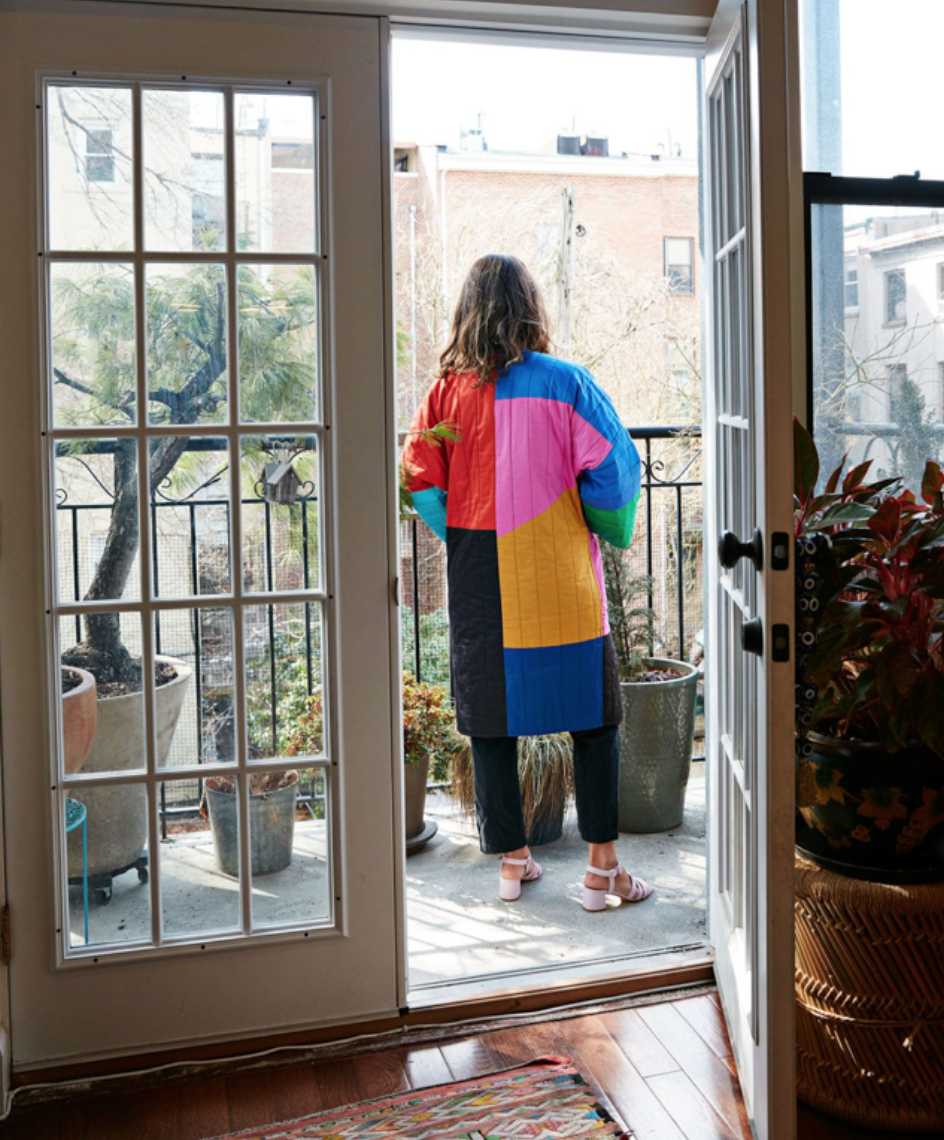
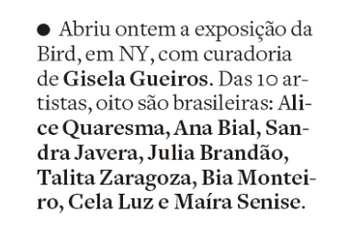

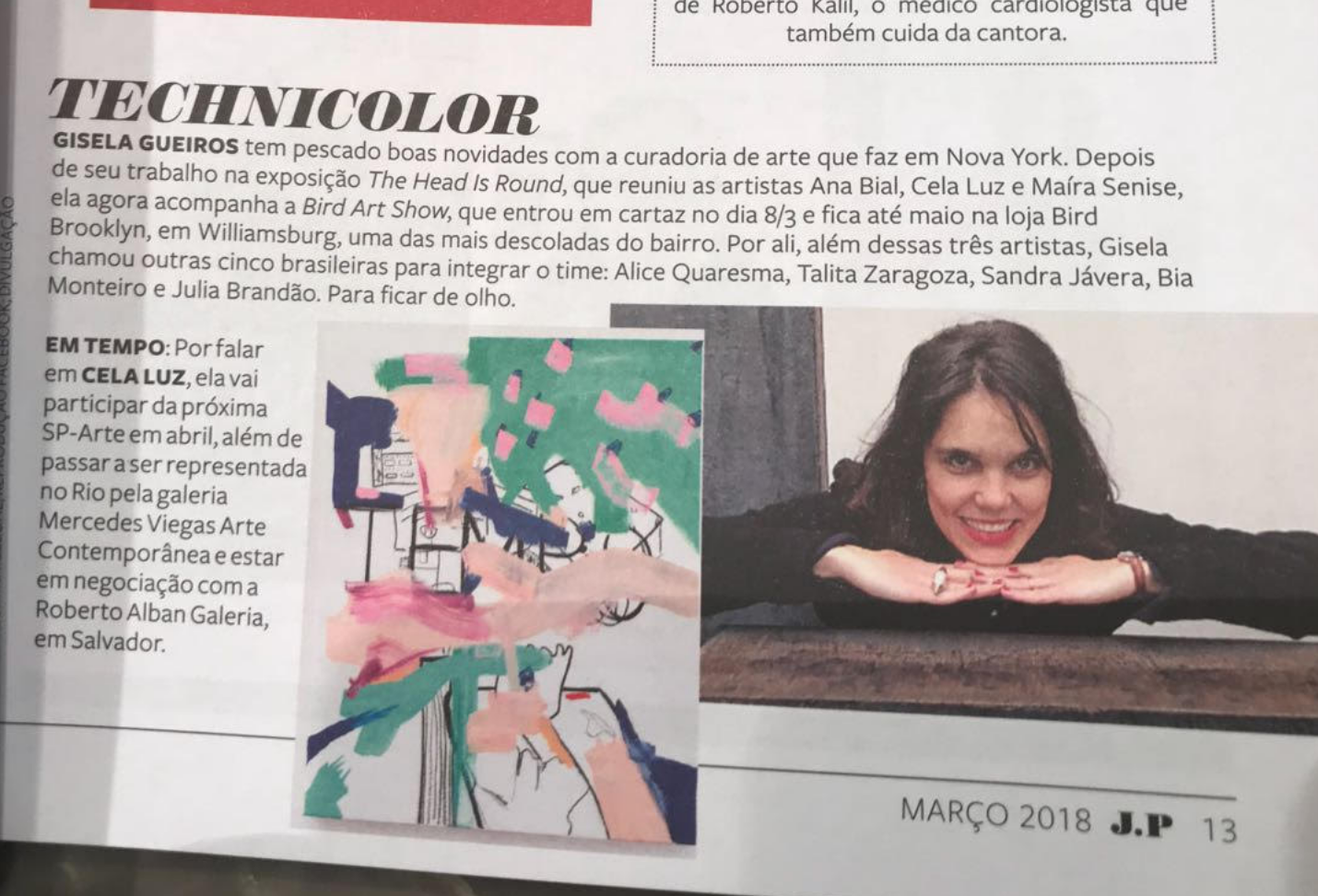
Design by Sandra Jávera
The Head Is Round | February 2018
The French artist and poet Francis Picabia wrote, “Our heads are round so that thoughts can change direction.” Inspired by the quote, this exhibition brings together paintings by artists, Ana Bial (1987), Cela Luz (1986) and Maíra Senise (1989). In the months leading up to the show, the artists and I were in constant communication, exchanging ideas. Like a white canvas or an empty stage, the possibilities were endless. The artists helped shape the show itself, as much as they made the work. It was a true collaboration.
Ana Bial
Bial creates visual collages of everyday commonplace images, presented as still lifes on canvas. The supermarket pamphlet, with its anonymous design in vibrant colors, a dry rose, left over from a job as a product stylist, each finds space and new meaning in Bial’s paintings. They are images which would otherwise be discarded. Among the quotidian, representations of her own sculptures and paintings also appear. Her work is like an archaeology of her own present.
Cela Luz
Luz’s paintings serve as stage for a dance between figurative and abstract. With a palette of strong colors — yellows, pinks, royal blue, light green, oranges and reds — the images feel insistent, and more captured by her lively canvas than placed or drawn. Even complete, the paintings feel free and loaded with potential.
Maíra Senise
Raw and rough, Senise’s paintings have the ingenuity of children’s drawings. Rudimentary imagery — such as the house, the sun, animals and misshapen figures — becomes poignant in the artist’s attempt to regain a lost purity. Senise seems to treat the oil-based paint as a pencil and canvas as paper, demystifying the entire history of painting. The result generates a strange sweetness.
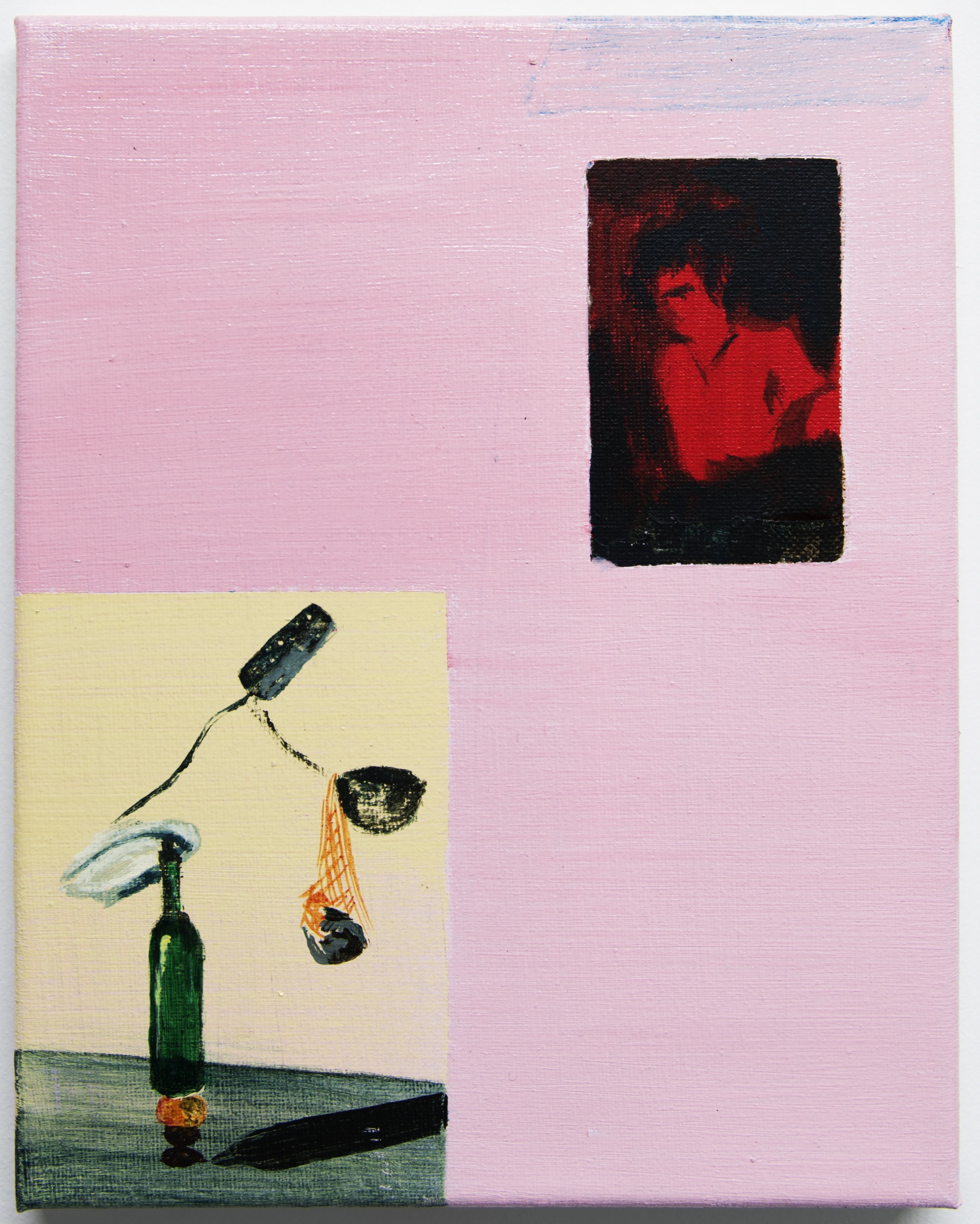
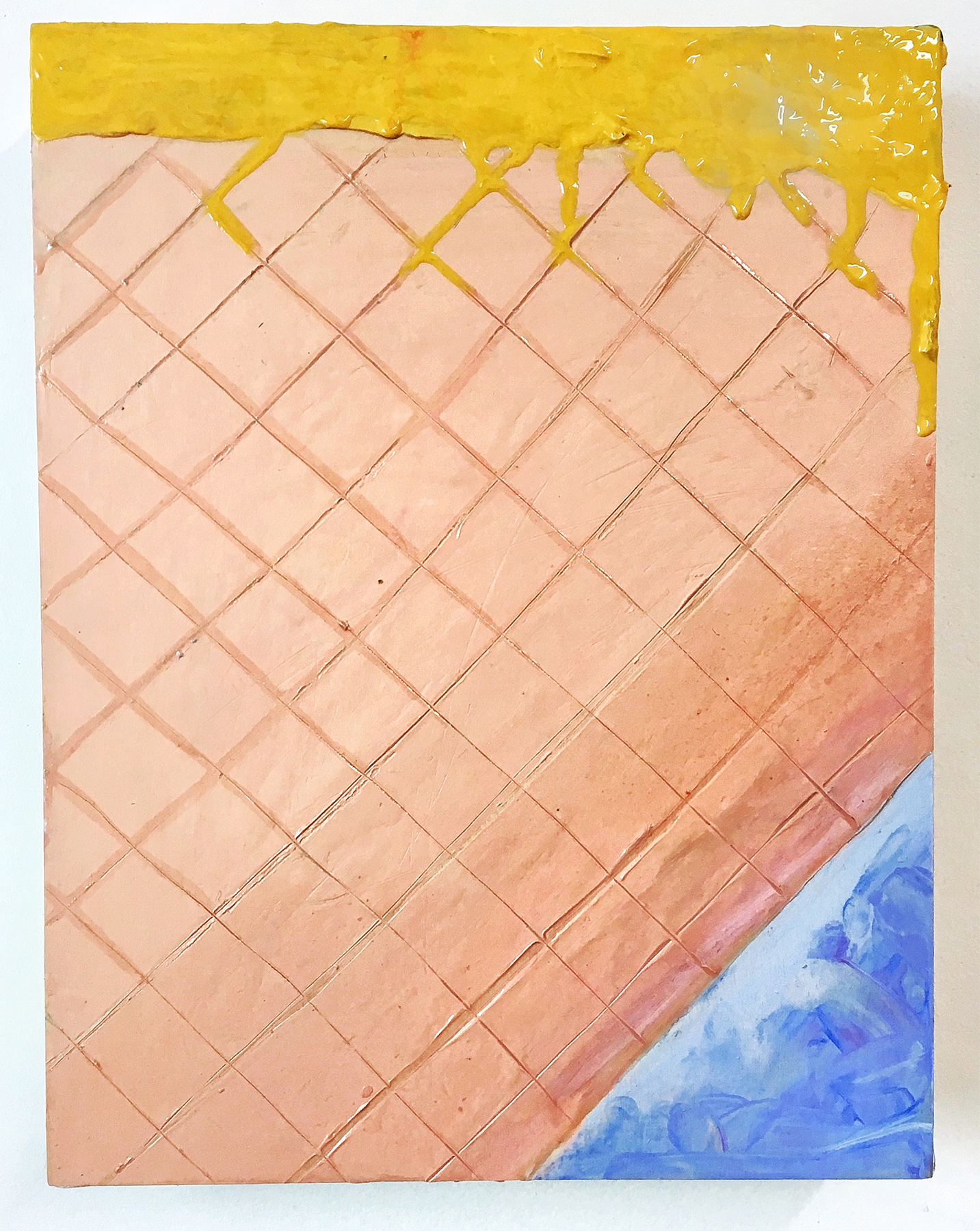
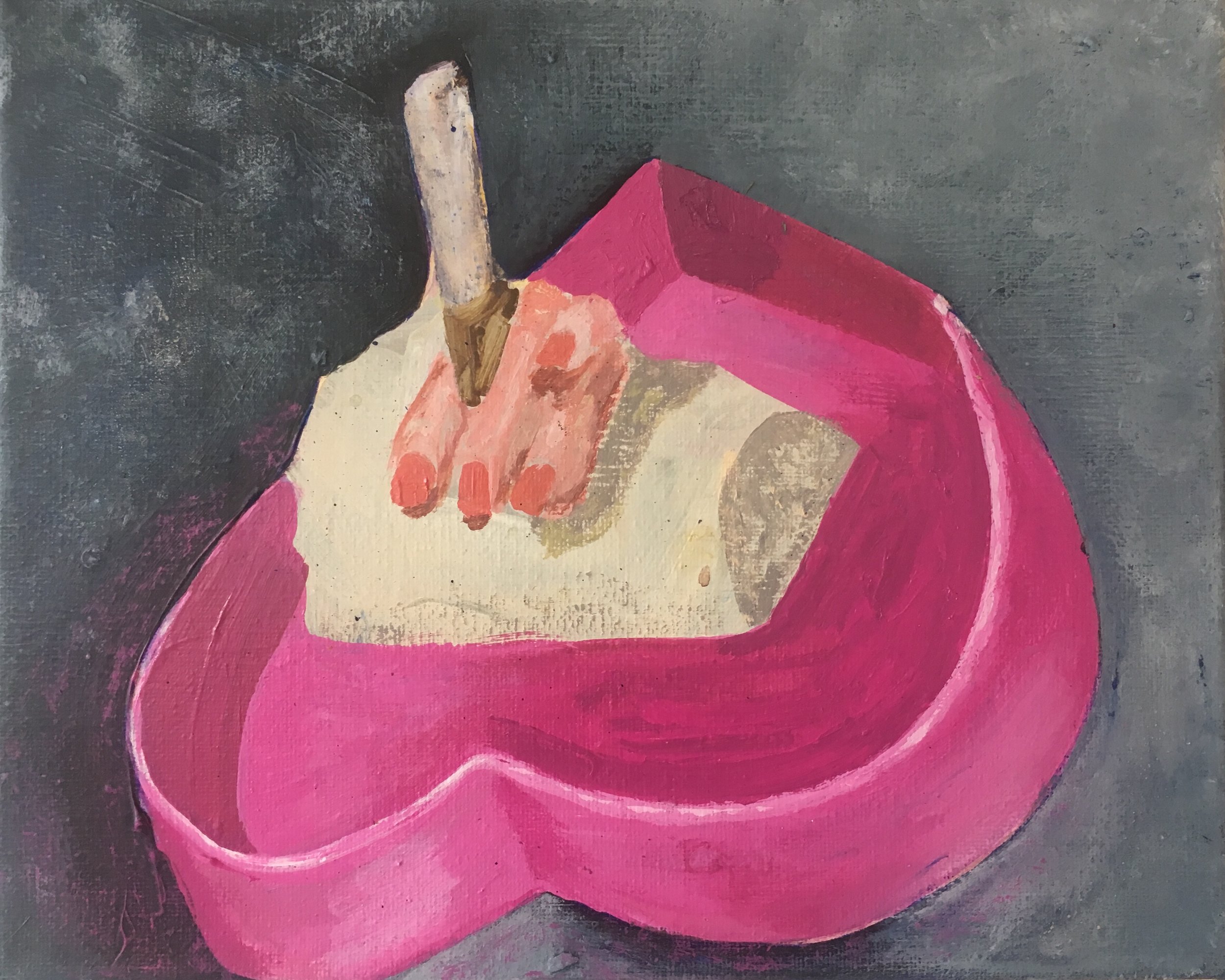

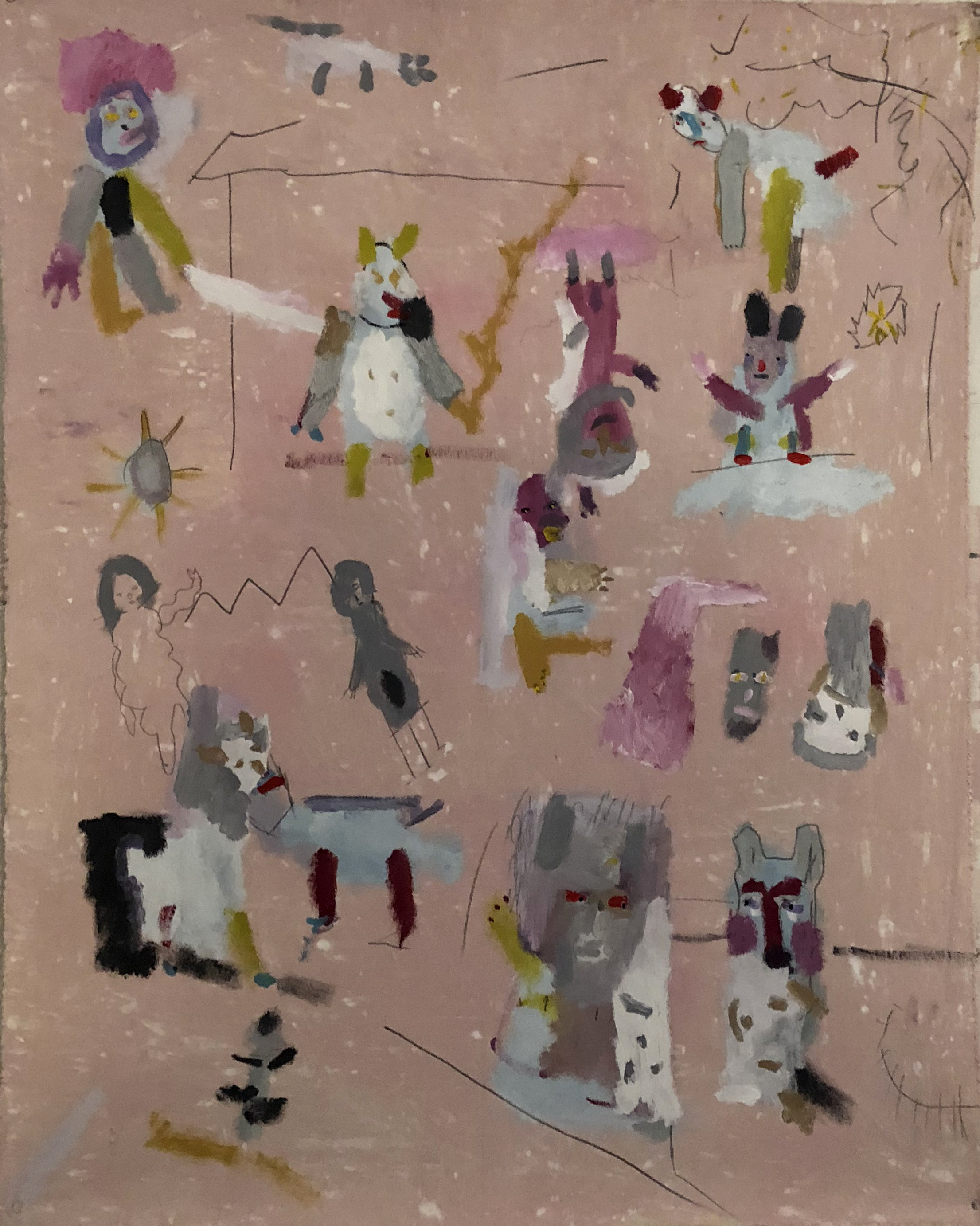
Puzzle | February 2017
“Drawing with scissors: cutting into color reminds me of the sculptor’s direct carving” – Henri Matisse, in “Jazz” (1947)
Brazilian artists Alice Quaresma and Julia Brandão’s lively compositions are at first simple and spontaneous, their beauty subtle, their geometry not perfect, as if they were innocently looking for some space in the saturated flow of images of contemporary life. But like blocks or bricks, each shape in their work seems like an essential element in the building of a solid structure.
Every bit of paper or fabric brings power and life to the dynamic of improvisation. There is a feeling of adventure or openess – a new plane where there is more room for fantasy, flexibility. The space between the shapes become an activated stage, ripe with possibility and charged with anticipation – the beauty of the puzzle. After a few attempts, the disposable may become useful again.
Carrying on the tradition begun a century ago by Matisse’s cut-outs, Picasso and Braque’s collage, and Calder’s mobiles, Quaresma and Brandão present us with a fresh new version of these explorations. Fitting handmade shapes into space, they test the limits of the medium as they get freed from the flatness of the picture.
Helio Oiticica comes to mind as well, as someone who’s fabric “Parangolés” – wearable sculptures – stimulated tactile perception and invited participation. He too let geometric shapes free, with an added tropical twist, launching perfect squares reminiscent of Malevich and Mondrian into the space through dance.
Here, with Puzzle, the artists offer us similar motivation to keep moving, to keep trying, to keep believing in the power of finding a solution.
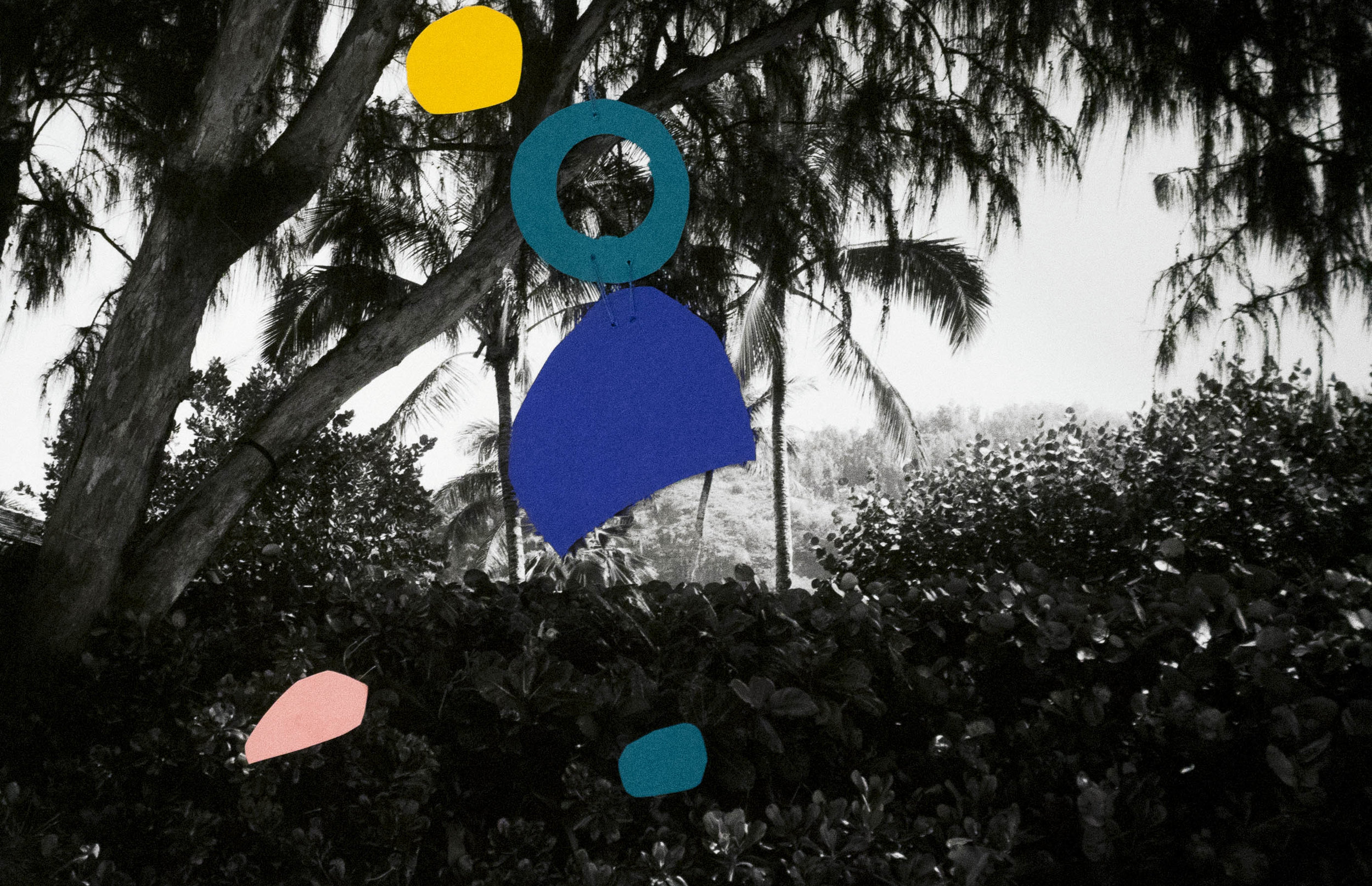
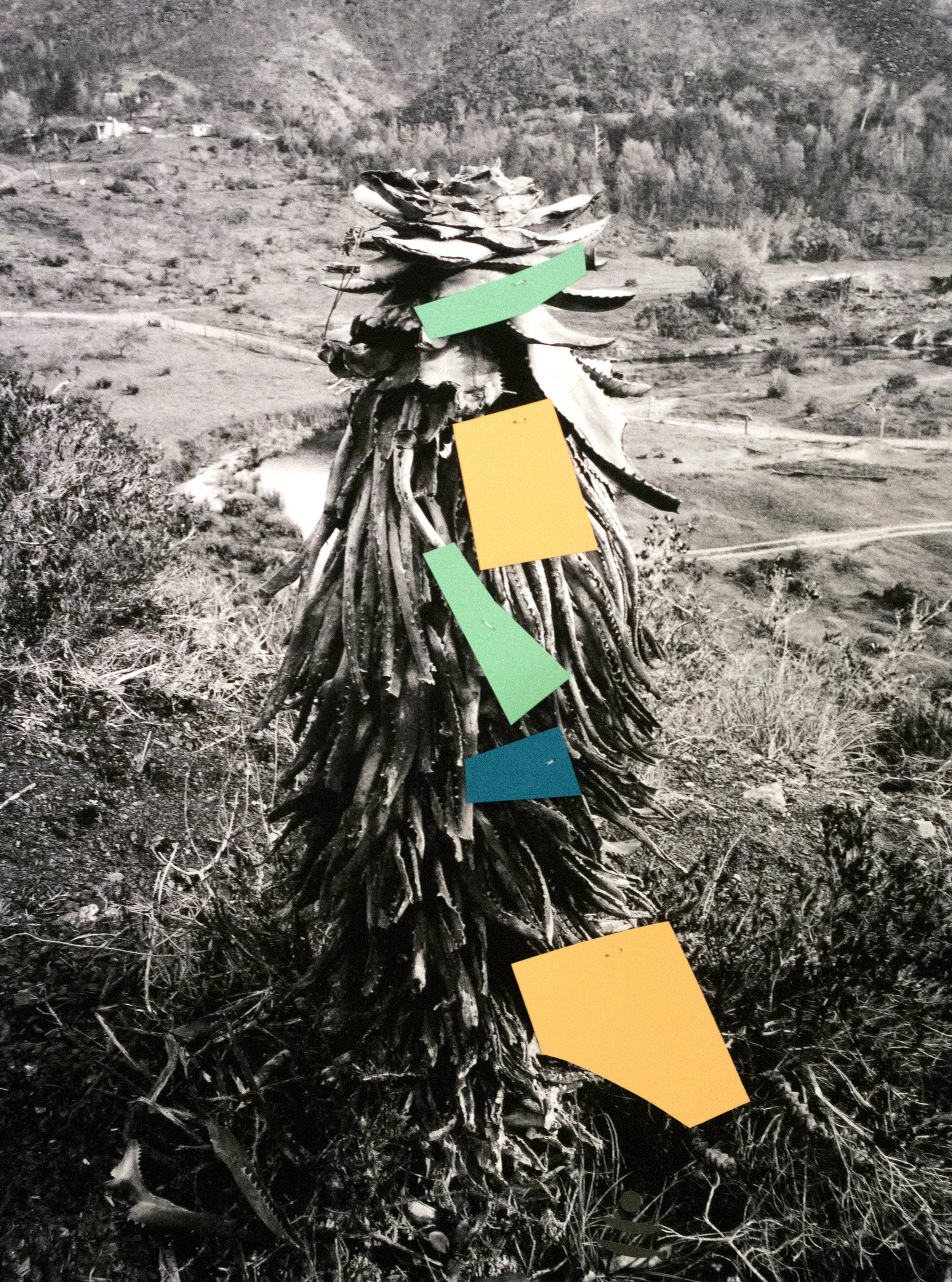
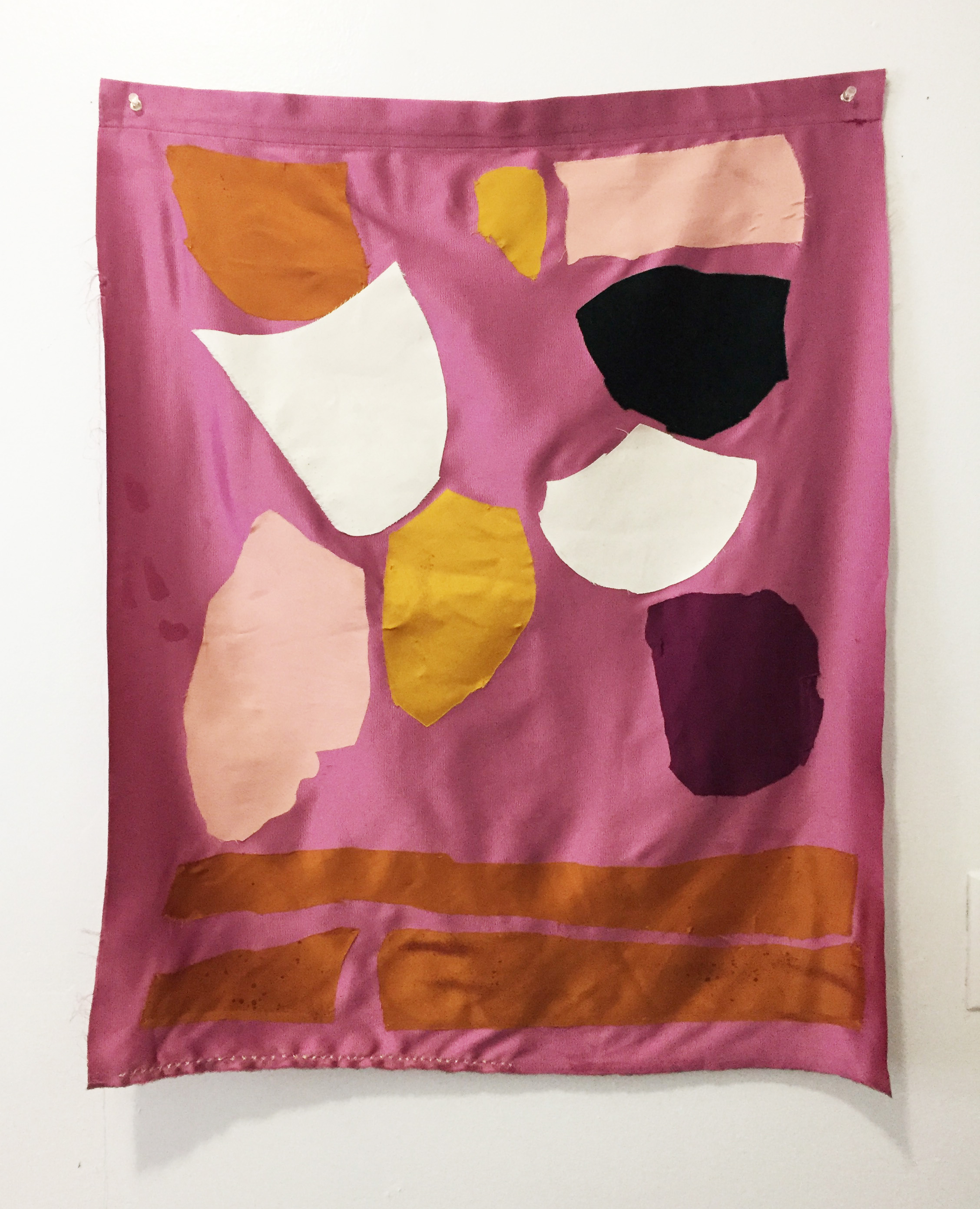

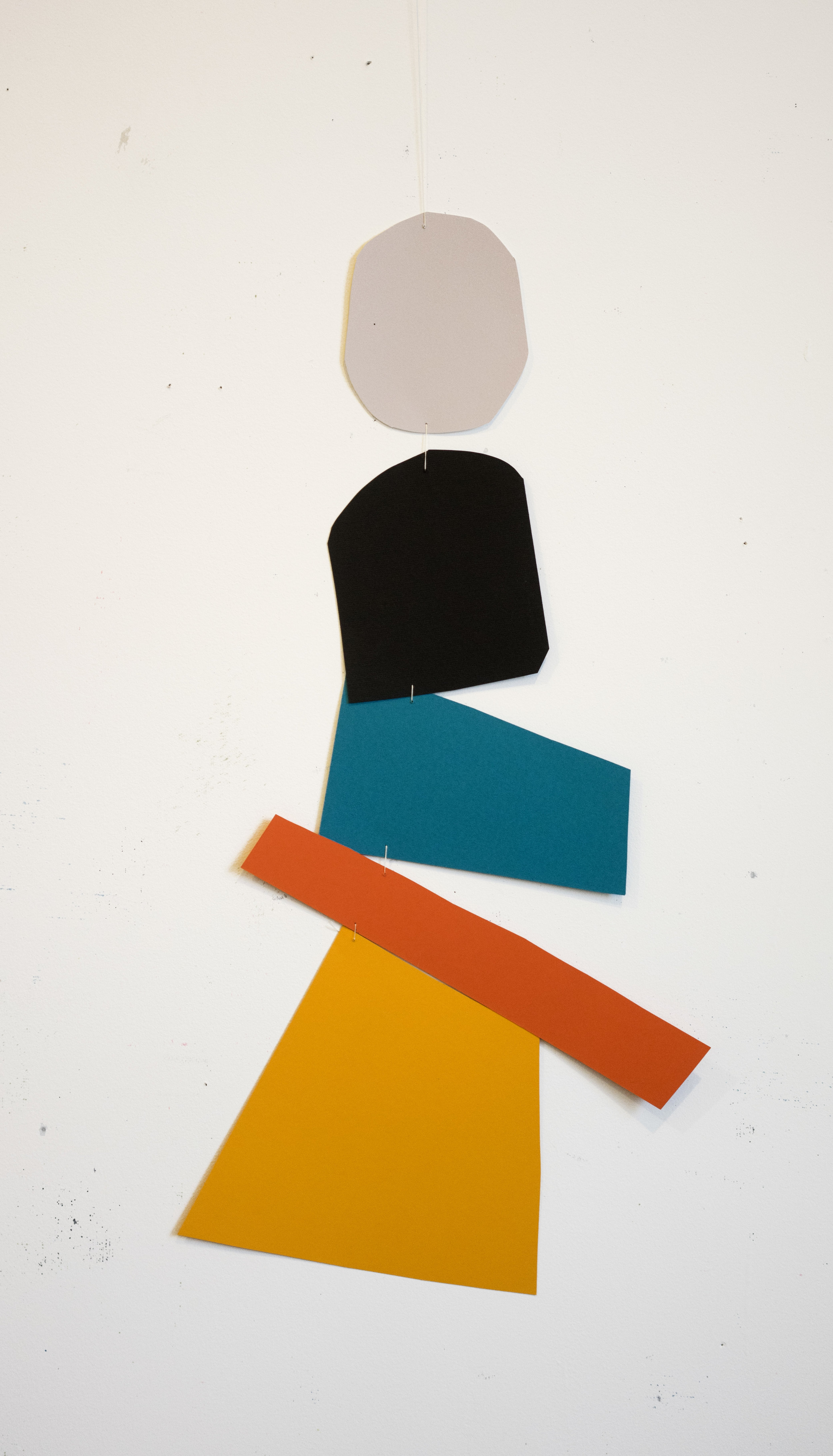
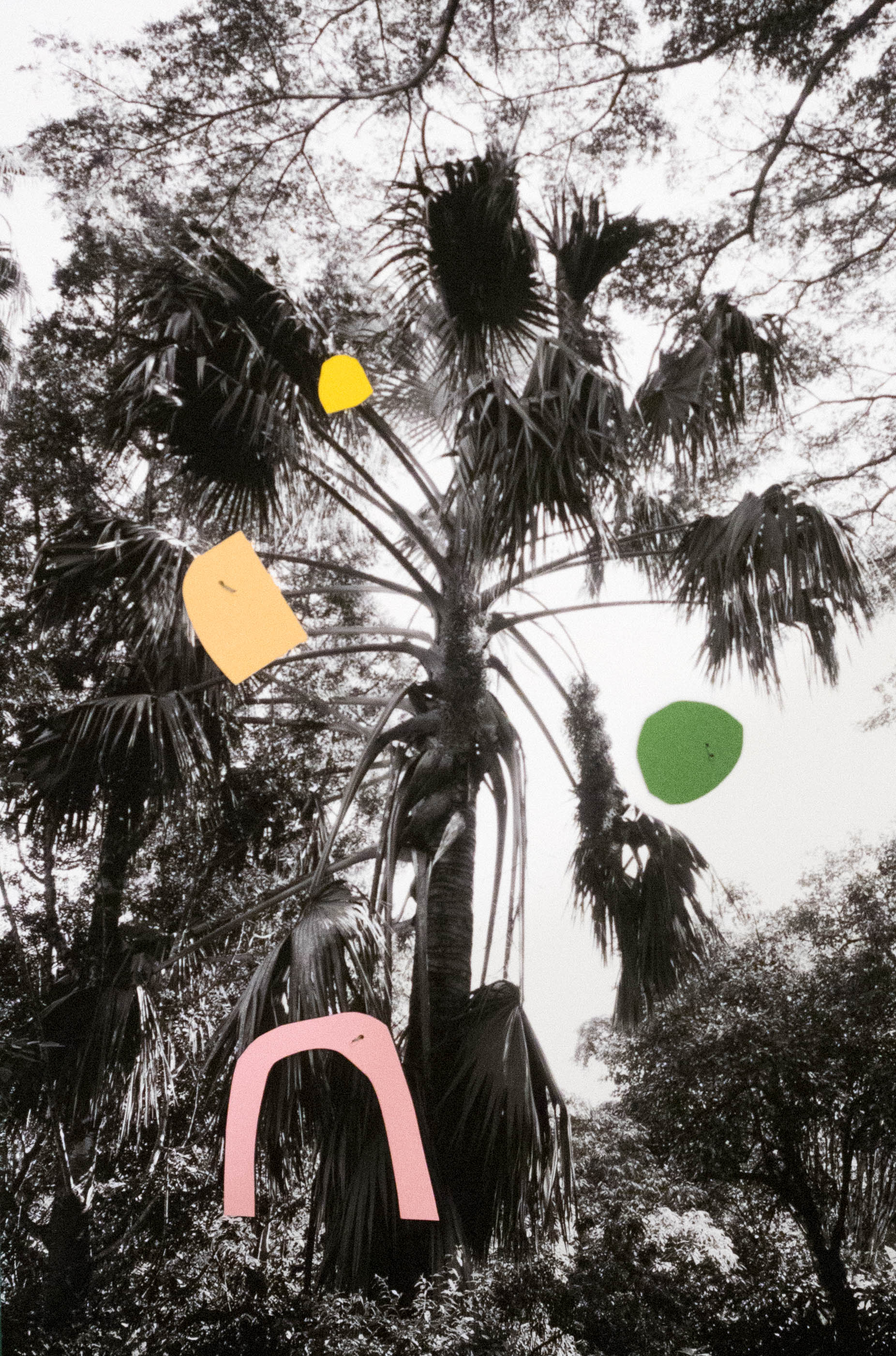
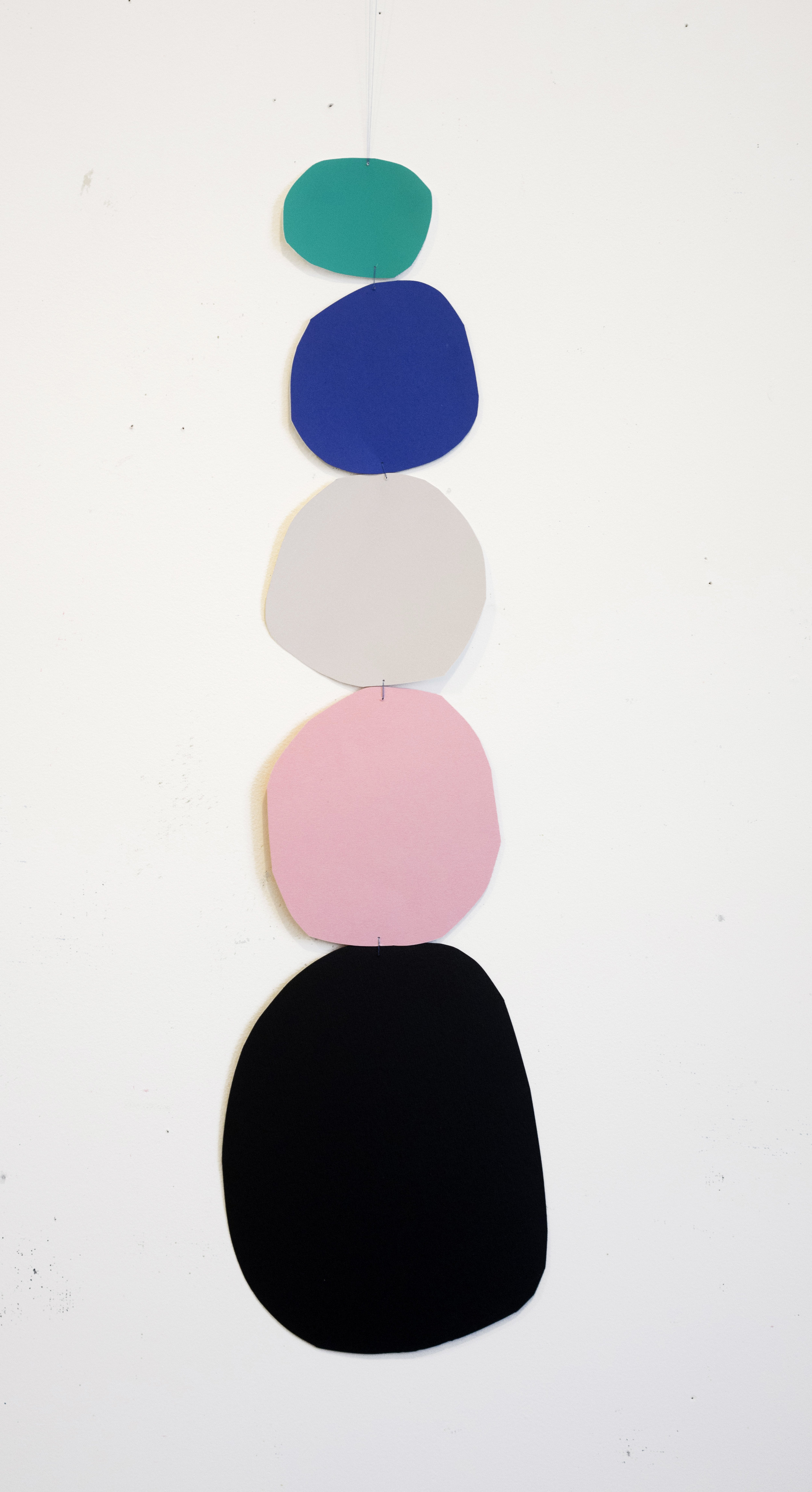
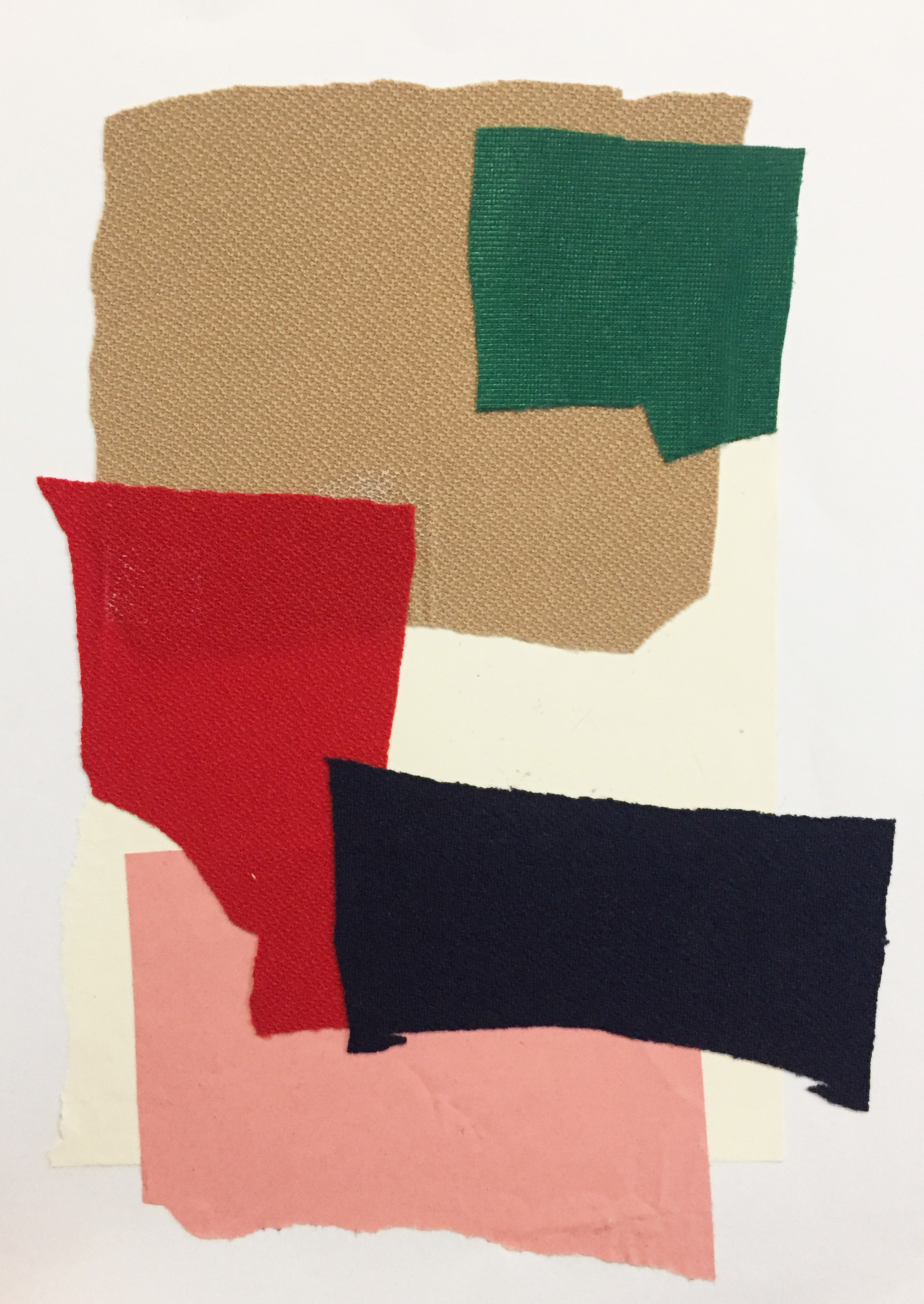
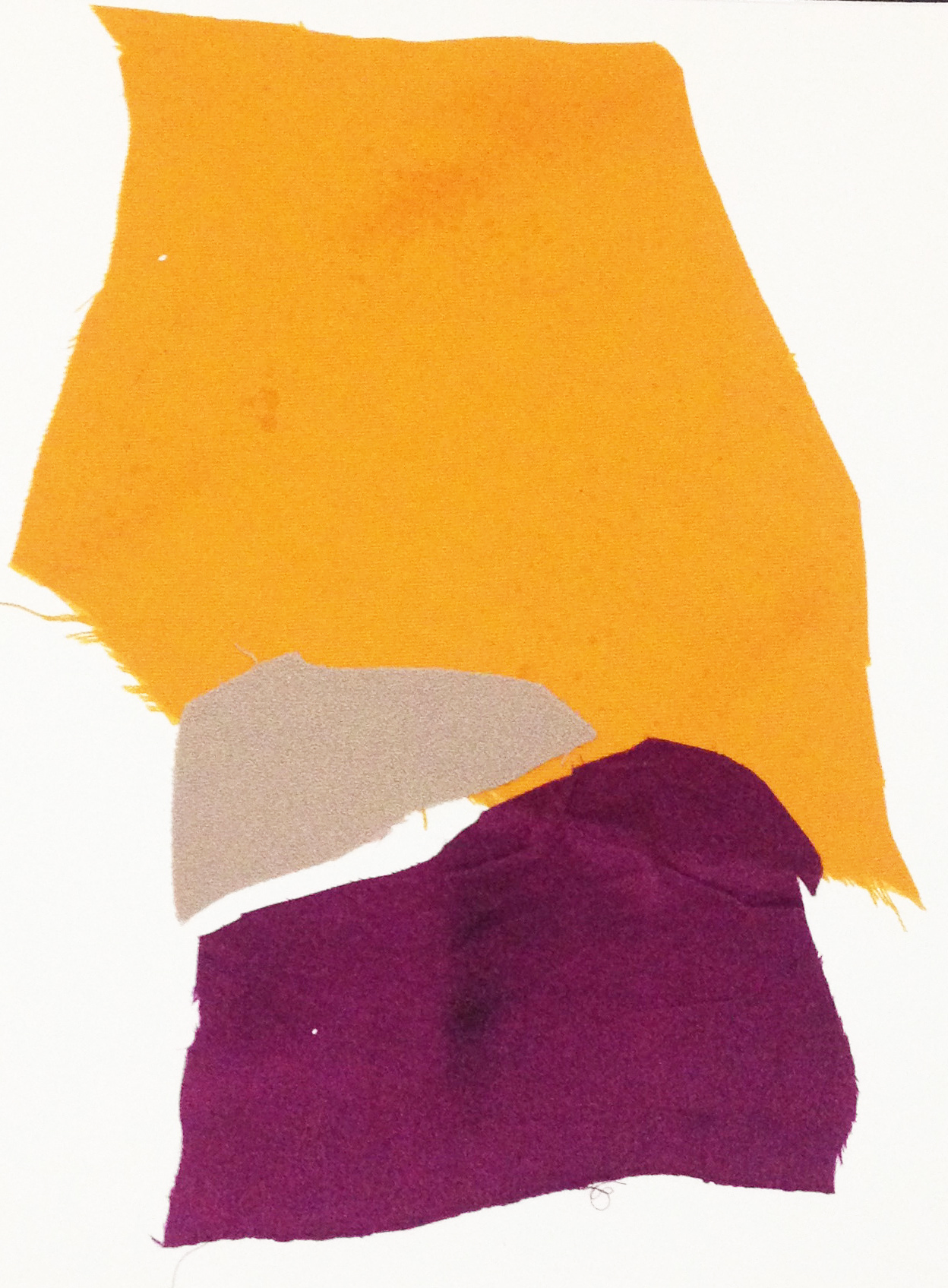
Living Things | April 2017 by Gisela Gueiros
“As animals, we humans are always part of nature” - Olafur Eliasson
Living Things presents the work of 6 Brazilian artists and their meditations on nature. In the late 18th century, Romantic artists celebrated nature in response to the dehumanizing effects of the Industrial Revolution. Today, a revolution in technology has
us more disconnected from immediate reality. Constantly looking at screens – smartphones, laptops, TVs, our avatar gets more exposure than our “real life” persona. And as we congregate in cities, we are especially disconnected from nature, and more in need of a fix. These artists are each consumed with this crisis.
André Feliciano creates sculptures that delight by collapsing the image and its making. Imagine the hordes of snapshots taken as cherry blossoms bloom. There could easily be one camera per flower on a sunny spring day at the Botanical Garden. Feliciano, as an art-gardener, has simply fused the two - literally readymade photographic blooms. A humurous but pointed reminder of how we now see so much of life through our cameras/phones.
Talita Zaragoza shows us two different ways in which she mediates nature. In some works, she interferes in the landscape before photographing it, marking her presence in front of and behind the camera. In others, she makes her marks on the photograph itself, layering the mediation of nature. Further, her subject is sometimes a landscape that has been previously transformed by man. Each layer in her work brings awareness to the long-lasting influence of our presence on the natural world.
In another act of layering, Andrea Rocco’s paintings are sourced from her great grandfather’s collection of Natural History books. For this work, she is especially interested in images from fables and Mughal paintings, from South Asia. Seeing representations of nature that , in fact, come from a book feels like a strangely contemporary exercise.
Ricardo Alves had every opportunity to work directly from nature. While walking on the campus of São Paulo University, he saw plenty of banana trees. He had even sketched a banana tree and hung it in his studio. But he found he wasn’t interested in the plasticity of the real thing. It was only when he found a representation of the tree in a botanic illustration book that he found a way forward to make the painting.
Sandra Javera reveres the idea of nature always unfolding – every day spent outside is an invitation to discovery. By focusing on roots, her work serves as a reminder of their invisible but grounding importance. It is a strong root that allows a branch to reach out further.
Liana Nigri works in the subtle liminal space between natural and artificial, real and re-creation. The bacterial colony, originally used as biofilm to “clone” recognizable organic forms – leaves in Nigri’s case –, became the raw material with which the artist develops embryonic studies. Lab research allows her to create a second skin, an artificial epidermis that carries memories of another life.
As the exhibition reunites these different views of nature, a stroll in the gallery gives the visitors the chance of pretending they are just out for a walk in a garden. Stopping for a closer look in this garden, however, shows we never stop learning from nature – or from art.
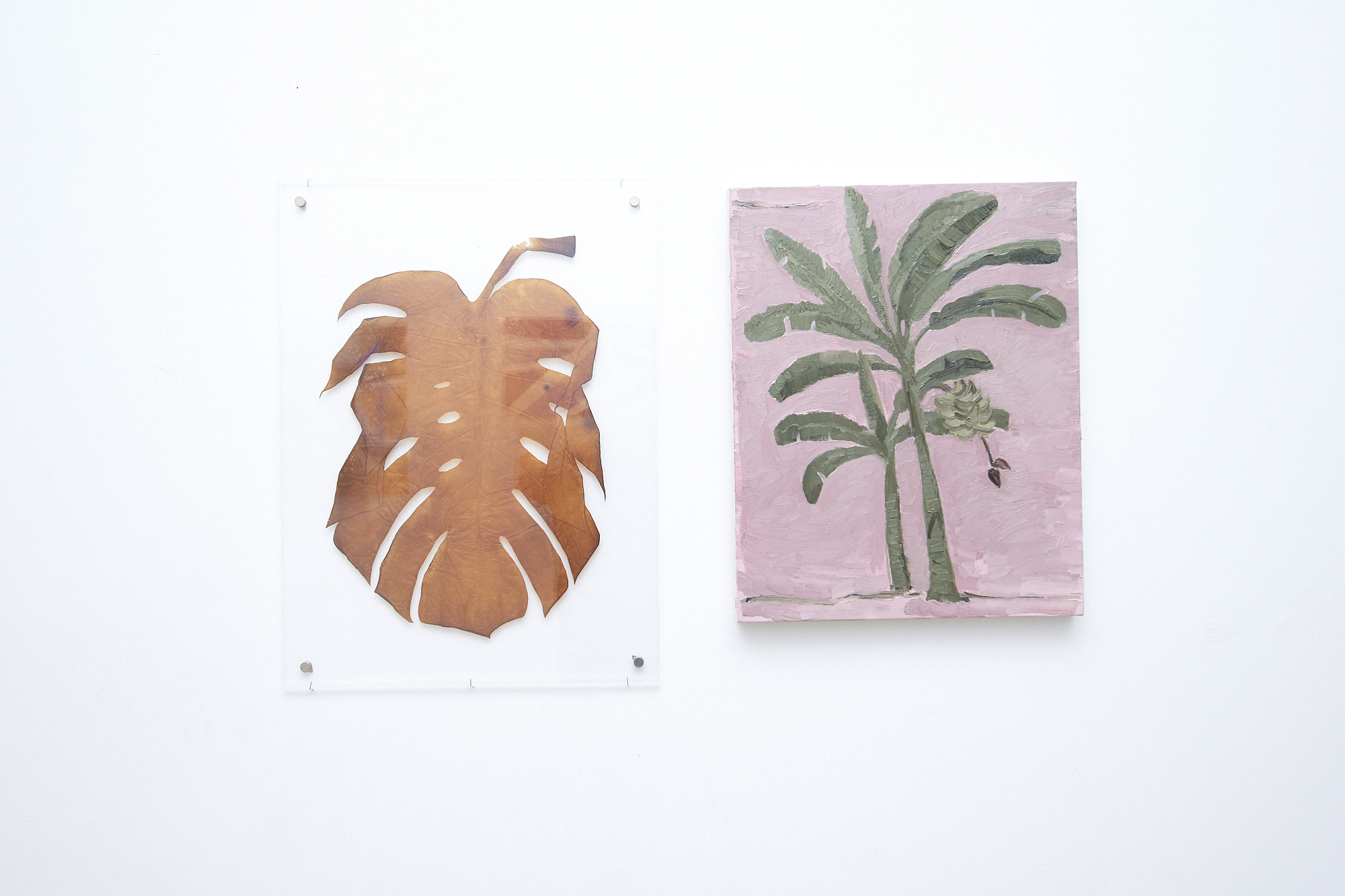
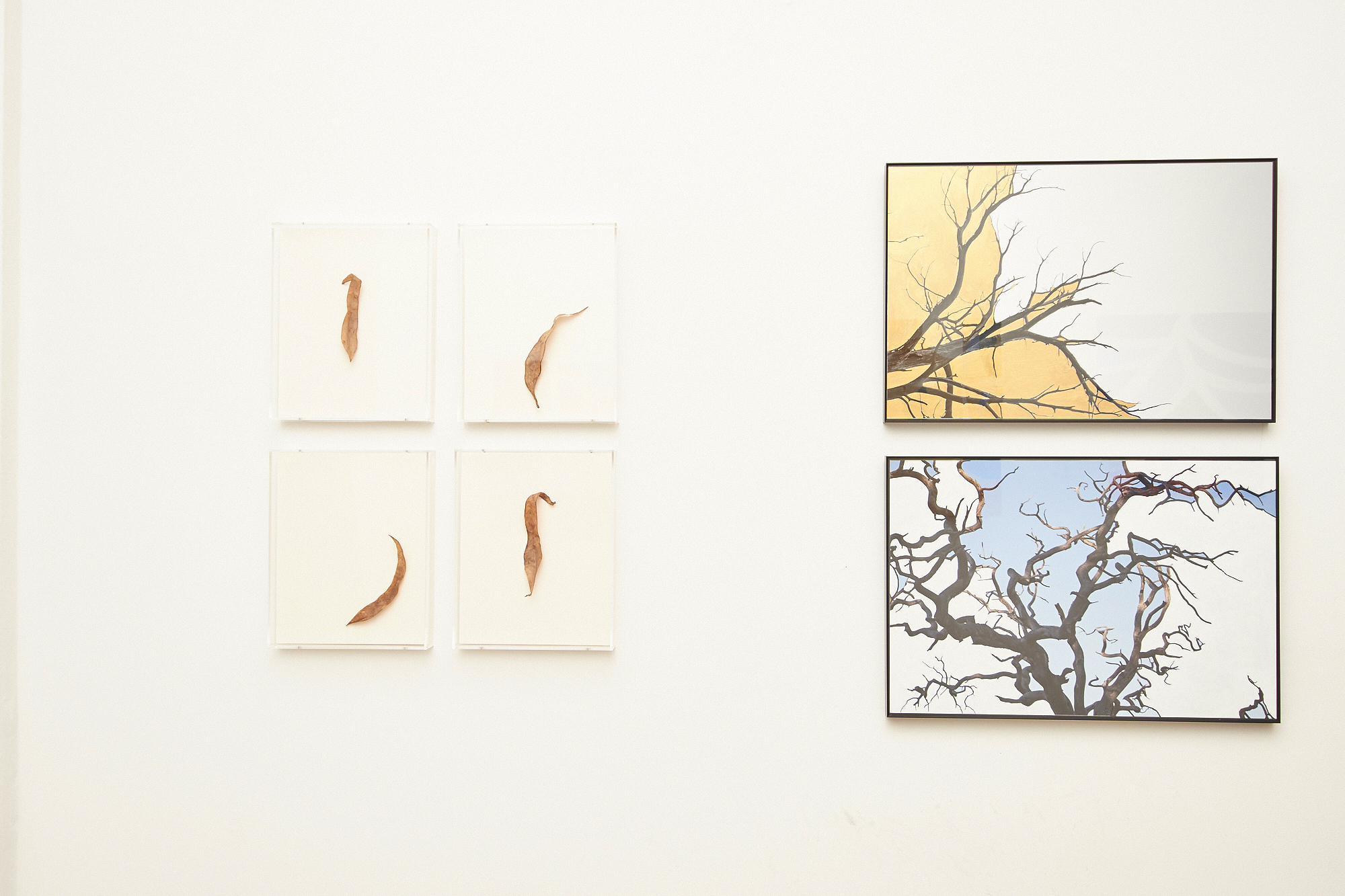

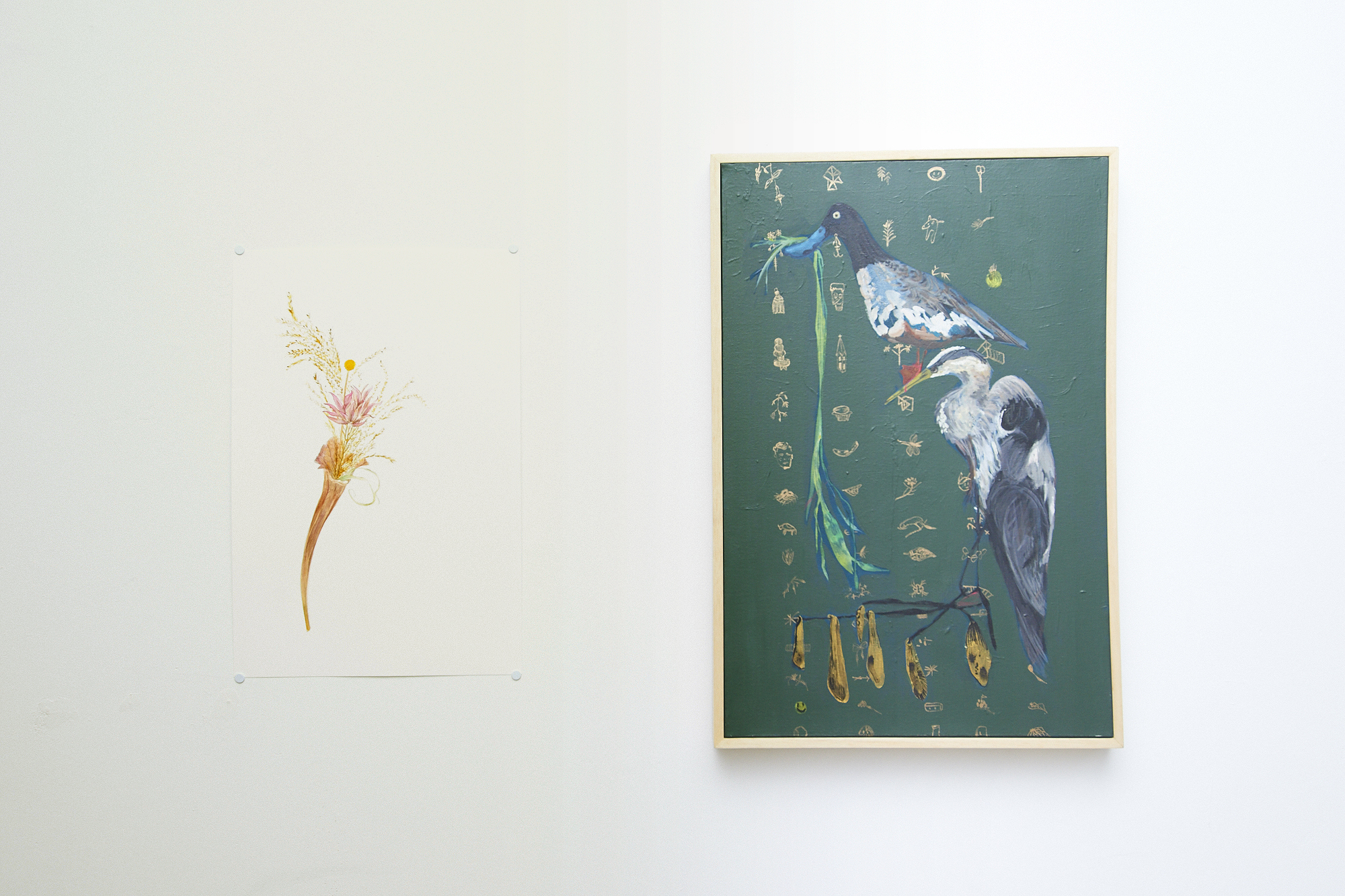
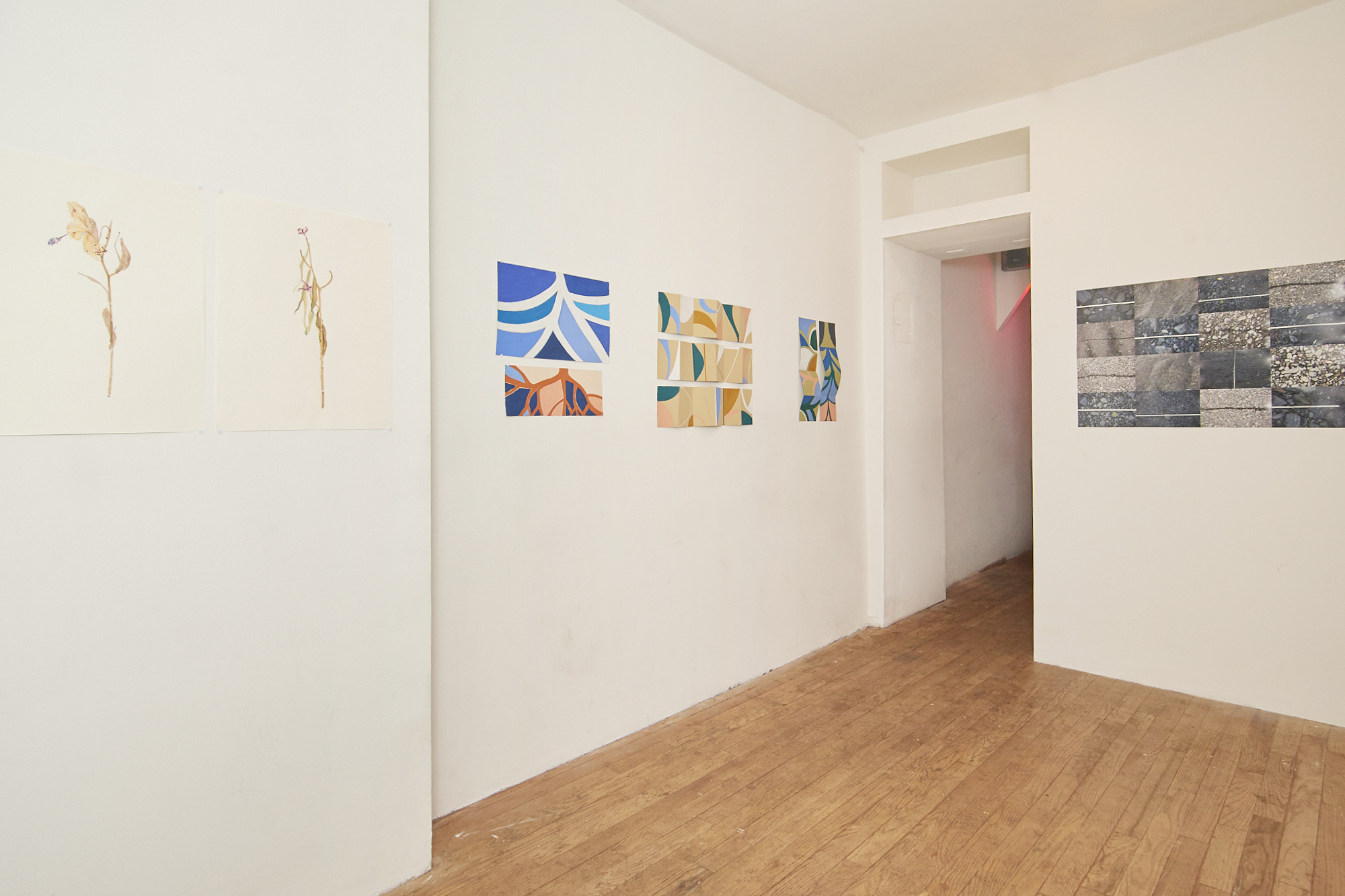

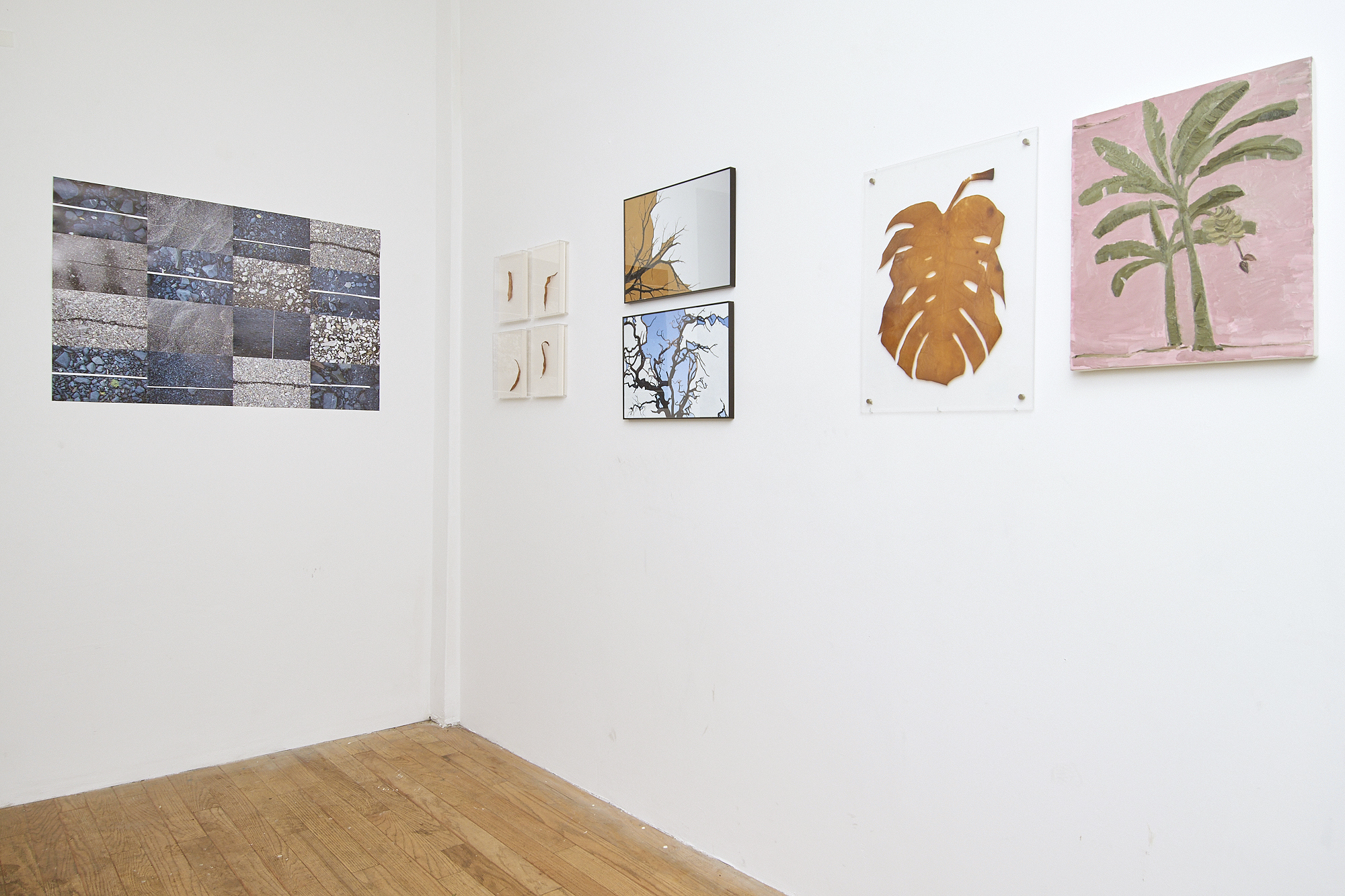
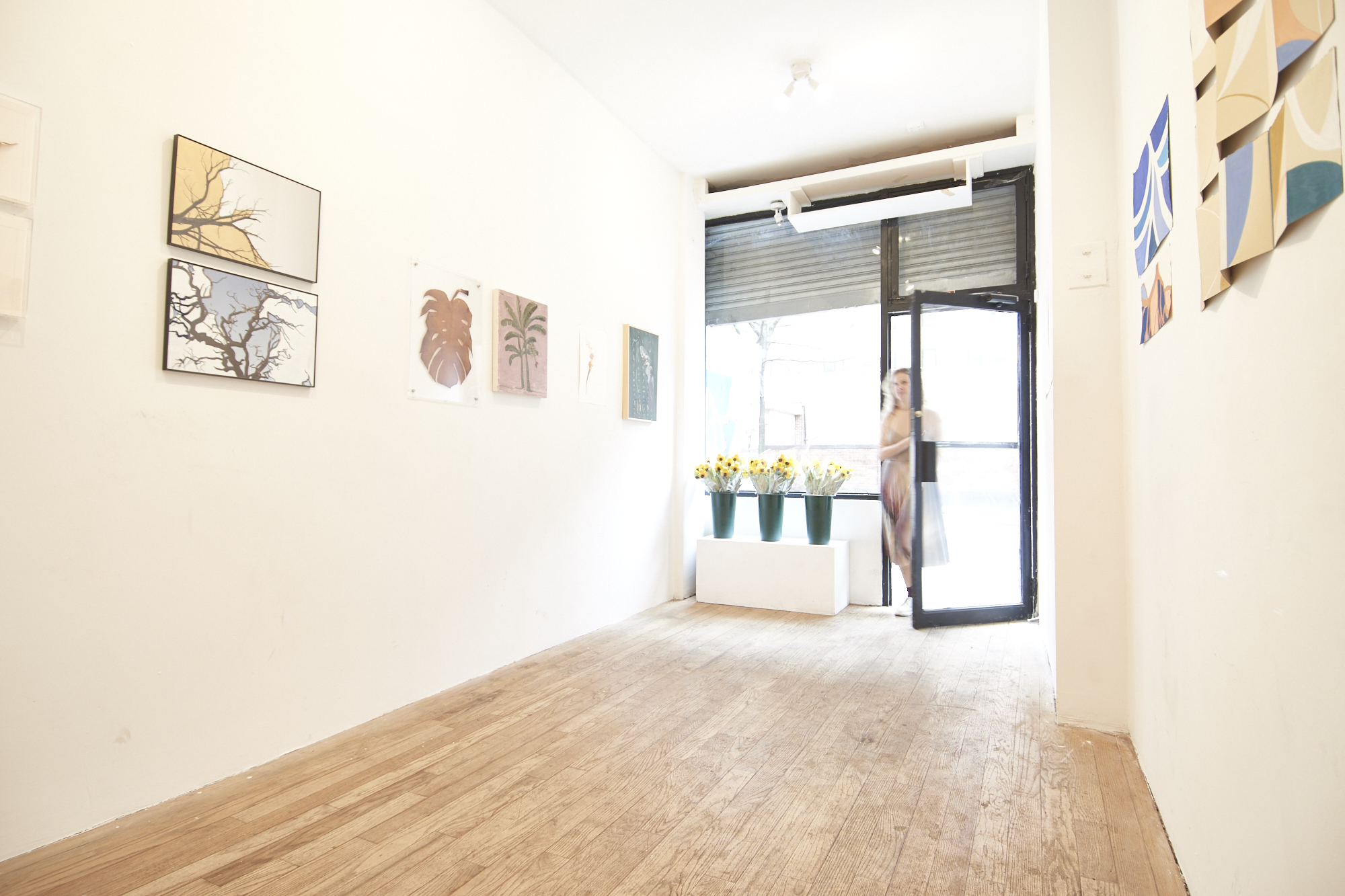
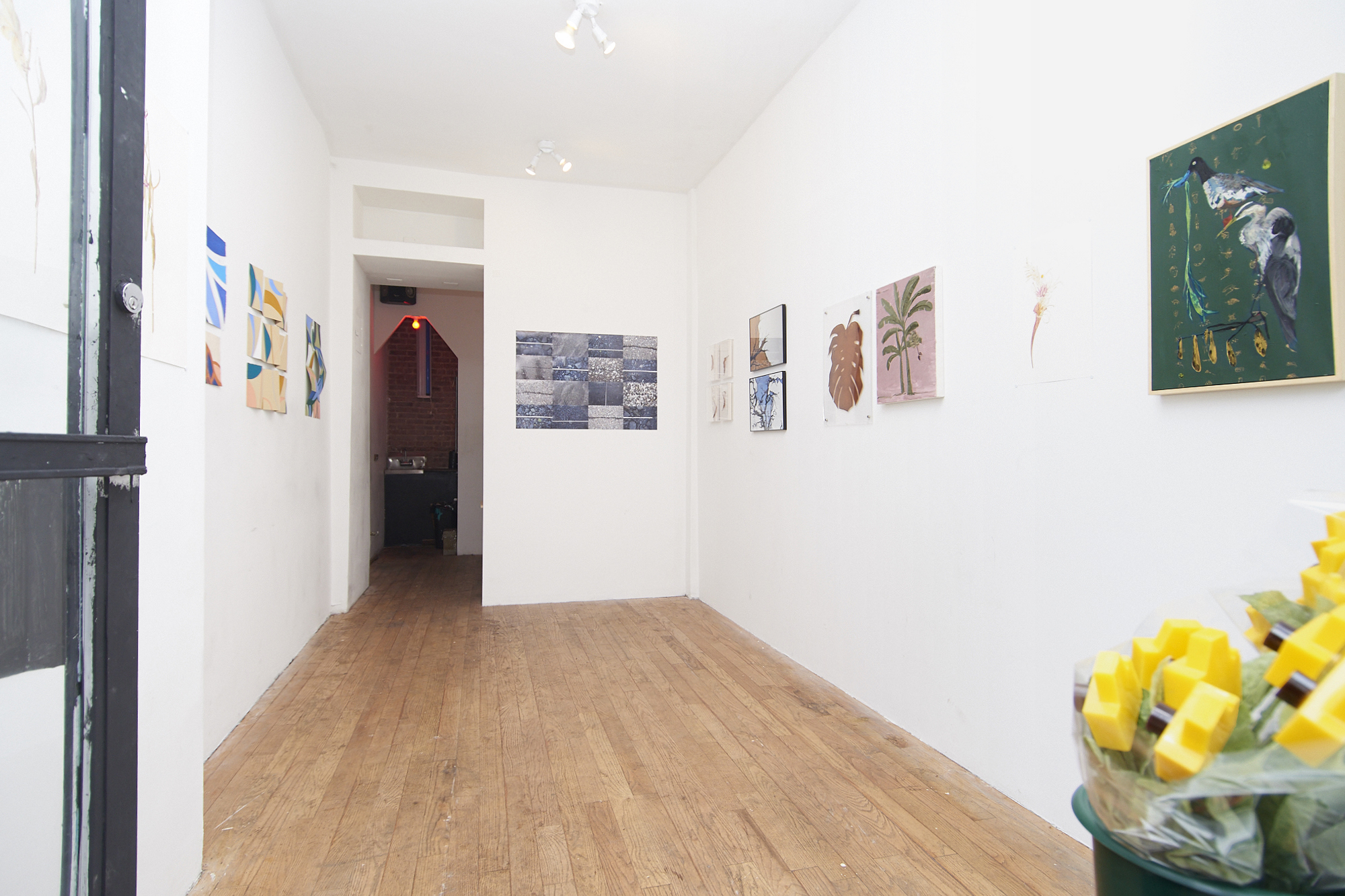

Photos by Caio Ferreira
Design by Sandra Jávera
Procession
Curated by Gisela Gueiros
Pop-up show // October 21st 2016 // From 7-10PM // Foley Gallery
“Walking is the right speed to understand”
Frédéric Gros
This exhibition dialogs with Frédéric Gros’ book A Philosophy of Walking. Nine Brazilian artists are part of
this ‘procession’. Their works relate to or incorporate concepts explored in the book – such as strolling, repetition, nature, presence, and the urban landscape.
In Sandra Javera and Alfonso Simelio’s mobile Stepped Gravity, 2016, we get a sense of the effortlessness of walking and its repetitive, fluid and monotonous movement. As dull as it can be, it is never tiresome. It may become a visual mantra in the same way that walking can be done for nothing: just to connect us to the pace of time passing.
Gustavo Prado presents us with Untitled, Contortionist series, 2016, reinterpretations of Lygia Clark’s participatory Bichos. They remind us of the traces a path leaves behind or a trail to follow. “To get there you must walk: walking in itself, as it takes time, establishes presence”, states Gros. They represent both endless possibility and the cycle of repetition.
Talita Zaragoza takes long walks herself in order to reach the places she photographs. The photo So Long, 2016 was taken this summer in Alaska and seems like the perfect conclusion of a hike. As Gros beautifully puts it, “Once you no longer expect anything from the world on these aimless and peaceful.
walks, that is when the world delivers itself to you, gives it self, yields itself up.” Her drawing (Sfumatto, 2016) evokes topographical maps and the romantic dream of exploration.
To walk in nature, the writer reminds us, is to be perpetually distracted. Trees, flowers and the colors of the roads greet you and demand attention. Sandra Bacchi pays homage to two different trees in Untitled 7 and 8, Anatomy Series, 2016 which almost look like Courbet’s L’Origine du Monde as they open up generously and powerfully to the sky. “You are facing a mountain, walking among great trees, and you think: they are just there. They are there, they didn’t expect me, they were always there. They were there long before me and they will still be there long after me”, says Gros.!
In a similar way, Gabriel Giucci uses graphite to depict a series of subtely differing rocks (Nero Marchina 1, 2, 3, 4 and 5, 2015). An observant walker knows that the shapes in nature, the stones, the bark, the leaves, the scents in the air differ from one another. The pace of each step gives us time for understanding the details that make everything unique.
Luiz d’Orey, with Untitled 27, 28 and 29, 2016, represents the flaneur in the context of this exhibition. A sensitive investigator of the urban environment, d’Orey begins by collecting remnants of posters being glued, removed or overpainted on construction fences. He later transforms these recycled bills into a two- dimensional representation of the actual building being contructed behind these walls. The multi-layered process focuses attention on the boundary between public and private, chaos and order.
In Gros’ thinking, walking causes absorption. Thalita Hamaoui’s dreamy paintings (These Memories Were Not Mine I and II, 2016) are intense but quiet, reminiscent of the mind that is emptied after a long walk. “You are finally hearing what has no vocation to be retranslated, recorded, reformatted. Before speaking, a man should see”, recommends the author.
Alice Quaresma noticed that she was letting her works travel independently as she mailed them to residencies, clients, and exhibitions around the world. The shipping boxes where she packed her work (From Inside Out I and II, 2016) are icons of portability and transit. Somehow, the bureaucratic poetry of postal handling mimics our own traveling experiences as we wonder.
L’Affaire
Gisela Gueiros
March 2015
The idea behind this exhibition is a romantic one. Wife takes over the table with ceramic sculptures, while husband occupies the wall with watercolors. Interestingly enough, in Lisa Schilling’s stoneware we see vases opening up as if they were peeling – multiple layers protecting whatever this vessel will hold. And on Eric LoPresti’s CD-sized variations on New Order’s 1983 album cover Power, Corruption, and Lies, roses seem to be blooming, exhaling their scent and sensuality through paint. Shown together, their works create a beautiful dialogue where we are welcome to imagine what they exchange. But it also becomes clear that whatever is happening here belongs to a much more intimate setting that we will never witness.
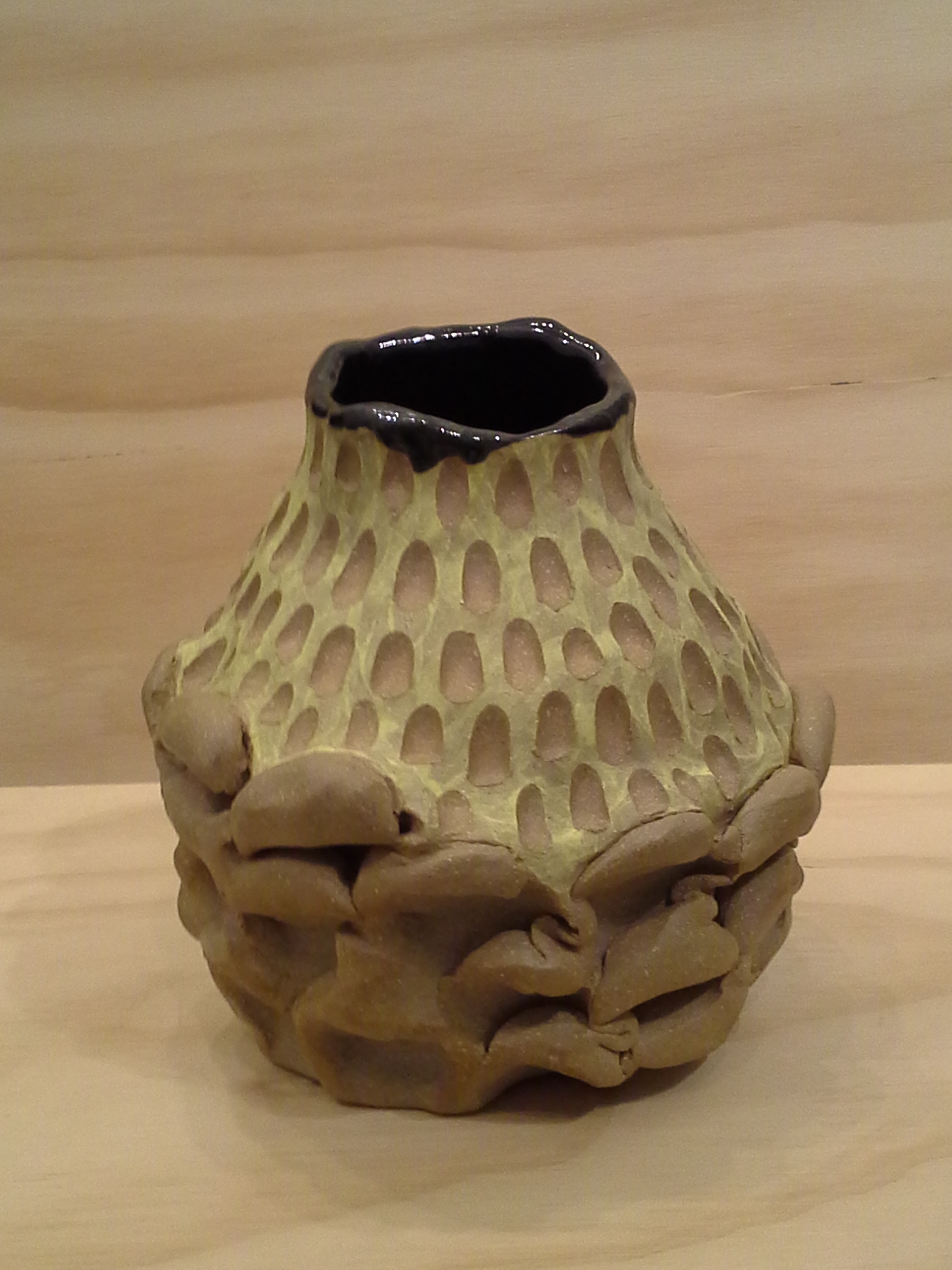
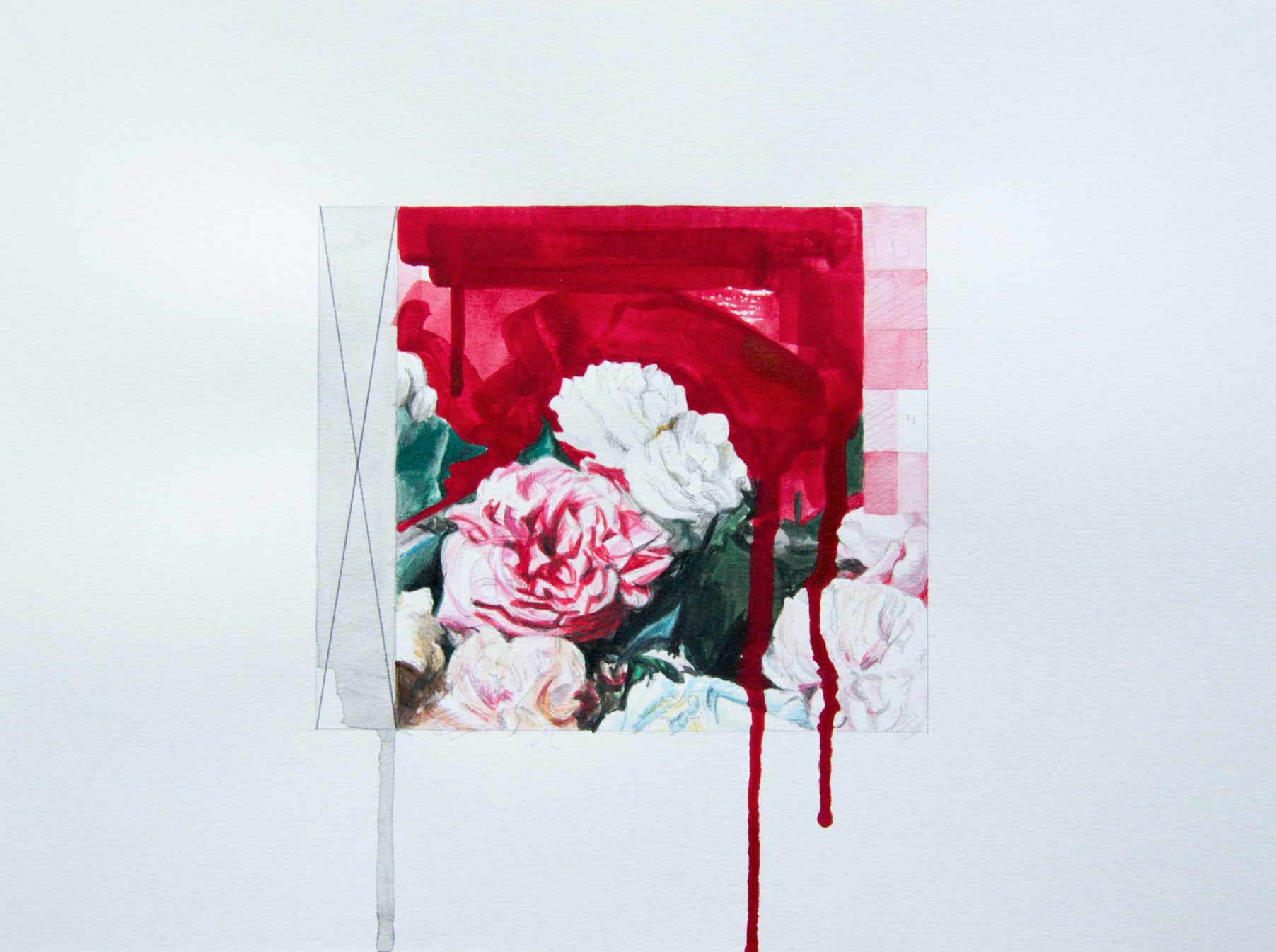

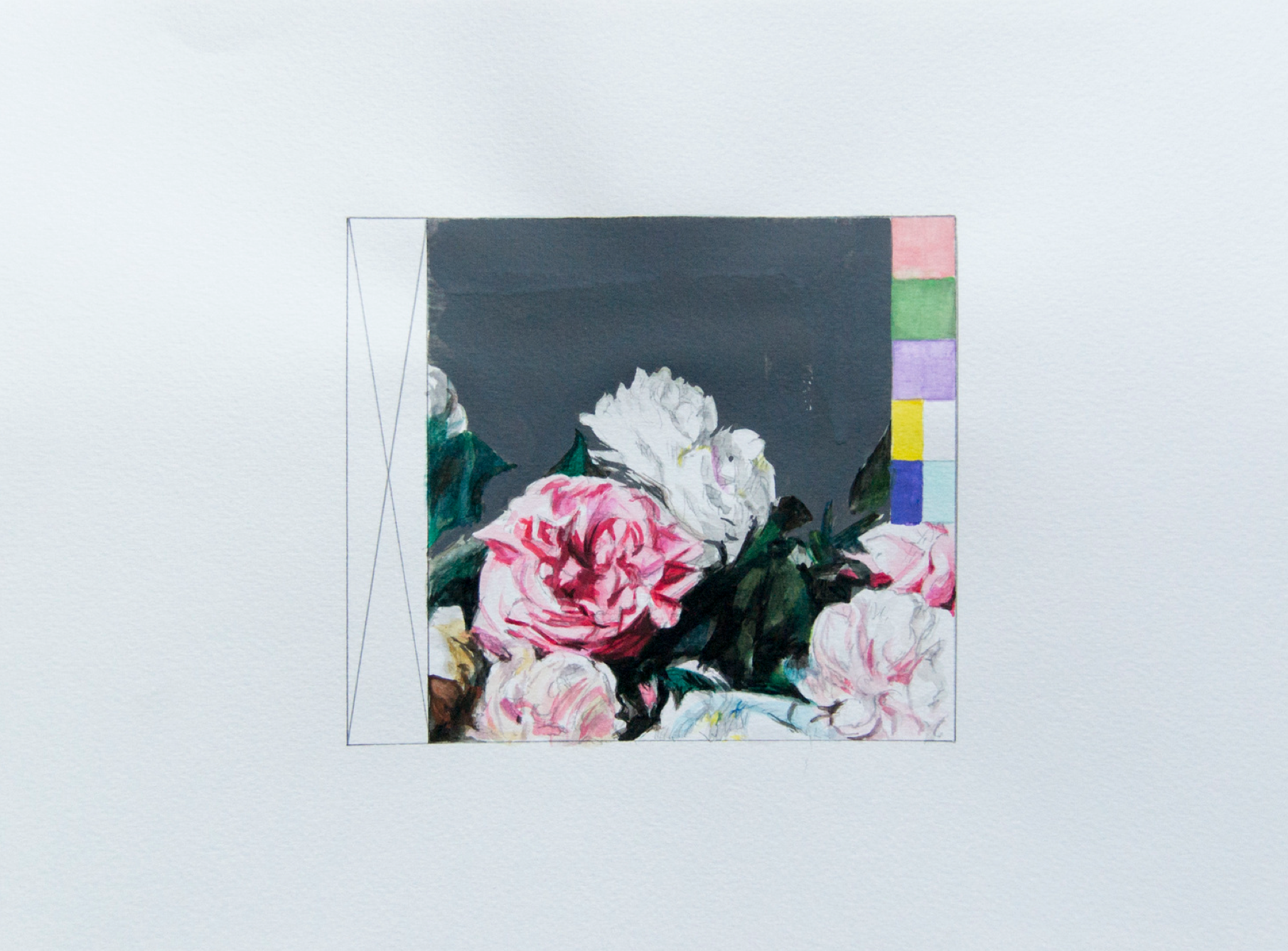
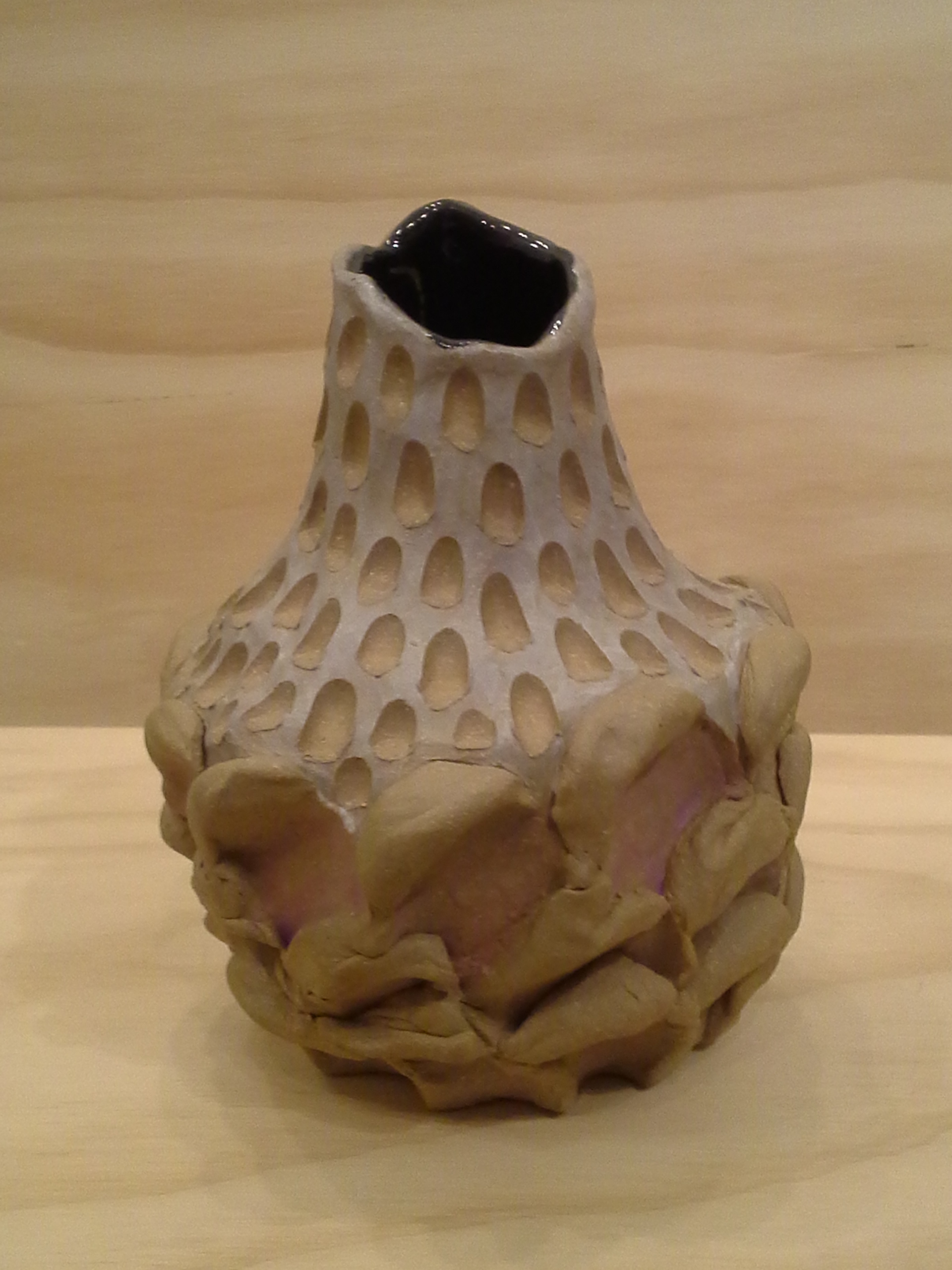
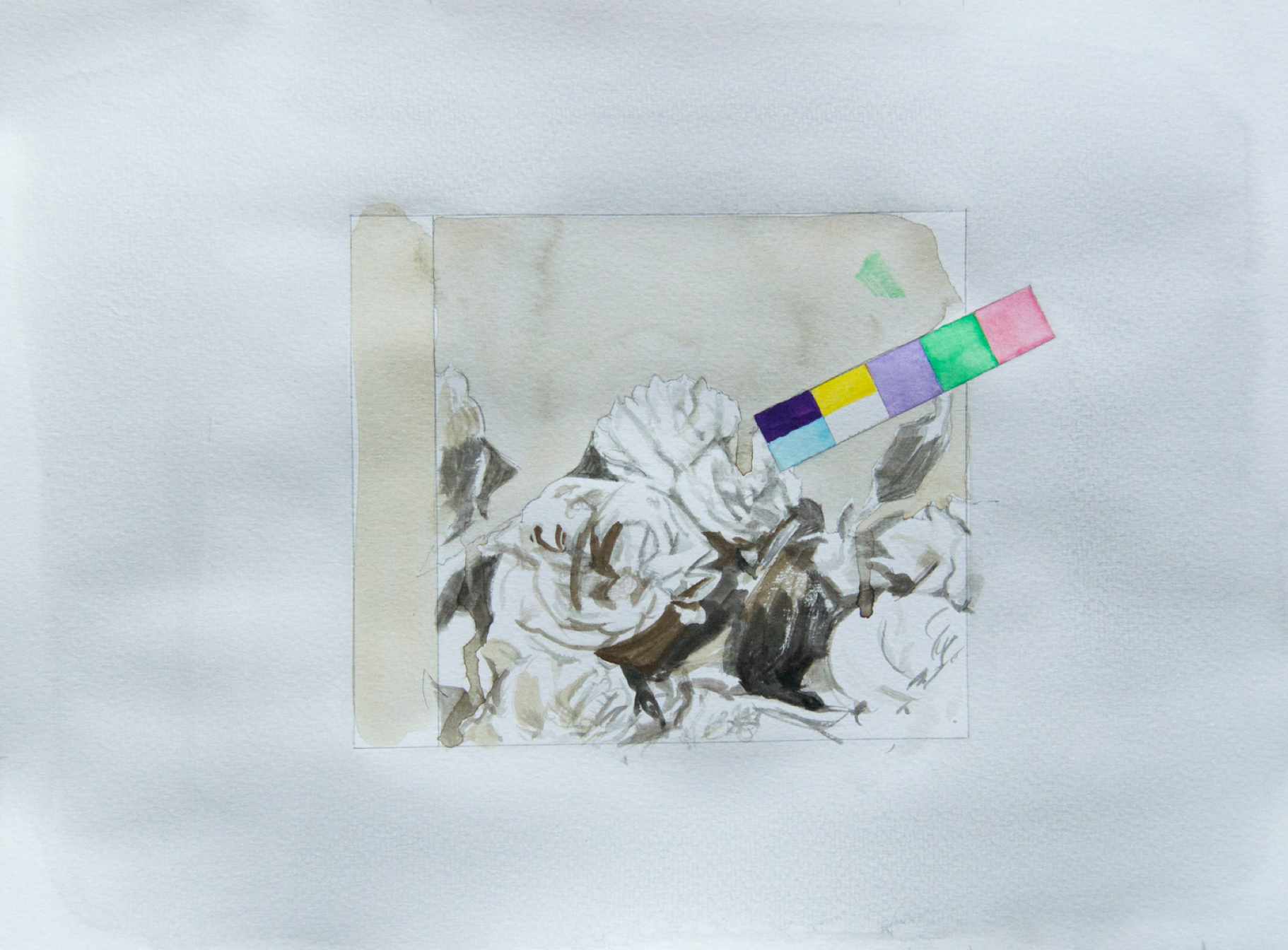
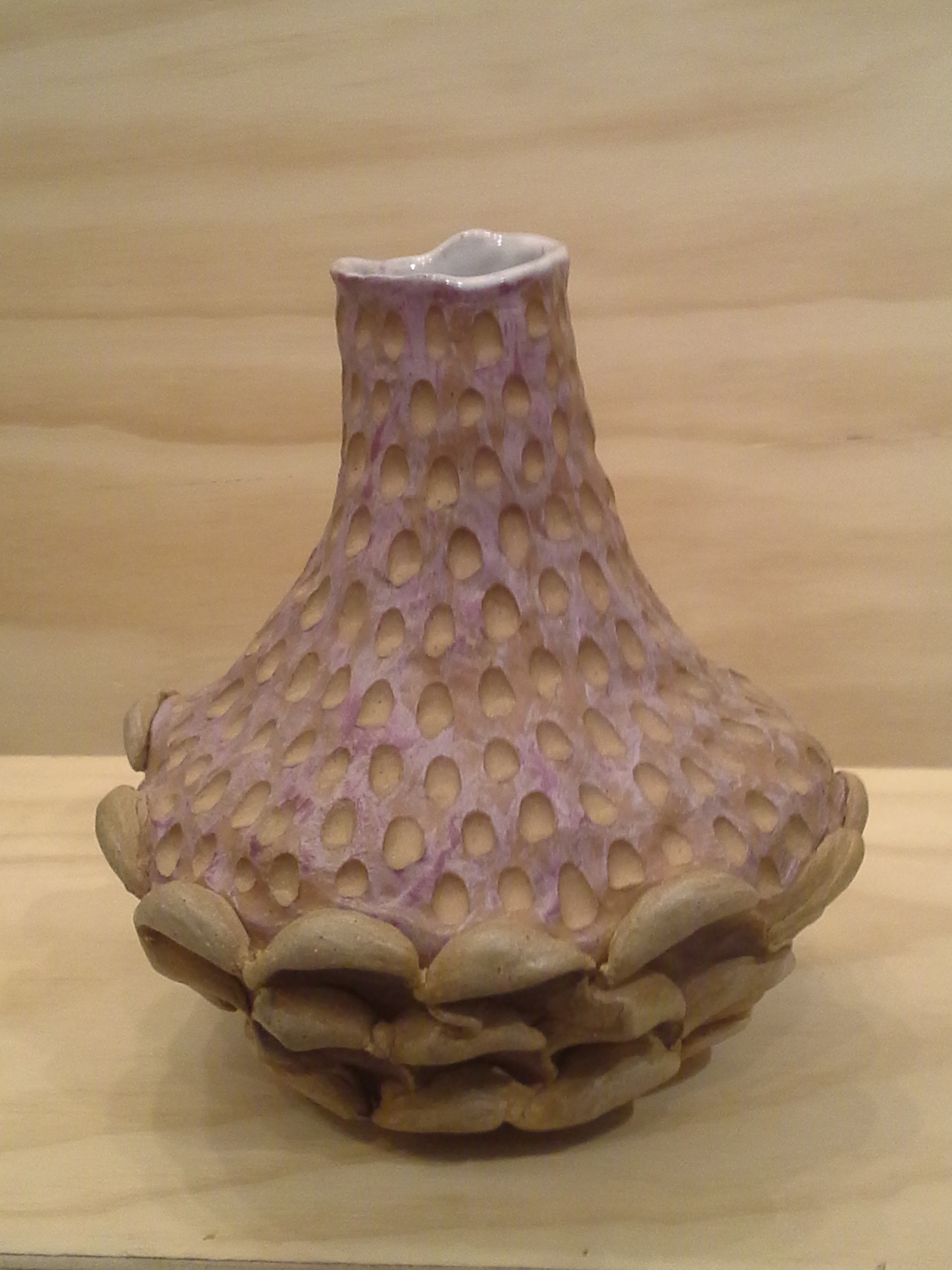
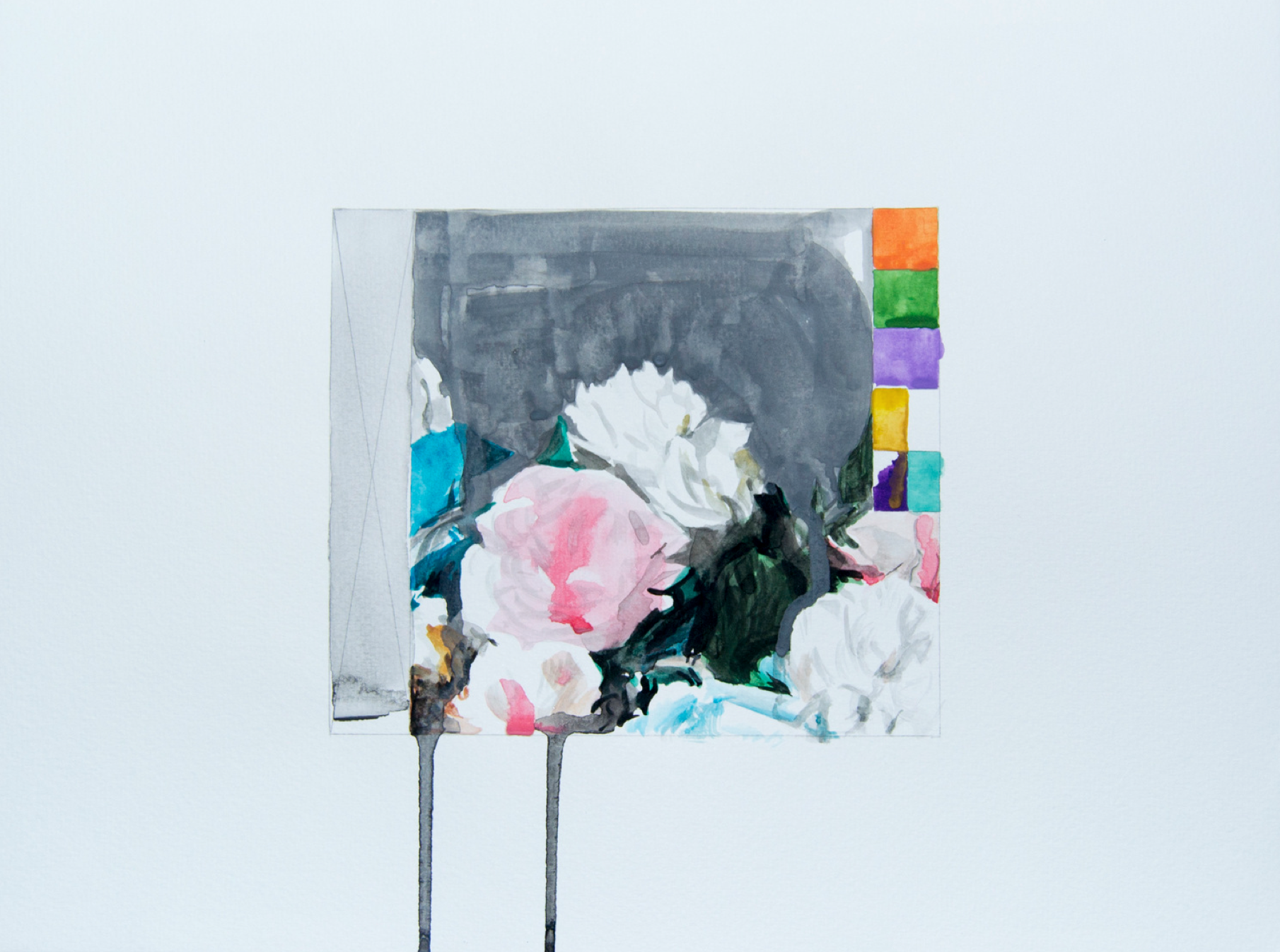
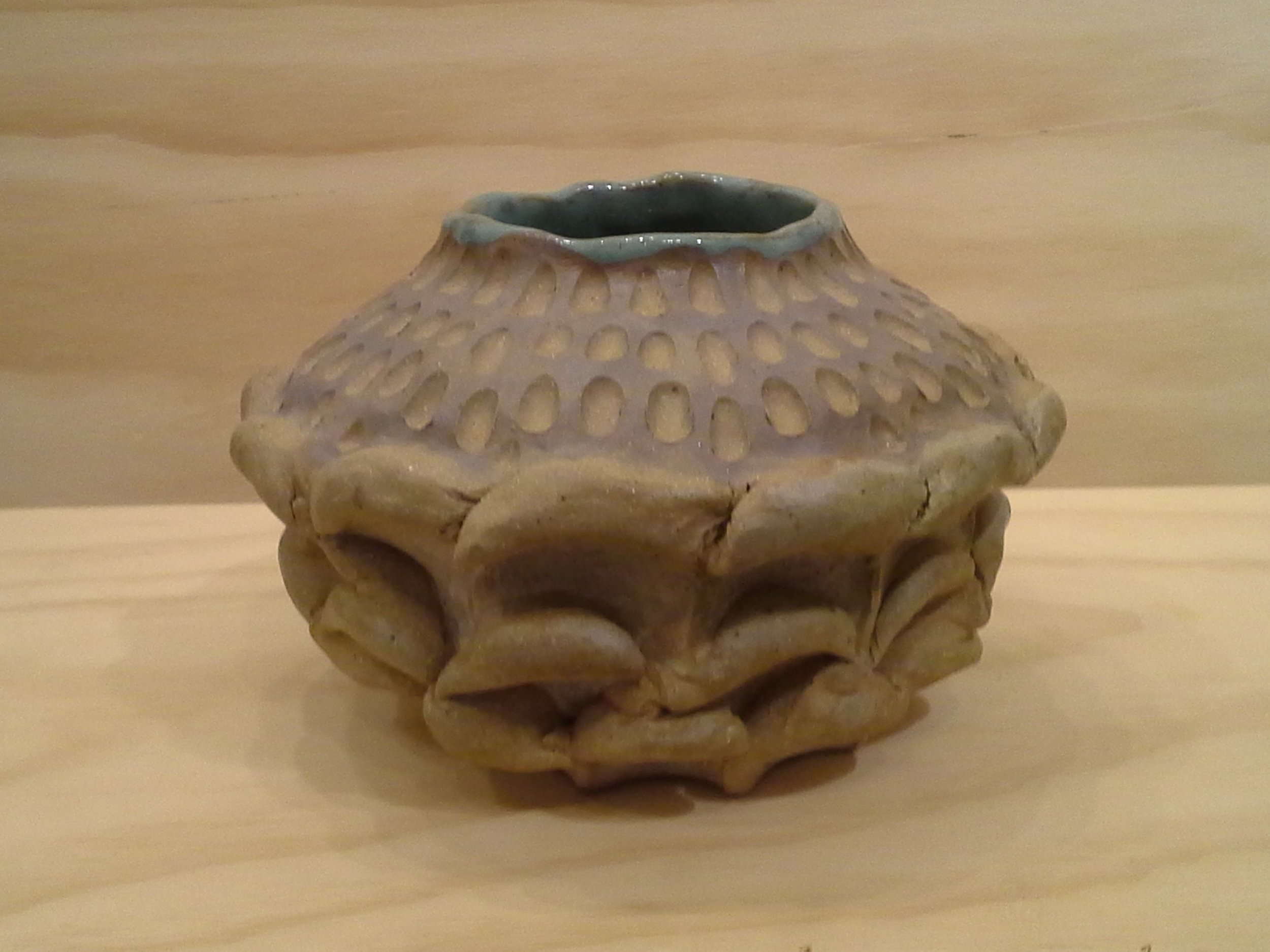
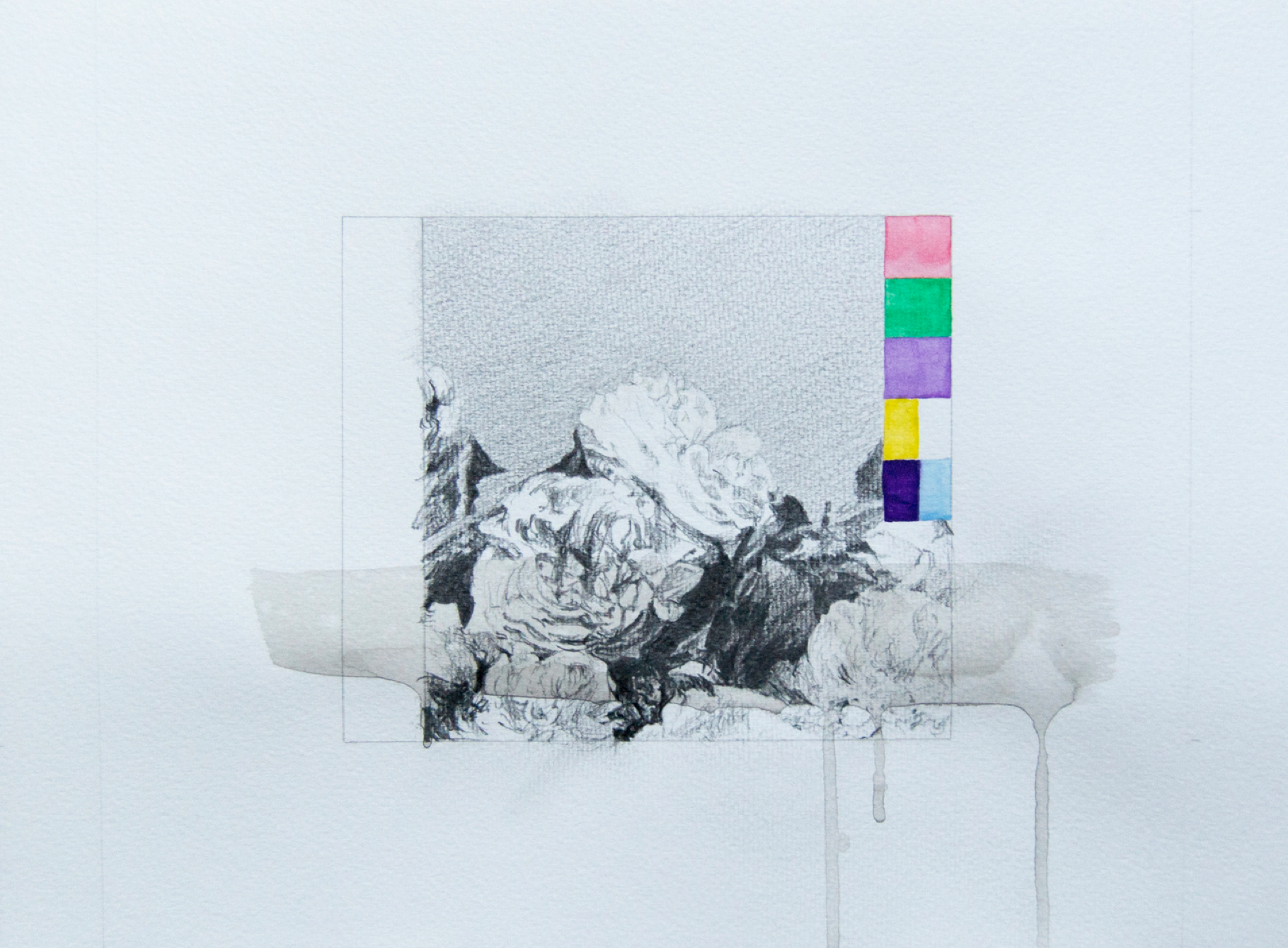

Vases by Lisa Schilling | Watercolors by Eric LoPresti
Fernanda Feher’s paintings, drawings and collages are intimate and surreal. Maybe they are surreal because they are intimate – and reach deep into her most fantastical memories. The nomadic life – from São Paulo, to New York, to Lisbon – has given her enough ingredients to fill in the blanks of solitude with creatures great and small: pink monsters, large fishes, bees, snakes or a cat.
What brings extra magic to her whimsical compositions is the sense that we are always safe in her imagination. Sometimes we are in nature, where the foliage is sultry and the snakes and other animals are enchanting. Sometimes we feel at home, protected by the walls of architecture, such as in Matisse’s paintings. It is a peculiar visual sensibility, but inviting not frightening.
Her imagery is, in a way, handed down. Feher is the grandaughter of Lily Sverner, a surrealist photographer, born in Belgium, and raised in Brazil after fleeing the Nazis. Reflecting on her grandmother’s recent passing she asked herself “Why do some people stand tall in our memory and some just fade?”.
While describing her work, Feher pinpoints the notion that nothing is permanent, nothing belongs to us, and there is no right or wrong way to go. This fearlessness bleeds through her images and touches our hearts. Just watch her be.
* Fernanda Feher (b.1988) was born in São Paulo, Brazil and currently lives
and works in Lisbon, Portugal. She attented classes at the Arts Students League of New York and graduated with a BFA from Pratt Institute.
